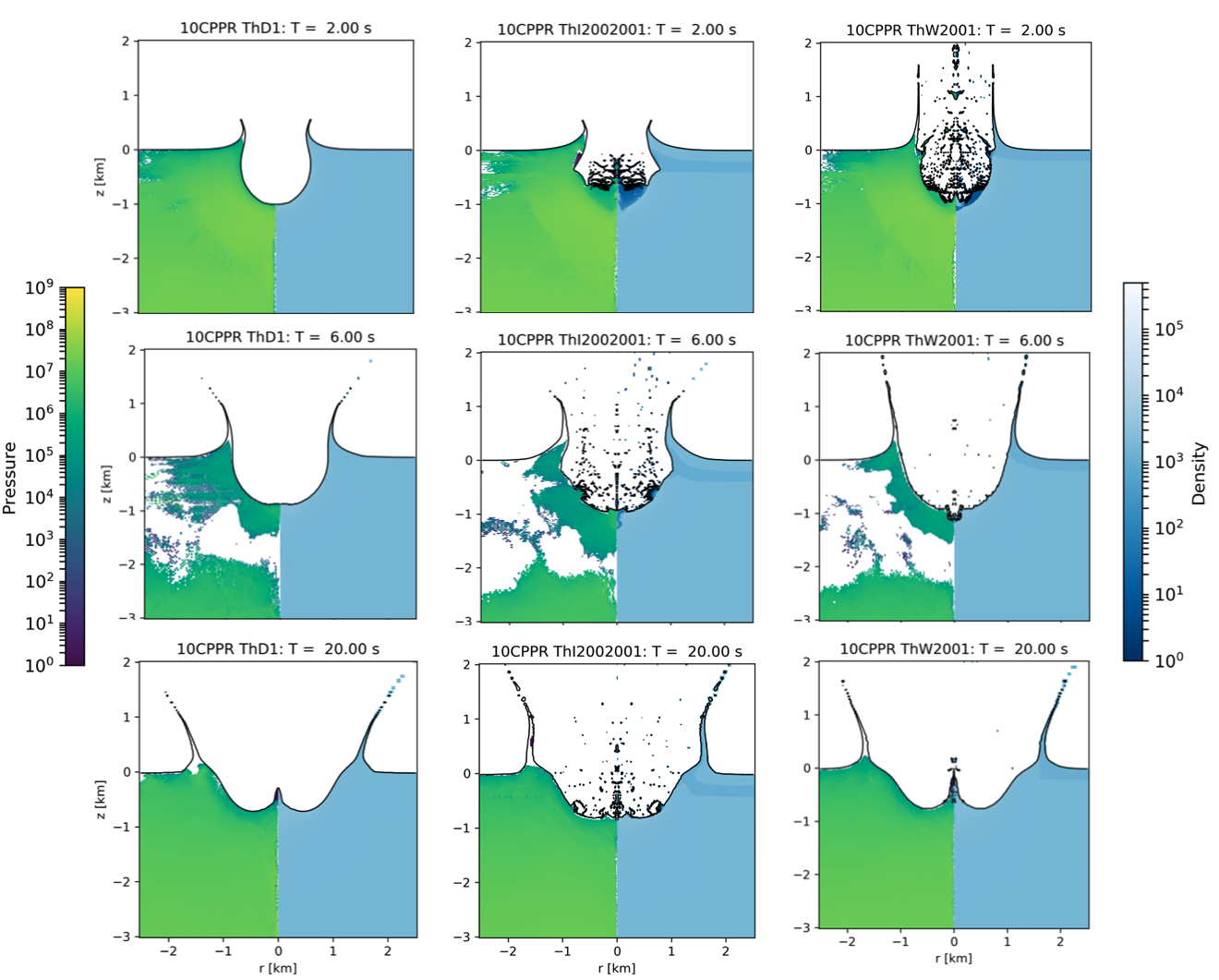TP14
Session assets
Orals: Fri, 23 Sep, 15:30–18:30 | Room Machado
Introduction. Images obtained by the optical navigation camera (ONC) onboard Hayabusa2 have revealed nearly one hundred craters on the surface of asteroid Ryugu and have been estimated to of impact origin [1,2,3]. In this study, we review our recent findings about craters on asteroid Ryugu and discuss about implications for DART and Hera missions.
Gravity-regime cratering scaling. Although we expected to find craters on Ryugu because of the past finding of crater candidates on similarly small asteroid Itokawa [4], we did not expect craters possessing classic morphologies, such as circular shape, raised rim, and wall slumping, which are consistent with gravity-controlled formation [1]. This gravity-controlled crater formation on Ryugu was confirmed unambiguously by the artificial impact experiment by small carryon impact (SCI) including uninterrupted imaging of excavation and deposition processes of impact ejecta [5], allowing us to estimate crater-projectile size relation using gravity-regime crater scaling for coarse-grain targets [6]. This led to crater retention age estimation on different geologic units on Ryugu, which helps us understand the evolution of Ryugu. Morota et al. [2] inferred that asteroid Ryugu may have experienced sunward orbital excursion after leaving the asteroid main belt and before arrival at the current orbit based on the distinct bimodal color distribution and crater size frequency distribution (CSFD) of craters on Ryugu.
Depth-age relation and cross examination with sample analyses. Further analysis of CSFD on Ryugu yielded a relation between crater retention age as a function of surface layer depth [7], which indicate that crater retention age increases rapidly from ~0.4 Myr at 1 m of depth to 3 Myr at 2 m when the recent impactor population in near-Earth asteroids (NEAs) by [8] is used. Preliminary 21Ne measurement results from Ryugu samples indicate that comic-ray exposure (CRE) ages are ~5 Myr [9]. Although the shielding depth for cosmic rays for these samples may be relatively large (1 to 2 m) owing to the low density (1.19 g/cc) of Ryugu, the sample CRE ages are older than the crater counting estimates for these depths. Because of the great uncertainty in model parameters for crater retention age for asteroid Ryugu, the fact that CRE age and crater retention age agree within a factor of ~10 is significant. However, a more important point may be that this rough agreement occur only when NEA population is used for impactors. If crater retention age is estimated with main-belt asteroids (MBAs) populations, crater retention age would be much younger (~1 kyr), greatly deviating from the observed CRE ages. This suggests that Ryugu may have stayed in an orbit collisionally decoupled from MBA after leaving the main belt. A decisive conclusion would need more data from both sample analysis and image analysis, but this discussion clearly demonstrates that comparison between CRE ages and crater chronology is extremely important.
Comparison with asteroid Bennu and outlook for Dimorphos and Didymos craters. One thing we should look at before applying observation results on Ryugu craters to DART and Hera observations is comparison with craters on asteroid Bennu. Although Ryugu and Bennu are very similar in general morphologic properties of craters, there are significant differences. One is depth/diameter (d/D) ratio dependence on crater diameter D. The d/D ratio increases with crater diameter D on Ryugu but decrease on Bennu [10,11]. This contrasting difference may reflect different subsurface mechanical structures on these two asteroids. In fact, Ryugu has evidence for regional to global mass motion (i.e., equator to mid latitude mass wasting) [1,2] and Bennu exhibits evidence for more local mass wasting [12,13]. Such different styles of mass motion may be related to difference in d/D ratios on Ryugu and Bennu.
Another difference is the gap between crater retention times between craters on regolith and boulder surfaces on the two asteroids. Although crater number density on regolith are similar to each other within the factor of three [7], those of “mini-craters” on boulder surfaces are very different. Bennu has about 30 time more intra-boulder mini-craters than Ryugu [14,15].
The fact that these similar C-complex asteroids exhibit such substantial differences on craters suggests that Dimorphos, whose materialistic and dynamical properties are very different from Ryugu and Bennu, will show us very interesting new aspects of cratering on small bodies via DART and Hera missions [16,17].
References:
[1] Sugita et al. (2019) Science, 364, aaw0422
[2] Morota et al., (2020) Science, 368, 654–659
[3] Cho et al. (2021) JGR Planet 126 e2020JE006572.
[4] Hirata et al. (2009) Icarus, 200, 486-502.
[5] Arawaka et al. (2020) Science, 368, 67–71.
[6] Tatsumi and Sugita (2018) Icarus, 300, 227–248.
[7] Takaki et al., 2021 Icarus 114911.
[8] Haris and D’Abramo (2015) Icarus 257, 302-312.
[9] Okazaki et al. (2022) LPSC #1348.
[10] Noguchi et al. (2021) Icarus, 354, 114016.
[11] Daly et al. (2022) Icarus, 115058.
[12] Walsh et al. (2019) Nature Geoscience, 12, 242–246.
[13] Jawin et al. (2021) JGR-Planets, 125, e2020JE006475.
[14] Ballouz et al. (2020) Nature, 587, 205-209.
[15] Takai et al. (2021) LPSC, #2548.
[16] Cheng et al. (2018) PSS, 157, 104-115.
[17] Michel et al. (2022) PSJ, in press.
How to cite: Sugita, S.: Properties of natural and artificial craters on asteroid (162173) Ryugu revealed by remote-sensing observations and sample analyses, Europlanet Science Congress 2022, Granada, Spain, 18–23 Sep 2022, EPSC2022-195, https://doi.org/10.5194/epsc2022-195, 2022.
Introduction: Asteroids smaller than about 50 km in diameter are the result of the break-up of a larger parent body [1]. They are often considered to be rubble-pile objects, aggregates held together only by self-gravity or small cohesive forces [2, 3], and have highly heterogeneous surfaces. Recently, the artificial impact experiment (SCI) of JAXA’s Hayabusa2 mission on the surface of asteroid Ryugu [4] created a relatively large crater (~14 m diameter) despite the presence of large boulders close to the impact location [5].
Post-impact images of the SCI impact site revealed that the boulders had different motion mechanisms depending on their size and initial position relative to the impact point. 1 m-sized boulders were ejected several metres outside of the crater, a 5 m boulder was moved about 3m, while a large, possibly deeply rooted boulder (“Okamoto”) was not moved [4]. Impact cratering on weak, heterogeneous targets is still poorly studied, both by means of laboratory experiments and numerical simulations. For example, it is not yet known how the boulders affect the crater size or how the boulders motion is affected by their mass, size, shape or initial location.
This is also important in context of NASA’s Double Asteroid Redirection Test (DART) impact on the surface of Dimorphos (the secondary of the 65803 Didymos asteroid system) on the 26th of September 2022. The impact will demonstrate the controlled deflection capabilities of near-Earth asteroids by a kinetic impactor [6]. ESA’s Hera mission [7] will arrive at Dimorphos several years after the DART impact and provide a detailed characterisation of the impact outcome.
Recent impact experiments and numerical studies [8, 9, 10, 11] have shown that the kinetic impact efficiency depends strongly on the target properties and structure. The understanding thereof is imperative for a successful interpretation of the DART impact outcome. Most previous impact experiments and subsequent validation work of numerical models have focused on homogeneous targets [e.g, 12, 13, 14]. However, it is unlikely that Dimorphos is homogeneous at the scale of DART impact.
In our previous work we studied impacts into granular targets with embedded porous, spherical boulders and their effect on cratering process, final crater morphology, boulder emplacement, and ejecta distribution [15, 16]. We showed that crater diameters are only slightly affected by heterogeneities as long as the energy required for crushing is small compared to impact energy. However, less mass is ejected at higher velocities compared to homogeneous targets, which reduces the momentum enhancement.
In this study we present results from recently conducted experiments at the Experimental Projectile Impact Chamber (EPIC) at Centro de Astrobiología CSIC-INTA, Spain, which focused on the motion mechanism of large boulders placed close to the impact site (Fig. 1). We also study the effect of density and surface roughness of boulders located on the target surface on their mobilisation and ejection, as well as on the excavation flow and ejection of fine-grained matrix.
Methods: The EPIC utilises a 20 mm calibre compressed N2 (300 bar) cannon that launches projectiles at velocities up to ≈420 m/s [13]. The experiments, half- or quarter-space, can be recorded with two high-speed cameras. In the three experiments presented here we have kept the impact velocity constant at approximately 400m/s. The projectiles were 20mm massive, spherical delrin balls. All shots were vertical and in half space.
We performed three shots into a loosely packed beach sand in which a single, relatively large rectangular boulder was placed (Fig. 1). Coloured sand on the surface allows studies of ejecta distribution. In the first shot (Scenario 1) the boulder had relatively high bulk density (quartzite, ~ 2.8 g/cm3), in the second shot (Scenario 2) the boulder had relatively low density (highly porous pumice, ~ 0.27 g/cm3) and a glossy surface (the boulder was covered in a plastic film). In the last shot (Scenario 3) the same object was used, but now the glossy plastic film had been removed revealing a rough, high-friction surface (Fig. 1A). In all experiments the point of impact was located as shown in Figure 1B.
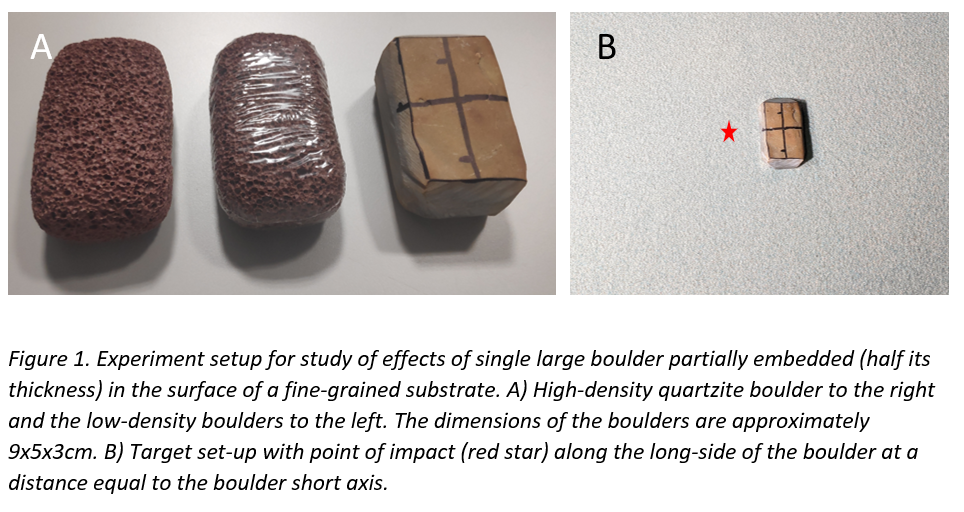
Results and discussion: We observe a significant difference in the ejection behaviour between the cases with boulders of different mass. In Scenario 1, the boulder was moved a few cm by the excavation flow and deposited at the crater rim. The ejecta curtain passes around the boulder, creating a “forbidden zone” behind the boulder (Fig. 2A). Similar ejecta behaviour was seen during the SCI impact around the Okamoto boulder [4].
In Scenarios 2 and 3, the boulder was excavated with the ejecta curtain, rotated around its length axis, and landed about one crater diameter away from the crater. The ejecta curtain was again disrupted by the presence of the boulder (Fig. 2 B, C). The final rim-diameter of the crater produced in Scenario 1 was 27cm and in the other two scenarios 29 cm, suggesting that the presence of a dense (i.e., mainly stationary) boulder close to the impact point does not greatly affect the crater size. However, we can clearly see a significant influence of the boulder on the ejecta curtain behaviour. The dense boulder efficiently block the ejecta while the low-density boulders to great extent travel with the ejecta mainly affecting the distal parts of the continuous ejecta layer. The surface roughness had no obvious effect on boulder movement.
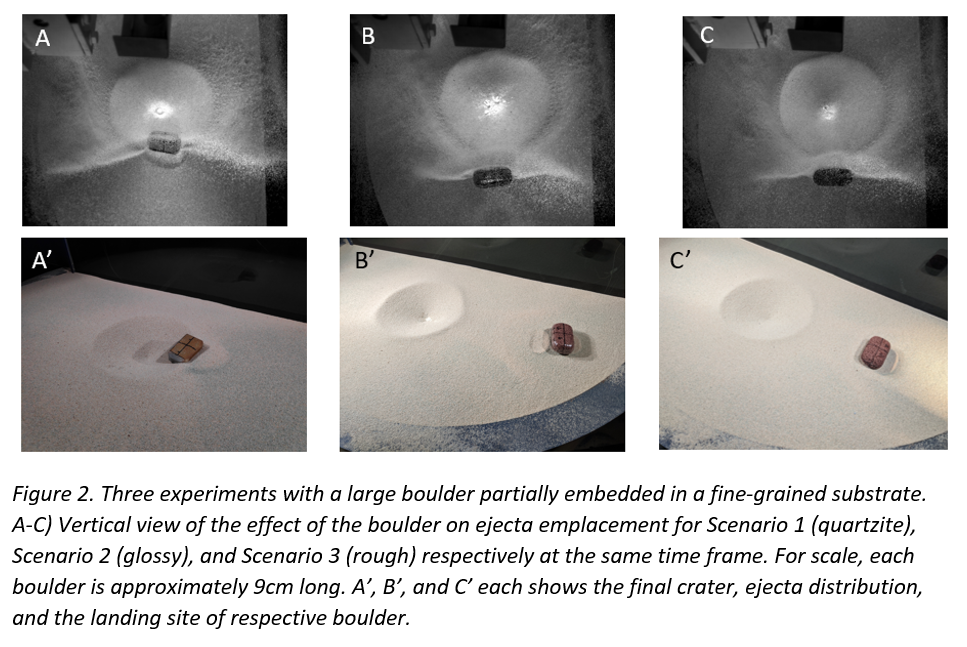
Conclusions and future work: Here we continue our study of impacts into heterogeneous targets (The first study was presented at EPSC2021 [15]) and work towards understanding the importance of target heterogeneities in the cratering process and impact momentum transfer. Numerical simulations reproducing these impact experiments are underway and preliminary results from the early cratering process show good agreement with the experiments. These results and further numerical studies are vital for understanding cratering processes on rubble-pile asteroids and will help interpret results from the DART impact and its imaged ejecta plume.
How to cite: Ormö, J., Raducan, S. D., Luther, R., Jutzi, M., Herreros, M. I., Collins, G., Wünnemann, K., and Mauri, V.: Impact Induced Motion of Boulders and Their Effect on Ejecta Emplacement on Rubble-pile Targets, Europlanet Science Congress 2022, Granada, Spain, 18–23 Sep 2022, EPSC2022-131, https://doi.org/10.5194/epsc2022-131, 2022.
Introduction: The Toolbox for Research and Exploration (TREX) is a NASA SSERVI (Solar System Exploration Research Virtual Institute) node. TREX (trex.psi.edu) aims to develop tools and research methods for the exploration of airless bodies, specifically the Moon, the Martian moons, and near-Earth asteroids. TREX studies are organized into four Themes: (1) Laboratory studies, (2) Lunar studies, (3) Small bodies studies, and (4) Field work. The work presented here is part of Theme 3: Investigations of fine-grained materials on the surface of small bodies.
Background: Reflectance spectroscopy is a widely used technique to study planetary bodies in our solar system, partly because its ability to identify compositional characteristics via remote sensing [1]. It has been shown that reflectance spectra of minerals on the surface of airless bodies can exhibit differences in their spectral characteristics, when compared to laboratory measurements of their Earth analogs [2]. This is because minerals exposed to the interplanetary environment are constantly subject to particle and electromagnetic radiation, and micrometeorite bombardment, which gradually alter their chemical and physical properties, a process called space weathering. To accurately interpret reflectance spectra from remote observations, it is key to fully understand how space weathering alters the spectral characteristics of minerals.
Laboratory studies are a powerful tool to simulate space-weathering-like processes and unravel the fate of minerals exposed to space-like radiation and micrometeorite impact environments. Such studies give access to additional characterization environments that can further our understanding of micrometeorite- and radiation-material interactions. In this work, we conduct ion irradiation experiments to evaluate the evolution of minerals exposed to a solar wind-like environment
Methods: For this work, olivine grains were ground into loose powders (<25 µm) to generate regolith-like samples. The powders were produced in a glovebox under a nitrogen environment (water and oxygen content <1 ppm). This procedure enabled us to generate olivine grains with fresh faces that were not previously exposed to air. The prepared samples were transferred to IGNIS (Ion-Gas-Neutrals Interactions with Surfaces) –a vacuum irradiation and characterization facility– in a portable sample capsule [3]. Throughout the experiment, from the sample preparation, to transport, irradiation, and characterization, the samples were never exposed to air, preventing any alterations due to interactions with the atmosphere.
In IGNIS, the olivine loose powders were exposed to ion beams to simulate mineral exposure to solar wind ions. The irradiations were performed using hydrogen and argon ions, at fluences up to 1x1018 ions cm-2. X-ray photoelectron spectroscopy (XPS) and reflectance spectroscopy were performed in situ to assess the influence of ion bombardment on the surface chemistry and the reflectance spectra characteristics. By performing sample characterization in situ, the evolution of the surfaces under ion bombardment was tracked with high fidelity, by minimizing the influence of air exposure on the sample’s characteristics.
Preliminary results: Olivine powders irradiated with 1 keV argon ions, to a fluence of 1x1017 ions cm-2 exhibit a clear alteration of their optical properties. A darkening of the sample was evident by direct inspection of the powders before and after irradiation (Figure 1). The irradiation was carried out in steps; XPS and reflectance spectra were collected between steps, at 1x1016, 2x1016, 5x1016 and 1x1017 ions cm-2. The collected reflectance spectra show a darkening trend of the olivine samples with increasing irradiation fluence (Figure 2). The change in the albedo of the olivine powders with increasing fluence exhibited a wavelength dependence, with a more pronounced darkening towards the UV. The depth of the absorption band at 1.05 µm, characteristic of olivine spectra, were also altered with the ion irradiation.
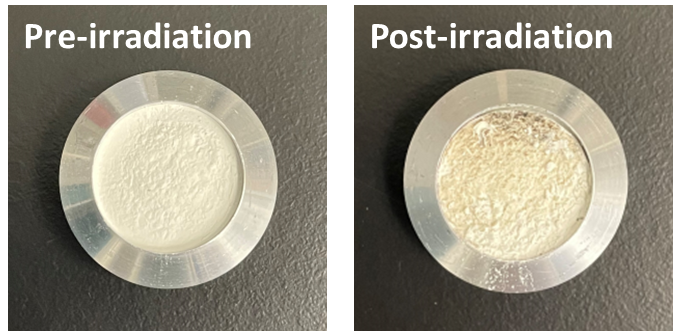
Figure 1. Darkening of olivine powders observed after 1 keV Ar+ irradiation with a dose of 1017ions cm-2
Figure 2 Ultraviolet-visible reflectance spectra of olivine powders irradiated with 1 keV Ar+. The sample darkening is evident by the overall decreased reflectance.
References: [1] Cloutis, E.A., et al. (2018) Primitive Meteorites and Asteroids: Physical, Chemical, and Spectroscopic Observations Paving the Way to Exploration, Elsevier, 273-343. [2] Adams, J.B. and Jones, R.L. (1970) Science, 737-739. [4] Jaramillo, C. et al. (2021) AGU Fall meeting, P11A-06
How to cite: Jaramillo-Correa, C., Clark, R. N., Domingue, D. L., Pearson, N., Savin, D. W., Vilas, F., Allain, J. P., and Hendrix, A. R.: Reproducing space weathering on olivine via ion irradiation, Europlanet Science Congress 2022, Granada, Spain, 18–23 Sep 2022, EPSC2022-735, https://doi.org/10.5194/epsc2022-735, 2022.
Introduction: Mercury’s surface is exposed to a multitude of surface altering effects that have a significant influence on its optical properties. Impact events – small or large, are one of the major surface-altering agents. Inferred from hypothetical modal abundances[1] graphite can comprise up to 4wt% on Mercury’s surface. Graphite as a possible stable phase on Mercury can explain the relatively low albedo of the planet[2]. Our experimental setup probes the hypothetical impact into a graphite- and olivine–bearing, pyroxene-rich (Px(En87)=68wt%;Ol(Fo91)=29wt%,C=3wt%) surface. The effect of post-shock heating and pressure on a powder comprised of silicates with grain sizes ≤125 µm and graphite(hexagonal) was simulated in a classic shock recovery experiment[3]. The experiments were performed in the framework of the BepiColombo mission to Mercury. The onboard Mercury Radiometer and Thermal Infrared Spectrometer (MERTIS) will send thermal emissivity data once it reaches the Hermean orbit in 2025. A spectral database for mid infrared data is currently set up at the Institut für Planetologie in Münster. Published mid infrared data will soon be available and sample related spectral information of interest can be traced via assigned IDs (e.g., IDxxx).
Experimental set-up and µ-FTIR: One aliquot of the prepared powder mixture served as a blank(ID467) and was not shocked, the second (ID464) aliquot was filled into an ARMCO-Fe container. The cavity (ø=16mm;depth=2mm) that held the powder was lined with tantalum foil (thickness=50 µm) in order to avoid Fe0-metal contamination from the container. Graphite foil particles vary in size (mean=500µm). The foil was cut with a razor to avoid smearing. The calculated peak pressure at the steel/sample interface reached ca. 60 GPa. Pore space was crushed upon impact and contributed to increase the post-shock temperature significantly[4]. Preliminary spectral results were obtained with a Bruker Hyperion 3000. Spectra were measured in reflectance between 3950cm-1-700cm-1. Reflectivity was calculated by measuring a gold standard equaling the sample’s surface roughness. We used a 100x100 µm2 knife edge aperture to limit obtained spectral data from defined regions of interest (ROIs) and integrated over 256 scans to improve the signal/noise ratio.
Preliminary spectral results were obtained from both aliquots, ID467 and ID464. ID464 material was extracted from the steel container, from which spectral information were obtained (Fig.1bottom) and are compared to spectral data of the unshocked aliquot (Fig.1top).
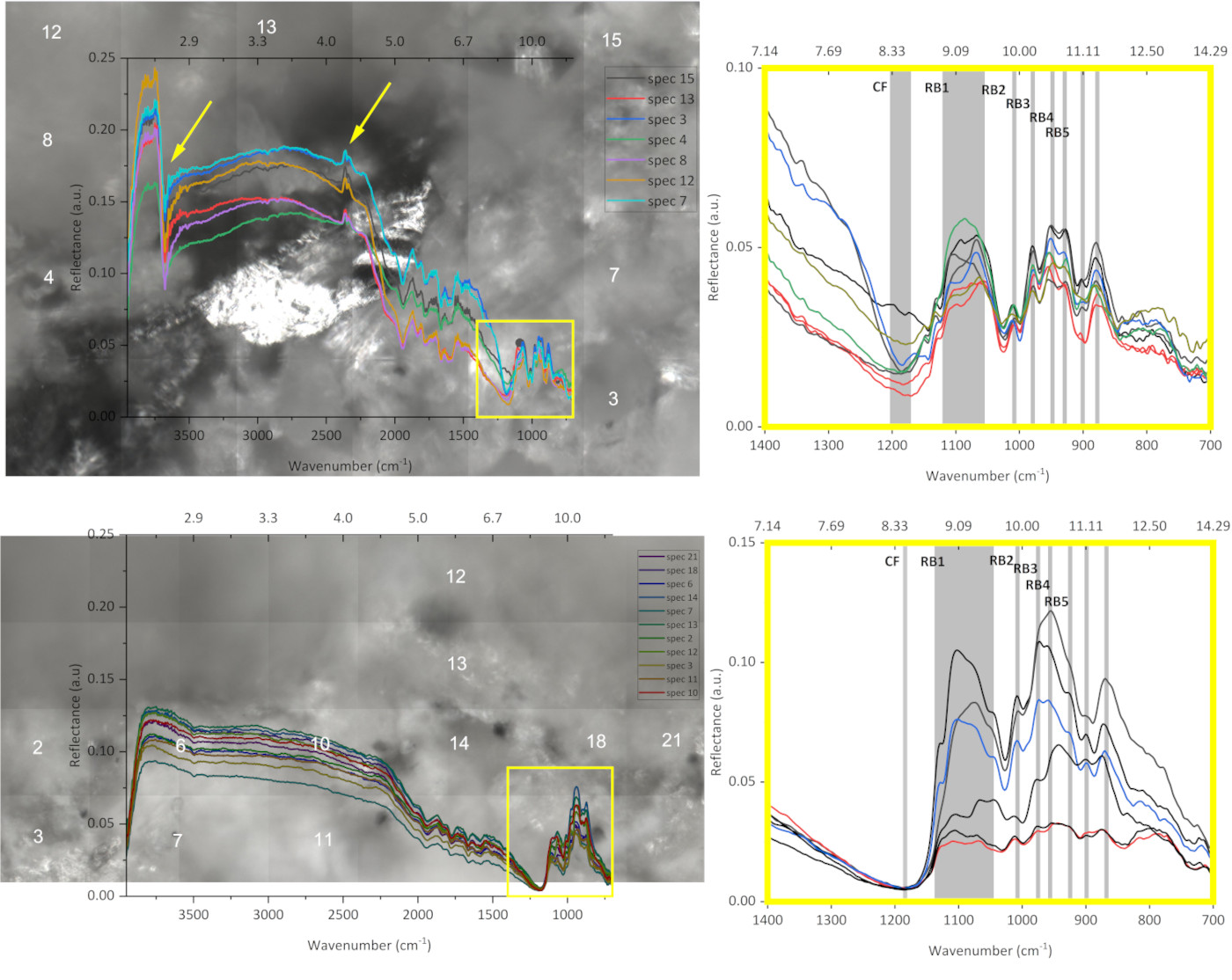
Figure 1 top&bottom: ID467 spectra(top). Graphite (bright material) embedded in light grey silicate matrix. Areas with indices in micrograph correlate with spectra of same numbering. Yellow highlighted rectangles are magnified for clarity, RBs are labelled and discussed in text. ID464 spectra are plotted below. Pyroxene is dominant in both aliquots. The CF is located at 1187cm-1 in ID464. Both aliquots show comparable reflectance intensities. Yellow arrows denote CO2-related adsorption in ID467.
Results and discussion: We observed a dark pumice-like mass protruding perpendicular to the shockwave propagation direction. The center part of the sample shows a glassy luster (e.g.,Fig.2) which is indicative of melt formation.
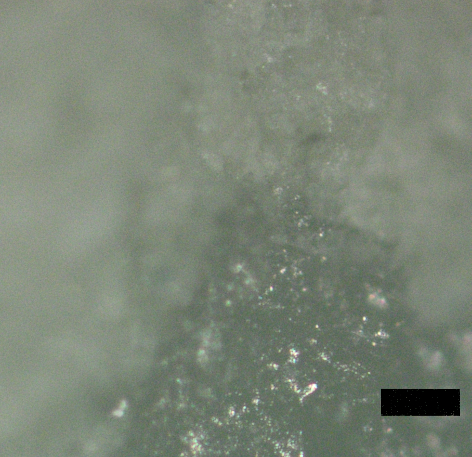
Figure 2: Light microscope image of graphite (dark) embedded in “fluffy”glassy matrix (arrow). Scale bar is 100 µm.
ID464 compacted entirely during impact and shows a clearly distinguishable Christiansen feature (CF; a material characteristic reflectance minimum) at 1187cm-1 (similar to CF(En87)=1193cm-1. The CF of ID467 is difficult to determine. The shallowing of the adsorbed CO2-related absorption band[5] at 3677cm-1 steepens the slope towards shorter wavenumbers. Glassy material was identified in many areas. However, crystalline pyroxene surviving the impact is easily distinguished in the electromagnetic range between 1187cm-1-700cm-1, where vibrational normalmodes/or Reststrahlenbands (RBs) of silicates typically occur. RB1 of ID464 (see Fig. 1 bottom) has a shoulder at 1131cm-1, a double peak at 1103cm-1 and 1074cm-1, and another shoulder at 1043cm-1. RBs of both silicate starting materials occur in this range (En87 at 1131cm-1,1107cm-1,and 1056cm-1, and Fo91 at 1063cm-1and 1056cm-1). The envelope of the RB1 region is identical in ID464 and 467, however, a shoulder peak at 1043cm-1 missing in the unshocked, appears in the shocked aliquot and broadens the base of RB1. Pure En87 has a remarkably invariant(energy-wise) RB at 1010cm-1 (ID467) that shifted to 1006cm-1 in ID464. RB3 of the Mg-pyroxene typical “triplet-RBs” (RB3, RB4, RB5 in Fig. 1 top) at 979cm-1 is similarly invariant, however, olivine has a stable RB nearby, at 981cm-1[6]. This band is shifted to a weak shoulder at 973cm-1, either indicating the absence of olivine due to melt formation, or a shock related shift of the En87-associated RB3. Augmenting chemical analyses will help to disambiguate this. Silicate material in direct contact with graphite displays a foam like texture (Fig. 2). Graphite is an excellent thermal conductor. Silicates and graphite have a large density gradient, when shock waves traverse the individual phases, graphite-grains experience significantly higher post-shock temperatures, and thus help in melting the silicate fraction[7]. Shock-related “pumice” pressed toward the outer cylinder margins is dark and has large, entrained cavities. Future chemical and µ-FTIR analyses of the entire ID464 will improve our understanding of how graphite though chemically inert “catalyzes” processes that either not/or insufficiently take place in its absence.
This work was funded by the DLR grants 50 QW 1701 and 50 QW 2201A. MERTIS group are A.N.S,A.M,H.H.,I.W.,M.P.R,K.E.B.,J.H.P.,J.H.
The authors thank U.Heitmann, F.Spaleck, P.Pelka and M.Artmeier for careful sample and cylinder preparation
References: [1] Vander Kaaden & McCubbin (2015), JGR: Planets, 120(2), 195-209 [2] Klima et al. (2018). Geophysical Research Letters, 45(7), 2945-2953. [3] Langenhorst & Deutsch (1994) EPSL, 125(1-4), 407-420. [4] Güldemeister et al. (2013) Meteoritics & Planetary Science, 48(1), 115-133 [5] Bianchi et al. (1994) Applied Catalysis A: General, 112(2), 219-235. [6] Stojic et al. (2021) Icarus, 357, 114162. [7] Moreau & Schwinger (2021) Physics of the Earth and Planetary Interiors, 310, 106630.
How to cite: Stojic, A. N., Moreau, J.-G., Kohout, T., Penttilä, A., Morlok, A., Weber, I., Reitze, M. P., Hiesinger, H., Schmedemann, N., Joeleht, A., Bauch, K. E., Pasckert, J.-H., and Helbert, J.: Impact into a regolith: A shock recovery study of a graphite-bearing surface, Europlanet Science Congress 2022, Granada, Spain, 18–23 Sep 2022, EPSC2022-813, https://doi.org/10.5194/epsc2022-813, 2022.
1. Introduction
Impact melt rocks are the only lunar sample material that allows for absolute dating of impact events. Therefore, these samples are key to unveiling the early bombardment history of the Moon. However, due to the mixing of melt products ejected from distant craters, the interpretations of lunar samples are difficult [1]. Here, we use the iSALE2D shock physics code to quantify the production of impact-induced melt and especially its distribution in ejecta blankets for lunar craters of intermediate size (1.5 – 50 km in diameter).
2. Methods
We carried out a suite of iSALE simulations with varying projectiles diameter from 100 m to 3 km. We use an analytic equation of state for basalt to describe the thermo-dynamical behavior of the lunar crust (cf. [2]). Material strength, damage, and porosity were accounted for using the models of [3], [4], and [5, 6], respectively. Due to the long-term impact fragmentations, the lunar near-surface lithologies are assumed to be porous. The presence of porosity enhances melt production [7]. We set the porosity profile following the exponential function of [8] that best matches gravity data.
To investigate melt production sufficiently high resolution in the models is required. At the same time simulations of the entire ejection process are only possible at coarser resolution. To reach a good compromise for the computational costs in terms of spatial resolution, computation time, and accuracy to quantify melt production and deposition upon ejection, we apply a 3-step approach for simulations:
Models to determine impact-induced melts. To quantify melt production, we first determine the critical shock pressure Pc where the post-shock final temperature exceeds the melt temperature as a function of porosity. Impact-induced melts are generated if the material experiences peak shock pressures (Ppeak) in excess of Pc. We use Lagrangian tracers to record Ppeak during the passage of the shock wave. The average impact velocity of 18 km/s on the Moon is kept constant. We use a high resolution of 40 cells per projectile radius (CPPR) to model the early stage of impact processes until the shock wave has attenuated below Ppeak.
Models to analyze ejecta deposit. Lagrangian tracer particles are also used to track ejected materials. Tracers are considered to be ejected when they reach the altitude of one projectile radius above the surface. We extrapolate the trajectory back to the surface and record the launch position. The cumulative number of tracers deposited at a given distance allows for determining the thickness of the ejecta blanket. In these models, the normal component of impact speed for the most likely impact on the Moon (45°) is considered (i.e., 13 km/s). Given that 10 CPPR is often sufficient to simulate crater growth [7], 10 CPPR is taken for these models, and they run until the crater reaches the maximum volume, which is assumed to be a good approximation for the transient craters when the ejection process has ceased.
Combining data of impact-induced melt and ejection. Typically, each cell in iSALE models is assigned a single tracer. For better analysis, we make the positions of tracers in 10 CPPR-models exactly the same as those in the 40 CPPR-models by putting 16 uniformly distributed tracers in each cell. To estimate melt distribution in ejecta, Ppeak of the ejected tracers derived from 10-CPPR models is revised by replacing it with that from 40-CPPR models.
3. Production of impact-induced melt
The volume of impact melt (Vm) increases exponentially with the increasing diameter of transient craters (Dt): Vm = cDtd. Our results (Figure 1) present a more gentle slope (d = 3.09; c = 2.37×10-3) than the analytical value (d = 3.8, [9]) when Dt is directly taken from iSALE models. This is partially caused by the decreasing influence of the porosity gradient with increasing projectile size and is also related to the determination of Dt. After the model-derived Dt is replaced with the scaled Dt. The results present an exponent d = 3.55 (c = 4.41×10-3).
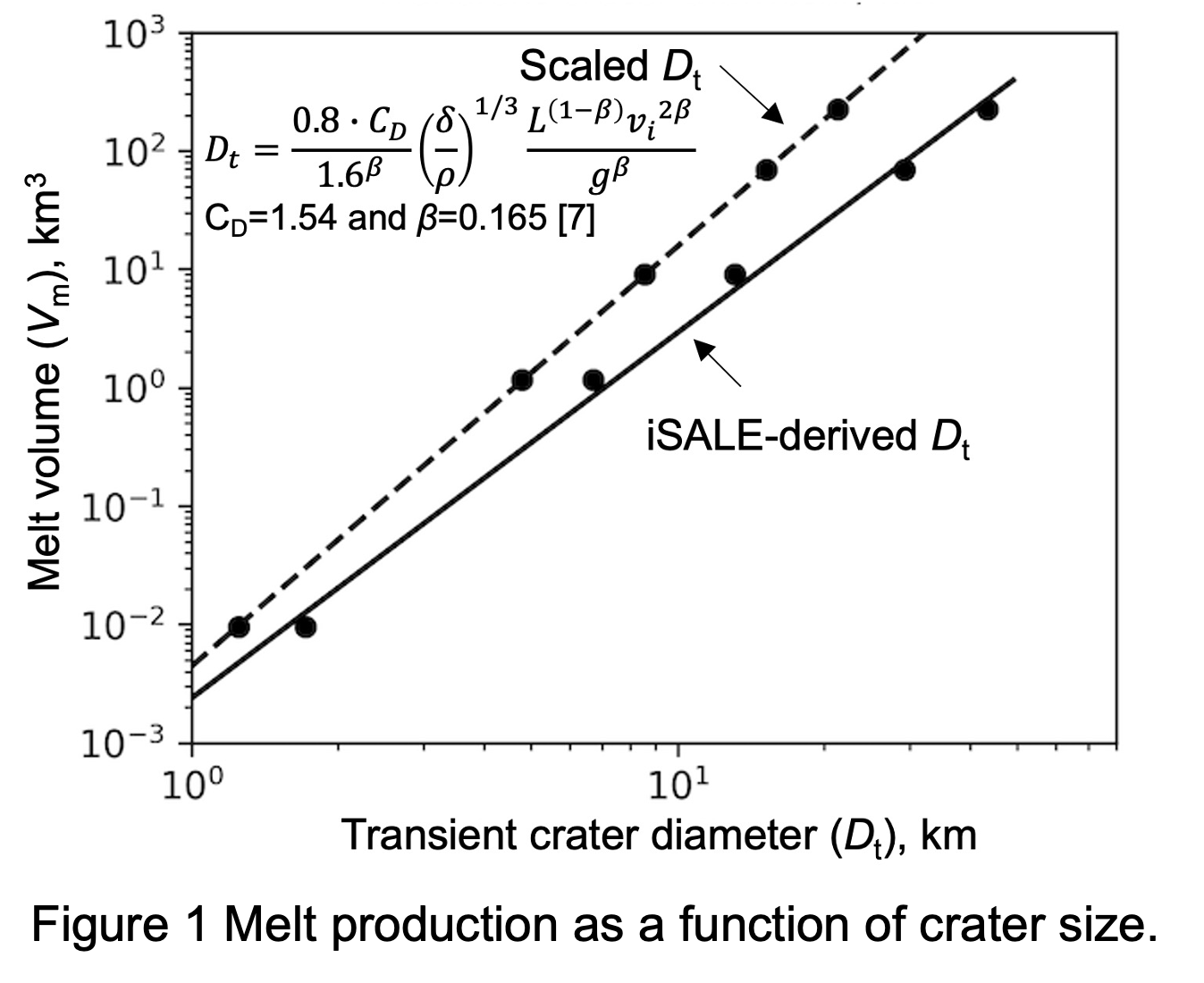
4. Ejection of impact-induced melt
A power law expression for the ejecta thickness (T) as a function of landing distance (r) was formulated: T(r)=T0(r/Rt)-B, where Rt is the transient crater radius as derived with iSALE. As shown in Figure 2, T decreases with distance according to a power-law with an exponent of ~ -3.0, which is consistent with the laboratory experiments and the observation of lunar ejecta blankets.
We calculate the thickness of a hypothetical “melt blanket” (Tm), which only consists of impact-induced melt material. We use the same way as we calculate the total thickness of the ejecta blanket, but consider only the materials that are molten. The results (Figure 2) show that Tm is also a function of landing distance following a power law: Tm(r)=Tm0(r⁄Rt)-Bm. Tm is decreasing with the distance from the crater center, but the slope of the “melt blanket” is more gentle than that of the total blanket and has an exponent of around -2.3. In addition, even though the thickness of both the ejecta and the melt blanket decreases with distance from the crater center, the concentration of impact melt in the ejecta blanket increases.
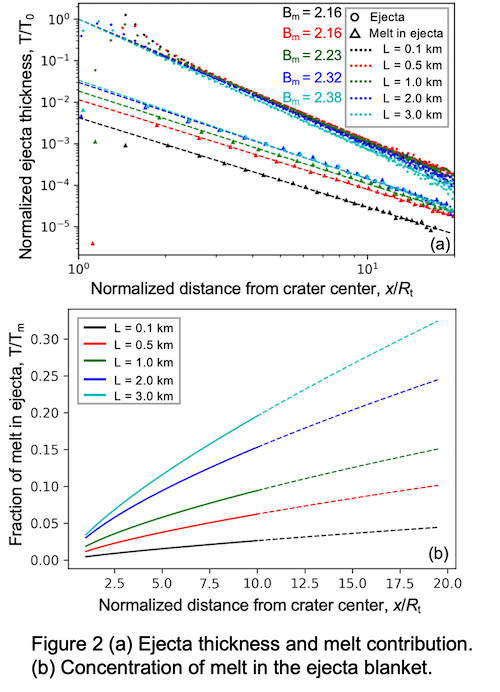
5. Conclusions
We found the production of impact-induced melt is a function of transient crater size following a power law. But due to the decreasing porosity gradient with depth, the melt production for small craters is more significantly enhanced compared with that of larger craters leading to a gentler slope. In addition, the melt concentration within the blanket is almost linearly increasing. It indicates that impact melt is highly concentrated not only inside the crater but also in the most distal ejecta.
References:
[1] Kring and Cohen (2002) JGR. [2] Pierazzo+ (2005), Large Meteorite Impacts III. [3] Collins+ (2004) MPS. [4] Ivanov+ (1997) International Journal of Impact Engineering. [5] Wünnemann+ (2006) Icarus. [6] Collins+ (2011) International Journal of Impact Engineering. [7] Wünnemann+ (2008) EPSL. [8] Besserer+ (2014) GRL. [9] Cintala and Grieve (1998) MPS.
How to cite: Liu, T., Luther, R., Manske, L., and Wünnemann, K.: Melt production and ejection at lunar intermediate-sized impact craters: where is the molten material deposited?, Europlanet Science Congress 2022, Granada, Spain, 18–23 Sep 2022, EPSC2022-402, https://doi.org/10.5194/epsc2022-402, 2022.
Introduction: During impact cratering, target materials are subjected to extreme deformation conditions. Brittle deformation under these conditions, where strain rates can exceed 101 to 102 s-1, is rate-sensitive. Typically, rocks are stronger when deformed at high strain-rate conditions [1]. This occurs because fracture propagation has a limited velocity; at high loading rates, the weakest flaws in a material are not able to cause failure before other, increasingly strong flaws are activated. This results in significant changes to mechanical properties and causes fragmentation of the target material [2, 3]. Dynamic compressive strength and fragmentation in brittle materials is not currently implemented in numerical impact simulations.
In this study, we present results of high strain rate mechanical tests to determine the characteristic strain rate for rate-dependent brittle failure and dynamic strength increase, and the fragment size and shape distributions that result from failure at these conditions. We investigated a variety of rock types and considered whether the fragment characteristics can be used as diagnostic indicators of loading conditions during brittle failure. In addition, we use numerical impact simulations to assess the significance of dynamic strength increase and compressive fragmentation during impact cratering at a variety of scales.
Methods: Mechanical data and samples were obtained using a hydraulic loading frame and a Split-Hopkinson Pressure Bar (SHPB). The hydraulic loading frame achieves strain rates from 10-6 s-1 to 10-4 s-1, while the SHPB achieves strain rates from 101 s-1 to 103 s-1. As sample materials, we chose a variety of igneous, metamorphic, and sedimentary rocks in order to investigate differences between target types and material properties. From the mechanical experiments, the strain-rate dependency of strength was calculated and samples were generated for microstructural analysis. We focussed our microanalysis on the distributions of fragment size and fragment shape as functions of strain rate. Numerical impact simulations in this study were conducted using the iSALE shock physics code [4 and refs. therein].
Results: We find that the characteristic strain rates of rocks, where the dynamic strength is twice the quasi-static strength, ranges between ~150 and ~350 s-1 depending on lithology (Figure 1). Fragment size analysis demonstrates an inverse power-law relationship between fragment size and strain rate for dynamic failure under uniaxial compression. Unlike fragment size, we find that fragment shape is independent of strain rate under dynamic uniaxial loading (Figure 3).
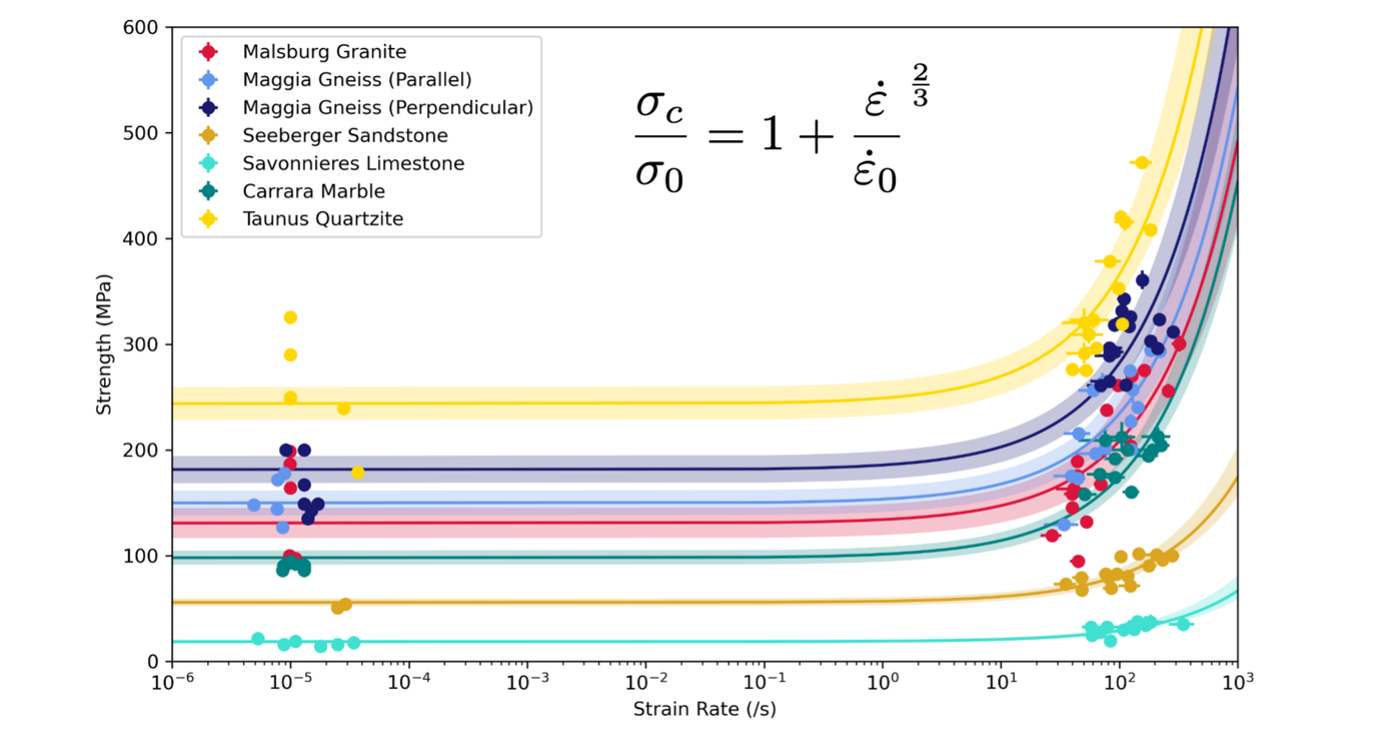
Figure 1. Rock strengths from quasi-static and dynamic testing. Each lithology follows the universal scaling relation (inset) of [1], where each material possesses a unique characteristic strength and characteristic strain rate. In all tested lithologies, strength dramatically increases at strain rates > ~101 s-1. Data from [2, 3].
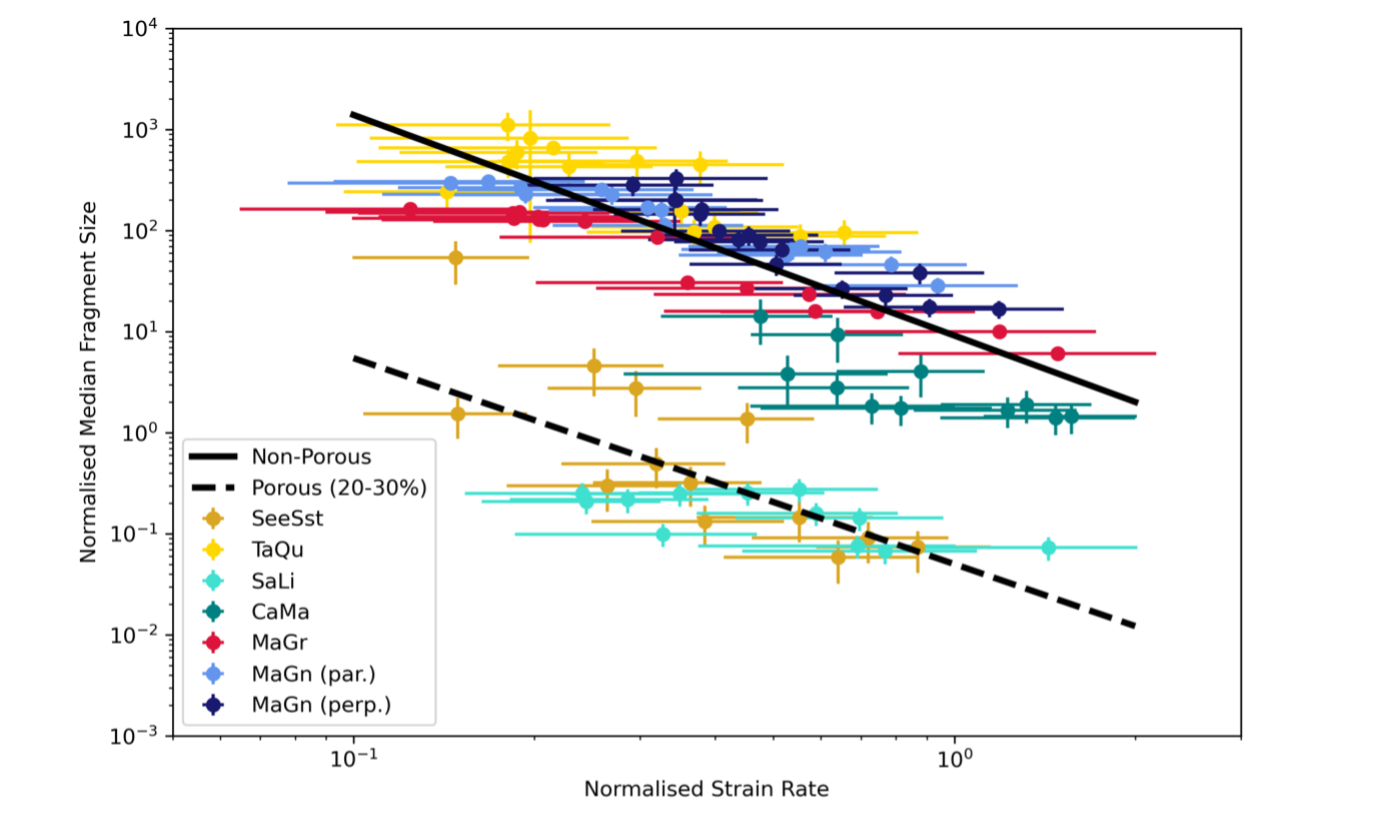
Figure 2. Scaled empirical fragmentation relationship for uniaxial compressive failure. The exponent of the relationship remains the same, while the constant varies between porous and non-porous rocks. From [3].
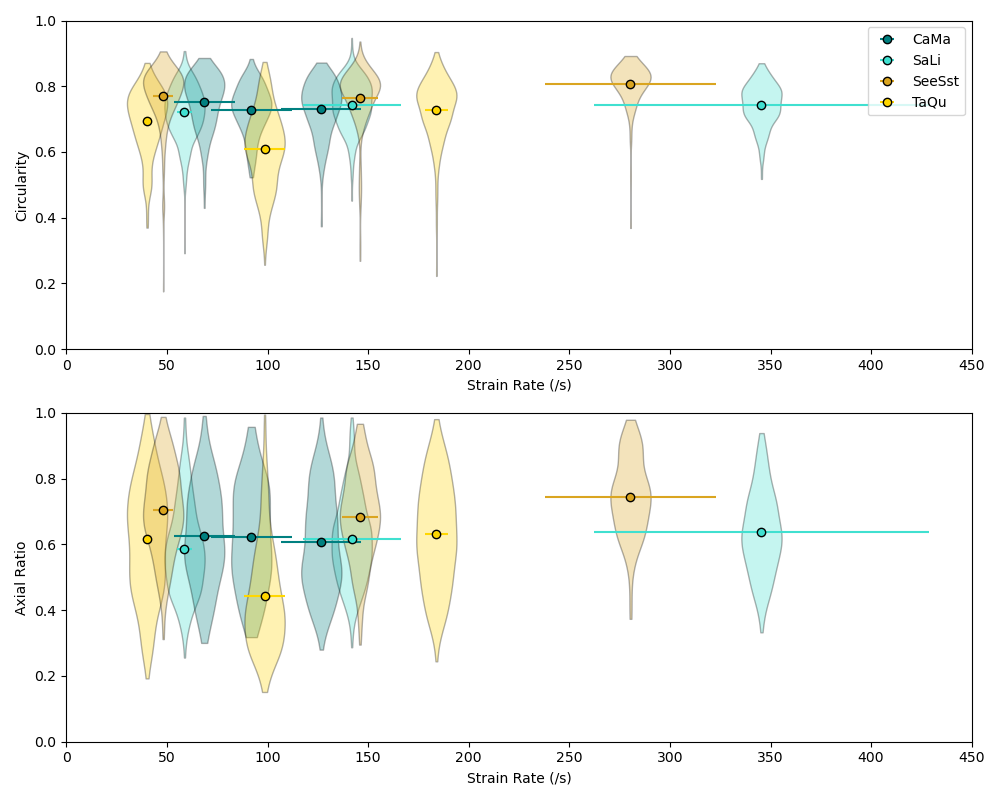
Figure 3. Fragment shape distributions for fragments > 2 mm as a function of strain rate. Distributions of fragment shape (circularity and axial ratio) for each sample are shown as kernel density estimates. Each point shows the mean shape parameter plotted against the strain rate, where the x-error bar shows the uncertainty in the strain rate. From [3].
Discussion: Numerical impact simulations demonstrate that strain rates are sufficiently high to produce rate-dependent effects in planetary impacts (vi > ~5 km/s) where impactor diameters are ~100 m or smaller (Figure 4). Thus, rate-dependent strength and fragmentation plays an important role in small planetary impacts and laboratory impact experiments. Based on the results of this study, we are developing a semi-empirical approach to account for rate-dependent shear strength in numerical impact simulations (Figure 5); an important development due to the need to accurately ground-truth numerical impact models against laboratory scale experiments. Additionally, this study demonstrates that fragment size may be used as a diagnostic indicator of the strain rate at failure during impact loading while fragment shape cannot be used. However, our experiments only used uniaxial compressive loads, it is uncertain how truly triaxial stress states may affect fragmentation behaviour.
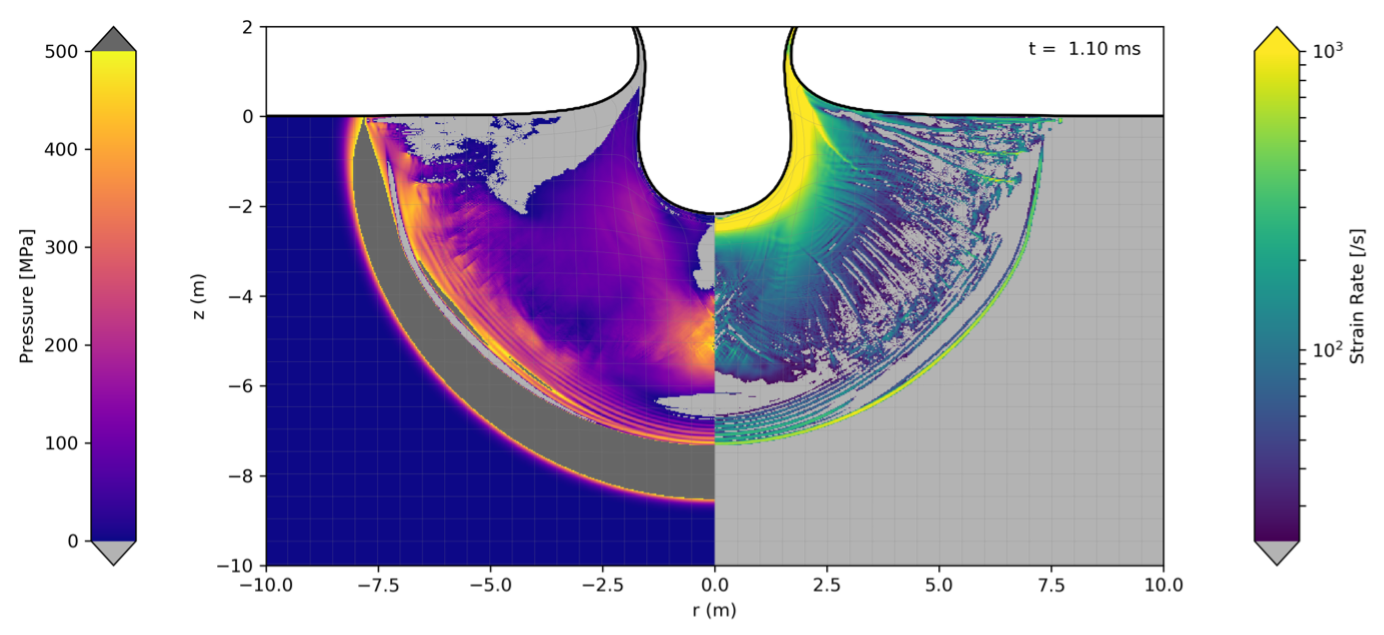
Figure 4. Crater excavation in an iSALE simulation of the impact of a 1 m diameter sphere at 15 km s-1. Left) Coloured regions indicate pressures between 0 and 500 MPa, regions of tension are coloured light grey while regions of high confining pressure (e.g. within the shock wave) are coloured dark grey. Right) Coloured regions indicate strain rates greater than 22.5 s-1, regions with lower strain rates are coloured light grey. Regions that are coloured in both panels are undergoing deformation in a regime where strength and fragmentation should be strongly controlled by strain rate. From [2].
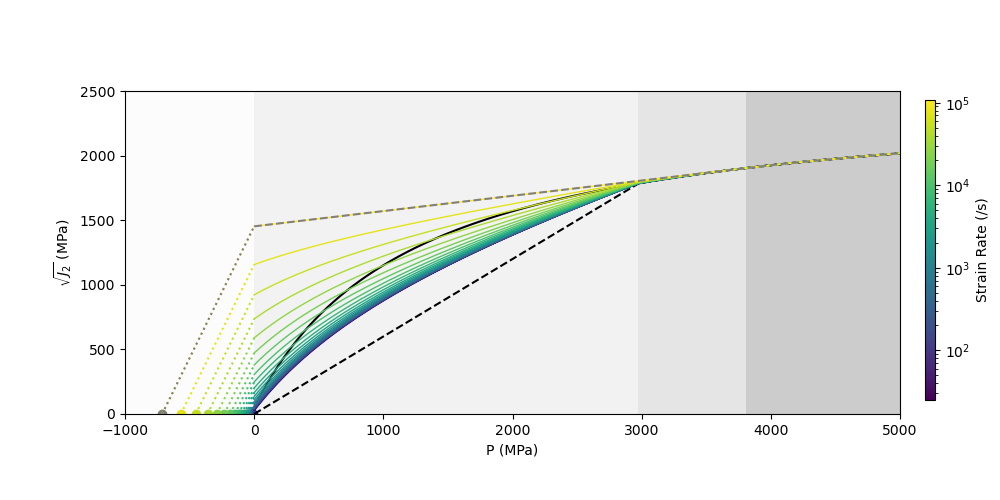
Figure 5. Implementation of dynamic strength as a modification of the ROCK strength model [5] (black). Uniaxial compressive and tensile strength follows the scaling law of [1]. In the high-pressure ductile regime (dark grey background shading), rock strength is not controlled by the behaviour of fractures, providing an upper limit for dynamic strength at ~105 s-1 [6] (grey).
Acknowledgments: H. Ickler and G. Mette are thanked for sample preparation. L. Müller, M. Dörffler, and T. Kern are thanked for lab assistance. The developers of iSALE are gratefully acknowledged. This work was funded by DFG Project KE 732/27-1.
References: [1] Kimberley, J. et al. (2013) Acta Materialia, 61:9, 3509-3521. [2] Rae, A. S. P. et al. (2020) JGR: Planets, 125:10. [3] Rae, A. S. P. et al. (2022) Tectonophysics, 824, 229221. [4] Wünnemann, K. et al. (2006) Icarus, 180:2, 514-527. [5] Collins, G. S. et al. (2004) MAPS, 39:2, 217-231. [6] Grady, D. E. (1998) Mechanics of Materials, 29:3-4, 181-203.
How to cite: Rae, A. S. P., Kenkmann, T., Collins, G. S., Poelchau, M. H., Padmanabha, V., and Schäfer, F.: Dynamic strength, fragmentation, and the impact cratering process, Europlanet Science Congress 2022, Granada, Spain, 18–23 Sep 2022, EPSC2022-265, https://doi.org/10.5194/epsc2022-265, 2022.
1. Introduction
The currently accepted scenario states that the primordial transneptunian belt (TB) extended from about 22 AU to 30 AU from the Sun, with a sharp edge. During the dynamical instability, this disk was strongly depleted by the influence of Neptune, and some bodies were implanted in the plutinos region, and others would end up as hot classicals (HC). The presence of some initial mass beyond 30 AU is under discussion yet compatible with a distribution of mass in which the Cold Classical (CC) belt would have formed. Most recent literature suggests two different size distributions for the primordial disk population informed by streaming instability models [1, 2] (hereafter NV16 and NV19), contrasting with the traditionally assumed broken power-laws (BPL). On the other hand, there is no consensus on the strength parameters that govern the response to collisions in the TB.
The main purpose of this work is to systematically study how the size frequency distributions (SFDs) proposed in the literature respond to dynamical and collisional evolution in the framework of early evolution. Therefore, we have modified our ALICANDEP code to include the characteristics of the new proposed evolution scenarios. Equipped with ALICANDEP-22, we have performed about 56 numerical simulations exploring different scaling laws and varying the onset time of dynamical instability (ti).
To select the best scenarios, we compare our results with the following observable constraints: number of bodies larger than 100 km, number of dwarf planets, lack of large bodies in the cold population, and estimated SFD slope for HC and CC objects.
2. Methodology
Here we updated the model (to ALICANDEP-22), and we adopted a simple scheme to include the possibility of considering an early dynamical excitation scenario under the current framework. This model includes statistical elimination and implantation of bodies from an inner disk to current TB regions, modelling dynamical effects present in the Nice model ([3], CBB12) and its current interpretation. Initially, most mass is concentrated in an inner disk ranging from just outside Neptune's initial orbit from about 22 AU to 30 AU and a small amount of mass is initially located between 42 to 47 AU, to simulate the in-situ formation of the cold classical disk. The inner disk evolves not only collisionally but also dynamically.
Such an inner disk undergoes collisional evolution and simultaneous dynamical excitation and depletion in an initially cold massive disk. Dynamical excitation during the instability of the giant planet triggers a smooth dynamical elimination of mass during the pre-instability phase, which is handled statistically. Lastly, further elimination and implantation of planetesimals to the outer region take place. Such region is modelled as three zones, accounting for the plutinos, the CC and HC populations.
The fragmentation algorithm is based on the fragmentation and re-accumulation model by [4] including improvements based on later available experimental data, numerical and theoretical studies. We assumed four scaling law to perform our simulations. These correspond to SL1: [5] for ice bodies; SL2: same as SL1 but scaled down by a factor 0.1; SL3: Same than SL1 but scaling Q* down by a factor 0.06 and shifting the minimum to 30 m; SL4: Scaling law by [6] and [7].
3. Results
We performed a large set of numerical simulations, exploring the parameter space to illustrate the consequence of the different evolution scenarios.
We identified sets of boundary conditions for the collisional and dynamical evolution of the primordial outer disk for which ALICANDEP-22 matches main current observables.
From our results, we may summarize that collisional evolution is relatively soft when the dynamical instability starts early, before 30 My, in a primordial disk of 20-30 Earth mass. In this case, the only change to the initial shape of the distribution regards the slope of the SFD for bodies D<10 km. This result implies that:
- The amount of primordial bodies with D<10 km largely defines the shape of the eroded SFD in 30 m to a few km.
- The initial shape (not the absolute number of bodies!) of the SFD for large bodies (D>10 km) is not significantly affected by the collisional evolution. Thus, the population of bodies D>10 km is only reduced according to dynamical depletion without modifying its primordial shape.
- Initially rounded populations around D=100 km, followed by a shallow slope at the largest bodies (Pluto-size bodies) end (such as NV16 and NV19) are more likely to end the evolution with the required number of dwarf planets observed in the plutino and HC populations, compared to a primordial BPL.
- The SFD of the implanted populations (plutinos and HC) recalls the shape of the SFD of the observed population of Jupiter Trojans (in the comparable size range). Among the distributions studied in this work, the NV16 SFD is the one that achieves a better agreement with that population in a greater size range (4-100 km), compared to NV19.
- The results of this work rule out the possibility that a BPL gives the SFD of the primordial population. That is due to the difficulty of this type of SFD to simultaneously reproduce the expected number of bodies with D>100 km and the dwarf planets observed in the population of plutinos and HC. In addition, the collisional evolution is essentially stopped once the dynamical instability phase begins, preventing a gradual change of the SFD around 100 km, which is instead present in the population of Jupiter's Trojans.
4. References:
[1] Nesvorný D., Vokrouhlický D., 2016, ApJ, 825, 94.
[2] Nesvorný D., Vokrouhlický D., 2019, Icarus 331, 49.
[3] Campo Bagatin A., Benavidez P. G., 2012, MNRAS, 423, 1254.
[4] Petit J.-M., Farinella P., 1993, CeMDA, 57, 1.
[5] Benz W., Asphaug E., 1999, Icarus, 142, 5.
[6] Leinhardt Z. M., Stewart S. T., 2009, Icarus 199, 542
[7] Leinhardt Z. M., Stewart S. T., 2012, ApJ, 745, 79.
Acknowledgements
PGB and ACB acknowledge funding by the Spanish Ministerio de Investigación, Ciencia e Innovación through project RTI2018-099464-B-I00 ``Retos de la Sociedad'' (2018 call).
How to cite: Benavidez, P., Campo Bagatin, A., Álvarez-Candal, Á., and Vincent, J.-B.: Early collisional evolution of TNOs, Europlanet Science Congress 2022, Granada, Spain, 18–23 Sep 2022, EPSC2022-873, https://doi.org/10.5194/epsc2022-873, 2022.
Introduction: Sputnik Planitia is a ~1600km-wide basin that dominates the surface of Pluto [1,2]. Observations show this feature to be amongst the deepest on Pluto [2], however its original depth is obscured by a thick layer of N2 ice [3]. Its quasi-elliptical shape somewhat resembles a large degraded impact basin [4], leading to multiple impact-based investigations [5,6]. However, these works were limited to head-on collisions in two-dimensions, restricting their capacity to reproduce the simulated impact basin’s precise geometry or explore the oblique impact angles predicted to produce Sputnik Planitia’s elongated morphology.
Another common thread in these studies is the inferred presence of a subsurface ocean, as this could reconcile the seeming disparity between the basin’s gravity contribution and its near-equatorial location. The negative gravity anomaly of such a large basin excavated from a solid mantle would induce true polar wander and drive its position towards one of Pluto’s poles. A positive anomaly, on the other hand, would provoke the contrary, forcing the basin equatorward [7].
The currently accepted mechanism to produce such an anomaly is for Sputnik to form in an ice-crust above a global water ocean. The thinning of the crust leads to uplift of denser fluid [8,9], causing a mass concentration or “mascon” beneath the basin. This structure must be retained, for if the ice shell relaxes viscously, or the liquid ocean solidifies, the mascon disappears.
Retaining this structure is no simple task; the ice shell must be cold (and therefore stiff) to avoid rapid viscous relaxation, while the ocean beneath must be warm enough to remain liquid to the present day. Such a scenario may require an unusually high ammonia content to reduce the ocean’s freezing point [8] and/or a continually-replenished layer of clathrate hydrates to insulate the ice shell from the relatively warm ocean [9].
Here, we propose a new impact mechanism that introduces a long-lived rocky mascon beneath the Sputnik Planitia basin, while reproducing the topographical shape of the feature in three dimensions, without the need for a present-day subsurface ocean.
Method: We simulate the impact using the SPHLATCH smoothed-particle hydrodynamics (SPH) code [10,11]. Shear strength and plasticity are included through a Drucker-Prager-like yield criterion, as such effects have been shown to be important even at planetary scales [11], with their prominence being particularly amplified by the very low temperatures of Pluto. The parameter space explored includes impactors of radii 250-500 km, with impact angles of 0-45° and impact velocities of 1.0-1.4 times the mutual escape speed (~1.2 km/s). We consider undifferentiated impactors of ice, and of rock, and differentiated impactors with core mass fractions from 20-66%.
Preliminary Results: The most promising cases lie in the intermediate parameters: core masses 5-30%, impact angles 15-30°, and an impactor radius ~375 km. An example simulation in this range is shown in Fig. 1. Here the impactor initially excavates the material of the immediate impact site (Fig. 1a) before sufficiently slowing such that it can no longer overcome the shear strength of the cold ice and begins to slide along the target mantle towards its surface. While much of the impactor’s ice is displaced during this first phase, the rocky impactor core remains mostly intact due to its much higher density, melting temperature and strength, forcing out any impactor ice that was initially on the target-facing hemisphere. Most of the transient crater is then filled with infalling impactor ice while the impactor core slides back down towards the target core, losing some of its spherical shape as it does so (Fig. 1b).
Finally the site relaxes, settling into the desired teardrop shape of Sputnik Planitia, with the impactor core remaining as a buried mascon near Pluto’s core-mantle boundary (Fig. 1c). Fig. 2 shows the final distribution of the impactor material, with a remarkable resemblance to Sputnik Planitia. The near-spherical shape in the northern hemisphere corresponds to the initial point of impact where a more classical crater forms and collapses, whereas the pointed, triangular shape in the south corresponds to the sliding region of the impactor core.
We propose that the overall shape of this feature could remain intact if the impactor mantle’s precise composition had a slightly higher density than that of the primordial Pluto, as its greater load on the silicate core would lead to a local depression via isostasy. Furthermore, the dense buried mascon provided by the impactor’s rocky core would produce a significantly deeper region of the basin. N2 ice would quickly accumulate in the basin [3], culminating in the positive mass anomaly that drove Sputnik Planitia into its current position through true polar wander. The region of the basin with the strongest positive anomaly – the southernmost, narrow section directly above the mascon – would be forced closest to the equator, matching present day observations. Finally, as true polar wander best explains the distribution of extensional features on Pluto [7], a more dominant positive anomaly provided by a differentiated impactor and a fully frozen ice shell may better fit the current observational constraints.

Fig. 1: Example simulation of the impact mechanism. (a) Shortly after the impact, where the transient crater is still present and the impactor core’s velocity has slowed to a near stop. The faded object indicates the impactor’s initial size and velocity. (b) After the collapse of the transient crater, now filled with impactor mantle. The impactor core has begun falling back towards Pluto’s core-mantle boundary, (c) The post-impact state of Pluto, 6 hours after the collision.
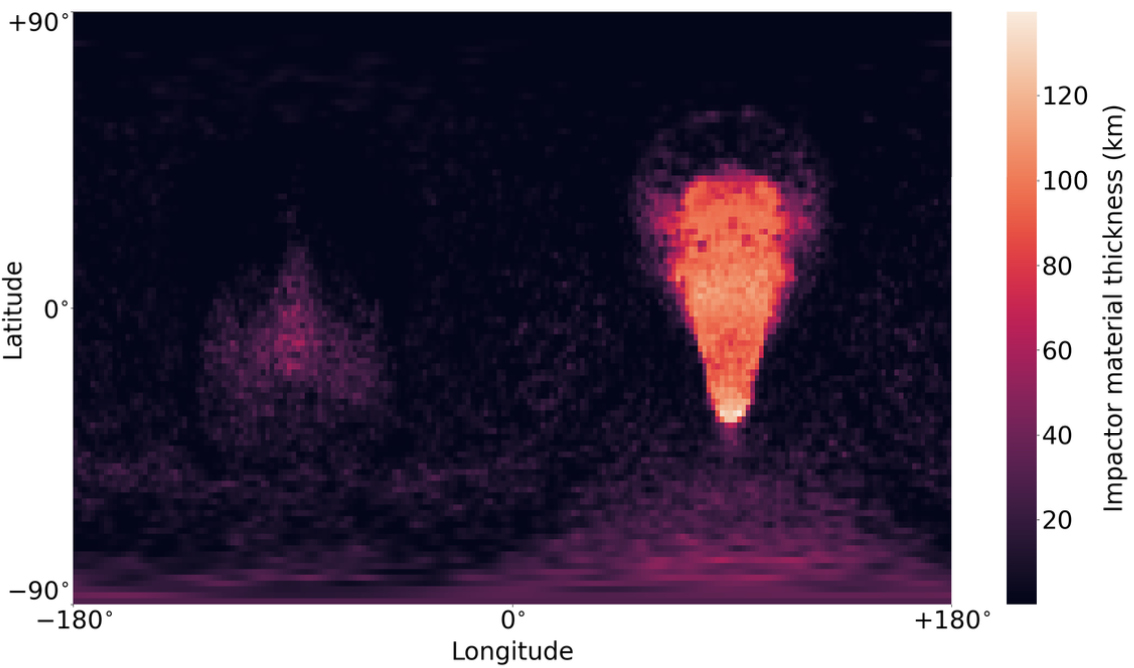
Fig. 2: A global map of the final impactor material distribution down to depths of ~120km. This corresponds to the same simulation as Fig. 1.
References:
[1] Stern et al., 2015. Science, 350(6258).
[2] Schenk et al., 2018. Icarus, 314:400-433.
[3] Bertrand & Forget, 2016. Nature, 540(7631):86-89.
[4] Moore et al., 2016. Science, 351(6279):1284-1293.
[5] Johnson et al., 2016. Geophysical Research Letters, 43(19):10068-10077.
[6] Denton et al., 2021. Geophysical Research Letters, 48(2).
[7] Keane et al., 2016. Nature, 540(7631):90-93.
[8] Nimmo et al., 2016. Nature, 540(7631):94-96.
[9] Kamata et al., 2019. Nature Geoscience, 12(6):407-410.
[10] Reufer et al., 2012. Icarus, 221:296–299.
[11] Emsenhuber et al., 2018. Icarus, 301:247-257.
How to cite: Ballantyne, H., Asphaug, E., Denton, C. A., Emsenhuber, A., and Jutzi, M.: Sputnik Planitia as an Impactor Remnant: An Ancient Mascon in a Frozen Ice Mantle, Europlanet Science Congress 2022, Granada, Spain, 18–23 Sep 2022, EPSC2022-1130, https://doi.org/10.5194/epsc2022-1130, 2022.
Introduction: During the late accretion phase, large differentiated bodies impacted the Earth. The material from these impactors, especially from their cores, could have altered the composition of Earth’s mantle and might offer an explanation [1] for the measured high concentrations of highly siderophile elements (HSE) in Earth’s contemporary mantle [2]. Since the planet was most likely covered by a deep magma ocean during this period due to giant collisions like the moon forming impact [3], a better understanding of impacts into these is essential. Especially important is the fragmentation of the impactor core, because a more significant fragmentation would allow better mixing with the surrounding mantle material. Different experimental and numerical approaches have been used to analyze this in the past [4,5]. Following up on this work we improved the fragmentation process in the Eulerian shock physics code iSALE to analyze the effect of different model parameters like impactor velocity, radius and magma ocean depth.
Methods: We use the grid-based Eulerian shock physics code iSALE-2D [6,7] to simulate impacts of differentiated bodies into a magma ocean. iSALE is optimized accurately reproduce large scale features of the impact, such as the resulting crater morphology. Behavior on smaller scales, however, like the detailed fragmentation of impactor material, is not sufficiently resolved. To change this, we developed and implemented a new method that allows for a more accurate simulation of the fragmentation process even on scales close to the grid cell size. The idea of the method is to determine when the size of a fragment as a whole or in part approaches the resolution limit and in such a case use additional petrophysical criteria to determine if fragmentation occurs. In case the criterion is fulfilled, the material is removed from the grid and replaced by a numerical particle representing the fragment in the course of the subsequent material flow.
Our simulation setup consists of a differentiated impactor hitting a magma ocean. The radius of the impactor is on the order of hundreds of kilometers and was varied in different simulations. The velocity ranges between 5 and 20 km/s and different possible depths of the magma ocean relative to the impactor size are explored as well.
Results: In figure 1 we compare simulation results at different time steps with and without the new method. It is visible that the impactor core fragments significantly in both cases for the shown setup. The relative position of these fragments are comparable as well.
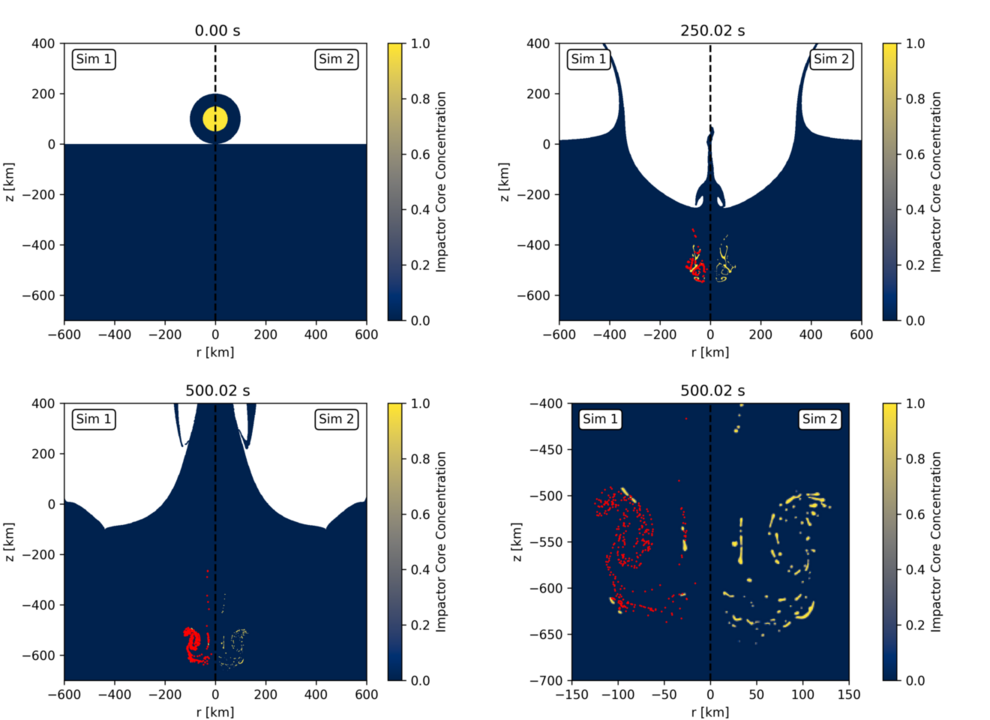
Figure 1: Simulations with (Sim 1) and without (Sim 2) the new method at different time steps for a radius of 100 km at a velocity of 11.5 km/s. The impactor core is shown in yellow and the particles used in the new method in red.
The resulting fragment size frequency distribution however is very different, as seen in figure 2. The new method shows significantly finer fragmentation, which is in line with the tendency of regular iSALE to artificially clump material together near the resolution limit resulting in artificially too big fragments.
Figure 2: Cumulative size frequency distribution of the number of impactor core fragments for the simulations shown in figure 1.
The preliminary results generally indicate significant fragmentation of the impactor core, allowing for mixing of the core material with the surrounding mantle. They also show that a higher impact velocity corresponds to stronger disruption, resulting in smaller average fragment sizes. Increasing the impactor radius leads to larger fragment sizes. The effect of the magma ocean depth on the fragmentation is currently being studied.
Acknowledgments: We gratefully acknowledge the developers of iSALE-2D, including Gareth Collins, Kai Wünnemann, Dirk Elbeshausen, Tom Davison, Boris Ivanov and Jay Melosh. This work was funded by the Deutsche Forschungsgemeinschaft (SFB-TRR170, subproject C2 and C4).
References: [1] Wood B. J. et al. (2006) Nature 441:825-833. [2] Walker R. J. (2009) Geochemistry 69:101-125. [3] Tonks W. B. et al. (1993) Journal of Geophysical Research: Planets 98:5319-5333. [4] Daguen R. et al. (2014) Earth and Planetary Science Letters 391:274-287. [5] Kendall J. D. et al. (2016) Earth and Planetary Science Letters 448:24-33. [6] Collins. G. S. et al. (2004) Meteoritics & Planetary Science 39:217-231. [7] Wünnemann K. et al. (2006) Icarus 180:514-527.
How to cite: Röhlen, R., Wünnemann, K., Allibert, L., Manske, L., Maas, C., and Hansen, U.: Shattered Cores? Fragmentation of Asteroid Cores During Impact Into a Magma Ocean., Europlanet Science Congress 2022, Granada, Spain, 18–23 Sep 2022, EPSC2022-1069, https://doi.org/10.5194/epsc2022-1069, 2022.
Introduction
Mars is a cold dry planet, yet there is ample evidence for fluvial activity on its surface, which paints a different picture for its past climate [1]. If Mars has ever been covered by an ancient ocean or ubiquitous paleolakes, the signatures of the presence of water would have been preserved in the ejecta blankets of some impact sites because the thermodynamics of the excavation flow depends on the target material properties such as its composition and mechanical properties [2]. The main objective of this work is to test whether the difference between impact sites of water-covered, ice-rich, and dry target subsurfaces on Mars is significant enough to be observable.
Method
To simulate hypervelocity impact processes in solid materials, we use the iSALE-2D shock physics code [3,4,5]. Our simulations make use of its following models: the elasto-plastic constitutive model for multiple materials, the fragmentation and modified strength model, the porosity compaction model, and the acoustic fluidisation block model. Target materials are described by the ANEOS equations of state for basalt, water ice, and water.
We consider different impact scenarios with varied target composition: i) 200-400m of liquid water covering basalt, ii) 100-200m basalt surface covering 200-400m of subsurface water ice, iii) dry basaltic surface with no ice or water. The impact parameters are fixed across these scenarios: impacts are vertical and triggered by a single impactor with the impact velocity of 10km/s and the radius of 100m. The projectile is made of intact basalt described by the Lundborg strength model, while the the strength of the target basalt is described by the ROCK model, in which the yield strength is a function of both pressure and damage, with the latter computed by the iSALE damage model.
The full trajectories and final distribution of the impact ejecta have to be quantified in post-processing due to the fact that high above the crater, ejecta becomes underresolved in the Eulerian grid. We thus analyse the characteristics (i.e. velocity, launch time, launch position) of tracer particles when they reach an altitude of one projectile radius above the surface [2]. We then calculate their final landing positions, assuming ballistic trajectories, and analyse the ejecta mass distributions.
Results
|
|
|
Figure 1. Pressure and density maps of different impact scenarios shown at the resolution of 10CPPR (cells per projectile radius). The naming of the scenarios is as follows: ThD1: dry case of pure basalt, ThI200200: 200m of basalt covering 200m of water ice over basalt; ThW200: 200m of water over basalt. |
In Figure 1 we present different impact scenarios at 3 distinct periods of the excavation stage: 2s, 6s and 20s after the impact. The presence of water or water ice modifies the volume of the cavity during the entire excavation phase. The shapes and angles of the ejecta curtains are also different for varied target scenarios.
|
|
|
Figure 2. The evolution of crater volumes and radii over time. |
In Figure 2 we show the time evolution of the crater volumes and radii quantitatively. The most striking difference is between the volume of the excavated material in dry vs. ice-rich or water-rich targets, which translates into the difference in volumes of the ejecta blanket. Crater radii are also a discriminator between those cases, with water-covered and ice-rich targets being deeper than the “dry” one. However, over time their depth would also be decreased by the sublimation of subsurface ice and evaporation of the surface water.
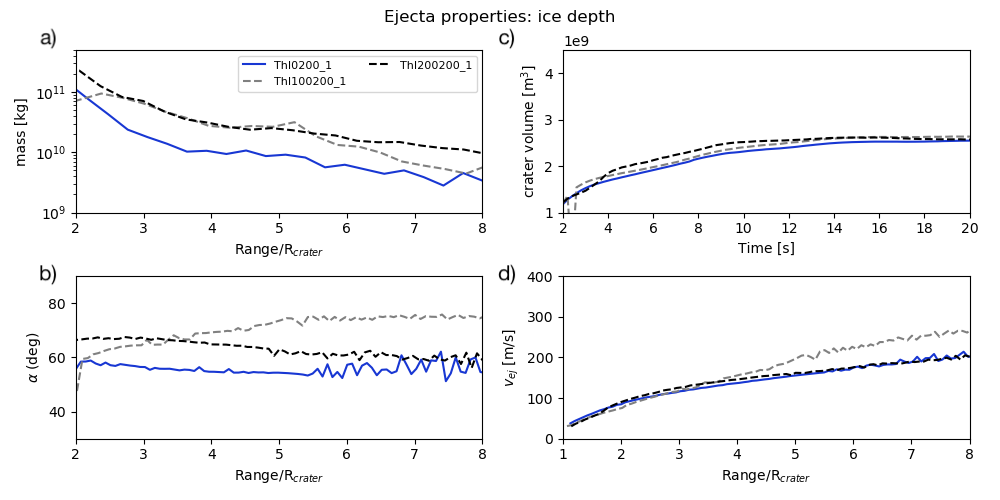 |
| Figure 3. Ejecta properties for the cases with varied ice depth. a) Mass distribution of ejected material. b) Dependency of the median ejection angle of the target material on where it landed. c) Evolution of the crater volume over time. d) Dependency of the ejection velocity of target material on where it landed. Rcrater were computed at t=20s. |
In Figure 3 we compare the ejection properties for targets with 200m ice at different depths: 0m (ThI0200); 100m (ThI100200) and 200m (ThI200200) depths. The final mass distributions and ejection angles are substantially different between these cases, and those differences would be reflected in the morphologies of the ejecta blankets. The final crater volumes (c) alone are insufficient to discriminate between these cases.
Conclusion
We conducted numerical experiments of impact cratering into varied targets: ice-rich, water-rich and dry (pure basalt). Our preliminary results show that for the constant projectile and velocity, one can discriminate between those cases based on the crater size and ejecta volume. We also show that the depth of buried ice would leave a characteristic signature in the blanket.
Future work
We plan to address the effects of the atmosphere and vapour plumes on the trajectories of ejecta. The interaction of ejected material with an atmosphere, accounting for drag forces and momentum exchange, was recently implemented in iSALE [6].
References
[1] Zachary I Dickeson, Joel M Davis, Martian oceans, Astronomy & Geophysics, Volume 61, Issue 3, June 2020, Pages 3.11–3.17, https://doi.org/10.1093/astrogeo/ataa038
[2] Luther, R., Zhu, M.-H., Collins, G. and Wünnemann, K. (2018), Effect of target properties and impact velocity on ejection dynamics and ejecta deposition. Meteorit Planet Sci, 53: 1705-1732. https://doi.org/10.1111/maps.13143
[3] Amsden, A., Ruppel, H., and Hirt, C. (1980). SALE: A simplified ALE computer program for fluid flow at all speeds. Los Alamos National Laboratories Report, LA-8095:101p. Los Alamos, New Mexico: LANL.
[4] Collins, G. S., Melosh, H. J., and Ivanov, B. A. (2004). Modeling damage and deformation in impact simulations. Meteoritics and Planetary Science, 39:217--231.
[5] Wünnemann, K., Collins, G., and Melosh, H. (2006). A strain-based porosity model for use in hydrocode simulations of impacts and implications for transient crater growth in porous targets. Icarus, 180:514--527.
[6] Robert Luther, Natalia Artemieva, Kai Wünnemann, The effect of atmospheric interaction on impact ejecta dynamics and deposition, Icarus, Volume 333, 2019, Pages 71-86, https://doi.org/10.1016/j.icarus.2019.05.007.
How to cite: Sokolowska, A., Thomas, N., Wünnemann, K., and Luther, R.: Simulated craters and ejecta on the past Martian water- and ice-rich impact sites, Europlanet Science Congress 2022, Granada, Spain, 18–23 Sep 2022, EPSC2022-1037, https://doi.org/10.5194/epsc2022-1037, 2022.
Enceladus is an icy moon of Saturn, with a surface composed predominantly of water ice [1]. It has large water vapour plumes, which eject icy grains and volatiles from its subsurface ocean into space [1]. The presence of a subsurface liquid water ocean and evidence of hydrothermal activity in the moon’s interior [2] has made Enceladus a key target in the search for life beyond Earth. Determining the ocean composition is an important consideration in assessing the moon’s habitability, but direct analysis is impossible because it is covered by a thick icy crust [3]. Enceladus’ surface, however, can offer some insights into the processes operating within and on the satellite, but is influenced by several processes that modify its composition. For example, plume material either falls back to the surface of the satellite or is ejected at high enough velocities that it orbits Saturn, forming Saturn's E-ring [4]. Since Enceladus orbits within this structure, E-ring material is redeposited on the surface of the moon. While the distribution and abundance of volatiles deposited by the plumes may be indicative of their presence in the subsurface ocean, E-ring grain deposits have been processed by Saturn’s magnetosphere, experiencing irradiation and erosion in the space environment. Being able to distinguish between volatile profiles of ices from fresh plume material and those subjected to impact by E-ring grains is important for understanding which surface material best represents the ocean composition.
To achieve this requires a simulation of impact processes onto Enceladus ices. Ices representative of feasible volatile compositions have been grown in a bespoke cryogenic vacuum system. Ices are grown at temperatures between -95°C and -120°C, at pressures of 10-4 mbar to 10-5 mbar. These conditions have been chosen to best replicate the environment around the Enceladus plumes, without rapidly sublimating the ices at ultra-high vacuum pressures. A Quadrupole Mass Spectrometer (QMS) is used to analyse the composition of the pristine ices prior to impact simulation using the All-Axis Light Gas Gun (LGG) at The Open University. The LGG can achieve hypervelocity impacts at velocities in the range of those predicted for E-ring impact (0.5 km/s to 5 km/s [5, 6, 7]). Salt grains, extracted from simulated E-ring ice particles via sublimation using the cryogenic vacuum system, will be used as projectiles. The volatile profile of impacted Enceladus ice analogues is then analysed using a QMS and compared to the original ices.
However, it is critical to understand sources of contamination within the impact simulation, since these may mask modifications that are key to understanding the space weathering processes and invalidate icy impact experiments at low pressures. Any volatile contamination in the headspace of the gun is likely to cryotrap onto the pristine ice analogues and it is expected that, as projectiles are fired, materials used in the shot, such as nylon from the piston and sabot material, will volatilise. Although the chamber is cleaned after each use and nitrogen is used to purge the chamber, the level of contamination from volatilising substances is expected to be high.
A QMS has been used to investigate the volatiles within the LGG for the duration of the impact experiments. After the projectiles and shell casing have been loaded and the range of the gun evacuated down to vacuum pressures, the QMS is exposed to the headspace of the small experimental chamber, where targets are placed. It is set up to detect masses between 0 – 200 amu and takes readings throughout the firing process. This includes the initial set up, loading hydrogen in the pump tube, firing the gun, evacuating the range, nitrogen purging, and air purging.
The preliminary results indicate that hypervelocity impact studies using Enceladus ice analogues are feasible despite the contamination in the gun and the QMS has proven a valuable method of analysing the headspace of the gun during the firing process. While loading hydrogen in the pump tube in preparation for firing, the results from QMS analysis have shown slight leaks between the pump tube and range (Fig. 1A). This is to be expected as the pump tube is not hermetically sealed from the range, but may be improved upon. It has also shown the presence of higher mass (>100 amu) molecules that are only present for <1 min during the firing process (Fig. 1B). This is potentially the main source of recurring debris and soot observed on the walls of the blast tank post-impact, and may be a source of contamination if cryotrapped onto ices. This is currently undergoing further investigation. However, results show that this is the only stage of the firing process with a volatile profile not indicative of air leaks. The full results of the contamination analysis will be presented, alongside future work involving Enceladus ice analogues.
Figure 1. Initial results of the QMS analysis, showing the molecules present at various stages of the firing process. A) shows mass fragments (0-45 amu) in the range of the gun before any shots have been fired, indicative of air. B) shows heavier mass fragments (100-200 amu) detected during the firing process. These peaks are detected at the limits of the QMS sensitivity, which is expected to be why they are detected at the same pressures.
References
[1] Brown, R. et al. (2006). Composition and physical properties of Enceladus' surface. Science, 311(5766):1425-1428.
[2] Hsu, H. et al. (2015) Ongoing hydrothermal activities within Enceladus. Nature, 519(7542):207–210
[3] Cadek, O. et al. (2016) Enceladus’s internal ocean and ice shell constrained from Cassini gravity, shape, and libration data. Geophysical Research Letters, 43(11):5653–5660
[4] Kempf, S. et al. (2010). How the Enceladus dust plume feeds Saturn’s E ring. Icarus, 206(2):446–457
[5] Juhász, A. et al. (2007). Signatures of Enceladus in Saturn’s E ring. Geophysical Research Letters, 34(9)
[6] Howett, C. et al. (2018). Ring and Magnetosphere Interactions with Satellite Surfaces. In Enceladus and the Icy Moons of Saturn, pages 343–360. University of Arizona Press
[7] Spahn, F., et al. (2006). E- ring dust sources: Implications from Cassini’s dust measurements. Planetary and Space Science, 54(9-10):1024–1032.
How to cite: Richards, G., Pearson, V., Patel, M., Morgan, G., Sylvest, M., Morland, Z., Fox-Powell, M., and Sheridan, S.: Hypervelocity impact studies on Enceladus analogue ices, Europlanet Science Congress 2022, Granada, Spain, 18–23 Sep 2022, EPSC2022-906, https://doi.org/10.5194/epsc2022-906, 2022.
1. Introduction
The Campo del Cielo strewn field, located in the south of the Chaco province, Argentina, formed about 4000 a ago due to the impact of an octahedrite iron asteroid [1,2,3]. It extends about 14 km and ~3.5 km in impact and lateral direction, respectively. Recent numerical reconstructions of the strewn field yielded impactor parameters of min. 7500 – 8500 tons, 14.5-18.4 km/s entry velocity, and max. 16.5° entry angle [4]. Beside four elliptical impact craters with diameters of 70 - 115 m, penetration funnels with intact meteorites up to 30 tons in weight have been formed during the event [1,2].
In this study, we analyse possible conditions of funnel formation, which may help to constrain the impactor parameters [4].
2. Method
The funnel formation is simulated using the iSALE-2D shock physics code [5], which has been applied to similar problems, previously [6]. Here, we explore the influence of impact velocity and target porosity on the funnel formation processes. Initial conditions are consistent with the atmospheric entry model, i.e. we model a 30 tons fragment at impact velocities between 600 m/s – 1600 m/s. The target is set up with a porosity of 40% to represent the local loess unit at the side of impact. Further, the porosity is varied between 30-50% at a constant impact velocity of 800 m/s.
To test the effect of impact angle on the funnel formation process, we used the 3D version of iSALE to simulate impacts at 600 m/s at varying angles from 15° to 90°.
3. Results
Preliminary analysis of impact experiments [7] have shown that in the Campo del Cielo case (iron projectile and loess as a target) funnel formation and projectile survivability is possible at impact velocities below 1 km/s. Even though the iSALE models confirm this estimate, the 1 km/s is probably the upper limit of impact velocity allowing survivability of high strength iron meteoroids impacting into loess (Figure 1). At this velocity, the fragment is already deformed to a significant extent (Figure 2). A further increase of impact velocity leads to an increase in projectile deformation (pancaking) up to the projectile breakup. At velocities above 1 km/s, funnels are gradually transformed into impact craters due to their increase in diameter. At 1.6 km/s, the cavity widens about 5 times the projectile size and the depth/diameter ratio approaches 1.
Figure 1: Snapshot of the funnel formation after 160 ms into a loess target. On the left is shown the density, on the right is shown the temperature.
Figure 2: Projectile Fate at different impact velocities.
3D models reveal an interesting effect: at shallow angles even a low-velocity projectile is reflected from the surface and an elliptical crater, not a funnel, is formed (Figure 3). An impact angle should be at least 25° to avoid the reflection.
Figure 3: The projectile (dark red) bounces off from the target surface (yellow) for an impact at 15° at 600 m/s. The colour along the floor indicates the density, with 1000 kg/m³ as dark blue to 2000 kg/m³ as red.
4. Conclusion and Discussion
Our findings suggest that the funnels of the Campo del Cielo strewn field are in line with results from recent atmospheric entry simulations [4]. Even though the predicted entry angle of 16.5° is below the threshold for funnel formation (25°), atmospheric deceleration of fragments from cosmic velocities down to 0.6 – 1 km/s steepens their trajectories. Our findings also contradict field estimates of the Campo del Cielo impact scenarios in which impact velocities are in the range of 3-5 km/s at an angle of 9-10° to horizon [1].
Acknowledgements
We gratefully acknowledge the developers of iSALE (www.isale-code.de). The authors acknowledge the funding from the ESA project P3-NEO-VIII and P3-NEO-XXVIII. The authors are grateful to Shawn Wright for the update of Campo del Cielo field observations.
References
[1] Cassidy W. A. and Renard M. L. 1996. M&PS 31:433–448.
[2] Cassidy W. A. et al. 1965. Science 149: 1055–1064.
[3] Liberman R. G. et al. 2002. M&PS 37:295–300.
[4] Schmalen A. et al. 2022. M&PS.
[5] Wünnemann K. et al. 2006. Icarus 180: 514–527.
[6] Luther R. et al. 2017. M&PS 52: 979-999.
[7] Kadono T. 1999. PSS 47: 305–318.
How to cite: Luther, R., Schmalen, A., and Artemieva, N.: Campo del Cielo Strewn Field: Simulating the Funnel Formation for Vertical & Oblique Impacts, Europlanet Science Congress 2022, Granada, Spain, 18–23 Sep 2022, EPSC2022-636, https://doi.org/10.5194/epsc2022-636, 2022.
Please decide on your access
Please use the buttons below to download the presentation materials or to visit the external website where the presentation is linked. Regarding the external link, please note that Copernicus Meetings cannot accept any liability for the content and the website you will visit.
Forward to presentation link
You are going to open an external link to the presentation as indicated by the authors. Copernicus Meetings cannot accept any liability for the content and the website you will visit.
We are sorry, but presentations are only available for users who registered for the conference. Thank you.
Posters: Thu, 22 Sep, 18:45–20:15 | Poster area Level 1
Polycyclic aromatic hydrocarbons (PAH) are ubiquitous organic molecules populating the interstellar medium of galaxies and they are the major responsible of interstellar infrared spectral features (e.g., Allamandola et al. 1989, Tielens 2008). PAH are also found as constituents in carbonaceous chondrites (e.g., Kalpana et al. 2021). Similarly to silicate dust, carbon-rich micrometric and submicrometric aggregates occur in different astrophysical environments where they are subjected to several weathering processes such as impact shock events and grain-grain collisions. These processes change the chemistry and structure of the original materials giving rise to new chemical species which contribute to the chemical richness of the cosmic environment (e.g., Murri et al. 2022; Mimura et al. 1995). The study of the chemical and structural evolution of aggregates of PAH subjected to extreme conditions is relevant for examine in depth the origin of the densest phases of carbon (e.g., pre-solar grains) as that of prebiotic building blocks of life (Giese et al. 2022). For this purpose, a lot of effort has been made by the whole scientific community for reproducing in laboratory the planetary conditions which trigger the processing of cosmic dust. In this framework, high-energy pulsed lasers represent consolidated tools for reproducing the high energy-density conditions similar to those occurring in shock events in the interstellar medium as a consequence of supernova explosions. Liquid-phase pulsed laser ablation (LP-PLA) is a technique in which high-energy laser pulses are focused on the surface of a solid target immersed in a liquid to induce ablation of material as a result of the ignition of a plasma plume, and recondensation of the ablated material in the surrounding liquid in the form of suspended nanoparticles. The presence of the liquid augments to a great extent the pressure achieved at the solid/liquid interface and allows the onset of cooling rates of the order of 105 K s-1, likewise to what occurs in circumstellar environments. Using this technique, nanodiamonds are commonly produced from graphite targets in water or organic liquids (e.g., Amans et al., 2017).
In this paper we report the results of the high-energy laser processing of a pure nano-phase of rubrene (5,6,11,12-tetraphenyltetracene), a PAH constituted by a backbone of four fused benzene rings (tetracene) bonded to four phenyl rings (Figure 1). The choice of rubrene is motivated by the possibility to obtain commercially available batches of purity higher than 99.9%, its ability to organize in a high-symmetry molecular crystalline phase, and the in-depth knowledge of the photophysical and photochemical properties of both the isolated molecule and molecular aggregates. All these characteristics make rubrene an ideal model system to study the evolution of PAH in response to high-energy processing. We performed LP-PLA of rubrene nano-phases dispersed in water (i) to simulate space weathering in a water environment (e.g., hydrous or volatile-rich bodies) and (ii) to study its chemical and structural evolution. The laser processing of the water suspension was monitored by optical spectroscopy (absorption and luminescence) and high-resolution transmission electron microscopy and diffraction analyses.
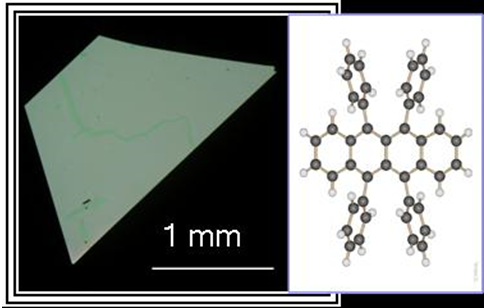
Figure 1. Molecular structure of rubrene (C42H28) and optical micrograph collected with cross polarizers on a thin orthorhombic single crystal or rubrene.
We observed that laser processing brings about a progressive suppression of the absorption band in the visible range of the pristine rubrene nanocrystals, with increment of the signal in the UV range, indicating their transformation into a different phases. The structural and chemical features of these new phases are inferred by high-resolution transmission electron microscopy and analysis and compared with known carbon-rich phases populating the interstellar medium.
Acknowledgments
Funding of the University of Milano – Bicocca through grant 2021-ATEQC-0054 is acknowledged. We are grateful for the support of Giancarlo Capitani for electron microscopy analyses.
References
Allamandola et al. (1989), The Astrophysical Journal Supplement Series 71, 733−775.
Amans et al. (2017), Journal of Colloid and Interface Science 489, 114–125.
Giese et al. (2022), ACS Earth Space Chemistry 6, 468−481.
Kalpana et al. (2021), Planetary and Space Science 198, 105177.
Mimura et al. (1995), Geochimica et Cosmochimica Acta 59, 579−591.
Murri et al. (2022), ACS Earth and Space Chemistry 6, 197−206.
Tielens (2008), Annu. Rev. Astron. Astrophys. 46, 289–337.
How to cite: Campione, M. and Murri, M.: Laboratory simulation of space weathering of nano-aggregates of polycyclic aromatic hydrocarbons dispersed in the water environment, Europlanet Science Congress 2022, Granada, Spain, 18–23 Sep 2022, EPSC2022-801, https://doi.org/10.5194/epsc2022-801, 2022.
Experimental space weathering—whether laser, thermal reduction, impact, or ion based—is a critical endeavor to accurately interpret space weather caused spectral alterations. Space weathering is a ubiquitous process causing the surface evolution of airless bodies. The two main processes that drive lunar space weathering are radiation effects and small-scale hypervelocity (>10km/s) impacts from micrometeoroids. Exposure to the continual rain micrometeorite impacts and ion alters the physical and chemical properties of the surface materials, which in turn changes how the materials reflect and absorb light. Reflectance spectra of mature lunar soils have lower albedo, more reddened continuum, and weaker absorption bands than those of finely ground lunar rocks.
However, linking these spectral properties observed in the remote sensing data to discrete space weathering processes is part of an ongoing, decades-long pursuit and debate. For example, latitudinal and directional dependent spectral properties variations, brightening at near infrared wavelengths in permanently shadowed craters, and the association of magnetic fields with bright swirls and dark lanes. Furthermore, while changes to visible and near infrared reflectance properties are the most prominent spectral changes, other wavelengths are also impacted. UV spectra have been shown sensitive to the very earliest effects of space weathering, and weathering effects are apparent even in the thermal wavelength range. Hence, the intent of conducting experimental weathering under systematically controlled conditions is to link specific spectral changes to chemical and physical changes in the soil.
Micrometeoroid impacts at the velocities experienced on the Moon result in substantial melting and vaporization of target soil particles. Pulse laser weathering experiments intend to simulate melting and vaporization of target materials induced by micrometeorite impacts. Typically, a Nd-YAG laser with a wavelength of 1064 nm and pulse duration 6–8 nsec and energy of 30mJ is used in experiments. These energies and durations are considered comparable with a real micrometeorite bombardment timescale (where a shock wave by a micrometeorite with a velocity 10 km/s propagates through the particle size 10 μm ∼1 nsec (Yamada et al. 1999). This energy deposition rate (1010Wcm-2S-1), however, causes vaporization and ion formation without much melt formation. The impact heating event of real micrometeorite event is orders of magnitude longer than the shock. Hence, nanosecond pulse laser heating does not produce enough melt to create agglutinate-like features. Consequently, the spectral effects produced by the short-pulse laser experiment did not match the spectral features and trends of lunar samples.
Agglutinates are generally small (<1mm) aggregates of soil grains (e.g., rock, mineral, and even older agglutinates) welded together by impact-melt glass. Agglutinates form when a micrometeorite, a millimeter or less in size, strikes the lunar regolith. In a mature regolith, agglutinates comprise the major constituent, making up 60-70% of the soil by volume. Because of their difference in physical, chemical, and spectral properties, agglutinates obscure the original composition of rock fragments derived from bedrock in lunar soils. Hence, a major hurtle for short-pulse laser space weathering is its inability to accurately reproduce the spectral and physical characteristics of mature regolith, which stems from its inability to create agglutinates.
The laser space-weathering laboratory at Washington University uses two Continuum Surelite I-20 Nd:YAG lasers with a fundamental wavelength at 1064 nm that operates from 1-20 Hz pulse rate. The pulse width of the first laser is 6 ns and for the second laser the pulse width 100 ns. The purpose of the dual laser system is to recreate the entire thermal event of a micrometeorite (particle of 1x10-12 kg or 10 µm in diameter) impact. The shorter pulse laser creates vapor while the longer pulse laser creates melt and agglutinates. The laser spot size of both lasers is ~250 μm, which deposits incident energy between 5 mJ and 220 mJ onto the sample, which reproduces impact energies of micrometeorites from Mercury to the asteroid belt. Samples are laser irradiated under vacuum at pressures of 10-9 Torr. Sample temperature can be controlled between 20K and 400K with a Helium Compressor and coldhead.
This novel method creates agglutinates, which more faithfully recreates space weathered soils. Further, spectra of materials irradiated with the dual laser method exhibit lower albedo and reduced spectral contrast compared to materials only irradiated with the short pulsed laser, which better matches spectra of lunar soils. Future work will compare and contrast chemistry and magnetic measurements between dual laser weathered samples and naturally weathered samples. Once we are convinced that dual laser weathering of lunar-like materials a room temperature produces the multitude of effects observed in Apollo regolith from equatorial regions, we will vary environmental parameters to make conditions more polar-like. While regolith at the lunar polars is, in principle, similar to the equatorial regolith. However, remote sensing data indicate that polar regolith may have different physical, spectral, and potentially chemical properties. Hence, the next steps with dual laser weathering method is to investigate the effects that temperature and the presence of volatiles have on the physical/spectral properties of regolith exposed to micrometeorite bombardment.
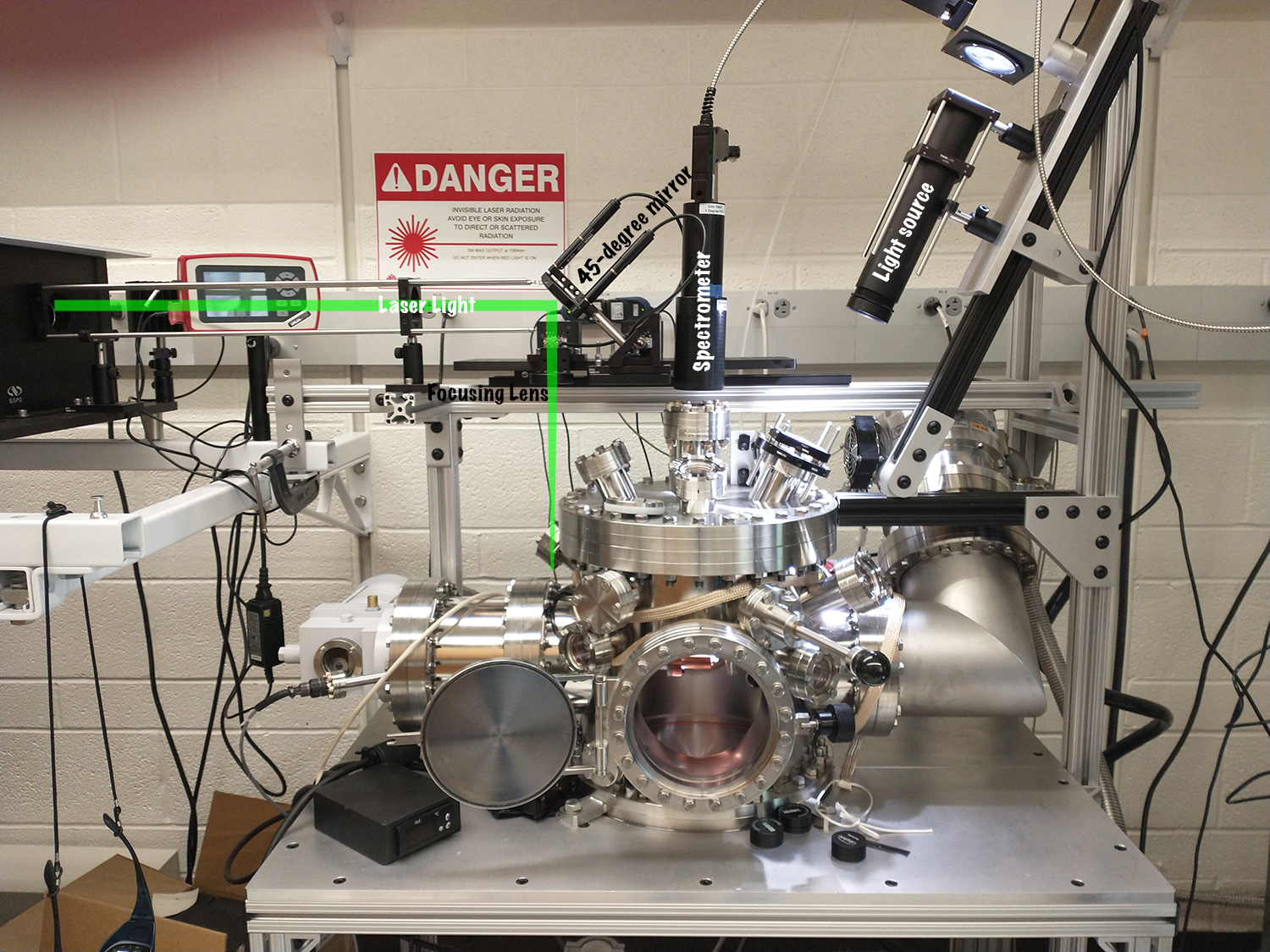
Figure 1. Dual laser weathering chamber and reflectance spectrometer facility. Light from both lasers is redirected down in to the UHV stainless steel chamber. As the light is redirected, it is focused on to the sample. The mirror is on pan and tilt actuators, which allow the laser light to be directed in X and Y. The shock wave generated from the laser plasma gardens the loose powder. Together, steering the beam and the stirring cause the 0.5 mg of simulant to be uniformly weathered. The 8-inch door to the chamber is open showing the sample holder. The holder is attached to a Trillium helium closed looped coldhead with dual temperature readout. The Osaka turbomolecular pump is on the right side.
How to cite: Gillis-Davis, J.: Dual Laser Method for Experimentally Weathering Planetary Regoliths, Europlanet Science Congress 2022, Granada, Spain, 18–23 Sep 2022, EPSC2022-1193, https://doi.org/10.5194/epsc2022-1193, 2022.
Introduction:
In our solar system, material mixing at large scales has been occurred due to the transportation of bodies at different heliocentric distances from the ones they were formed during major dynamical events, such as the giant planet instability. However, material mixing happens also at smaller scales at the surfaces of planets or small bodies during hypervelocity collisions, with the latter population acting as impactors. Since the small bodies in our solar system were formed in different locations and times they have diverse mineralogical composition which is reflected in their albedo values and in their spectral signature.
The most outstanding discovery of exogenous material was done by the OSIRIS-REx (NASA) and Hayabusa2 (JAXA) sample return space missions on the surfaces of the dark primitive near-Earth asteroids (NEA) Bennu and Ryugu respectively. The impact contamination should have happened while both asteroids were still residing in the inner Main Belt (IMB) before they were delivered to the near-Earth space. This is because of the large number of potential projectiles available and the time that Bennu and Ruygu spent in the IMB. OSIRIS-REx identified bright boulders with pyroxene composition compatible with the spectrum of the V-type asteroid Vesta [1]. Unlike with the contamination on asteroid Ryugu [2], the bright boulders of Bennu point to a unique impactor source, the family of Vesta in the IMB.
Methods and Results:
In order to study the impact contamination on Bennu’s parent body, we performed hypervelocity impact experiments at different speeds. As targets we used CM2 simulant rocks. Following the latest discoveries of the surface properties of asteroid Bennu [3] the new Bennu simulant targets were built with ~50% porosity, advancing from our pioneering work [4]. As impactors we used eucrite meteorite and forsterite olivine projectiles. In this work we demonstrated that eucrite material can be indeed effectively implanted on Bennu-like targets. We will present the experimental campaign using the 2-stage light-gas gun of the University of Kent, the crater analysis, the ejecta production and the material contamination.
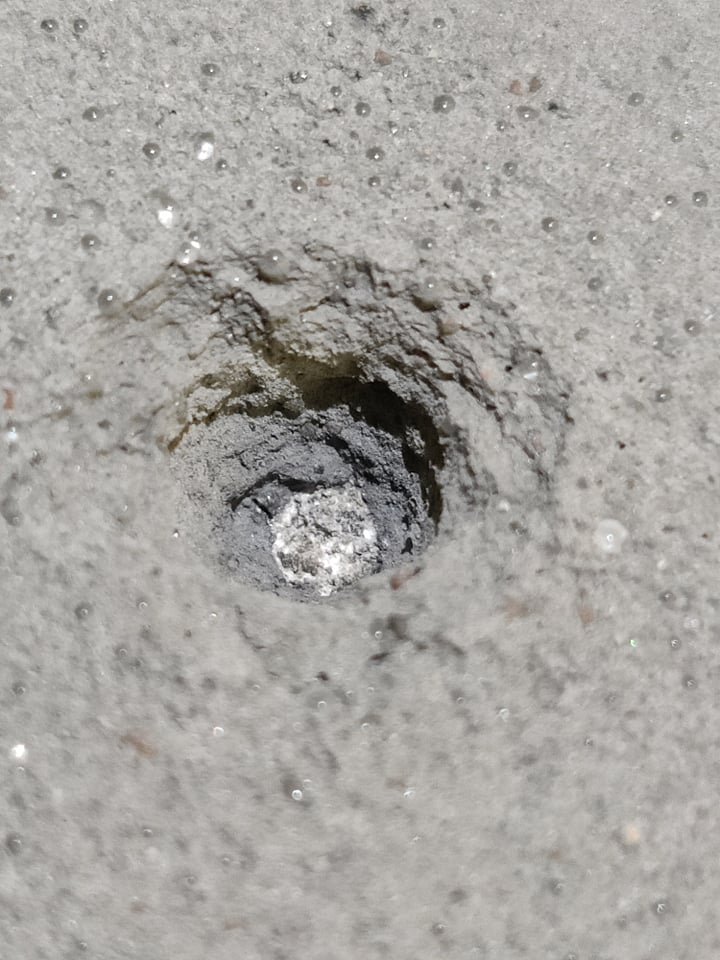
Fig 1: Eucrite projectile is embedded at the bottom of the crater on Bennu simulant material.
Acknowledgments: We acknowledge support from the ANR ORIGINS (ANR-18-CE31-13-0014).
References:
[1] DellaGiustina D. et al. 2021, Nature Astronomy, 5, p. 31-38
[2] Tatsumi E. et al. 2021, Nature Astronomy, 5, p. 39-45
[3] Cambioni S. et. al, 2021, Nature, 598, Issue 7879, p.49-52
[4] Avdellidou C. et al. 2020, Icarus, 341, article id. 113648.
How to cite: Avdellidou, C., Spathis, V., Finch, J., and Alesbrook, L.: Impact contamination on Bennu: an experimental investigation., Europlanet Science Congress 2022, Granada, Spain, 18–23 Sep 2022, EPSC2022-439, https://doi.org/10.5194/epsc2022-439, 2022.
Phyllosilicate minerals have been detected at Oxia Planum, the ExoMars landing site, which indicate this area has been subject to aqueous activity during the Noachian [1,2,3]. The aim of the ExoMars rover mission is to search for signs of past or present life at Oxia Planum and to characterise the geochemical environment [1]. Evidence of past life may include physical biosignatures such as fossilised cells or stromatolites, or chemical biosignatures, such as biominerals and organic molecules produced by biological activity (biomarkers) [1,4,5]. The rover will be equipped with a suite of instruments, such as Multispectral Panoramic cameras (PanCam), Close-up imager (CLUPI), Raman Laser Spectrometer (RLS), and Mars Organic Molecule Analyser (MOMA), the latter of which includes gas chromatography-mass spectrometry (GC-MS) and laser desorption/ionisation-mass spectrometry (LDI-MS) capable of detecting biomarkers [6,7,8,9].
Mineralogy plays a vital role in the preservation of organic molecules [10]. Phyllosilicate minerals have been shown to adsorb organic compounds on and between their layered structures [11,12], protecting them from degradation by radiation and oxidation [13]. Given the identification of phyllosilicate mineralogy at Oxia Planum, detecting biomarkers there is plausible. However, alteration of biosignatures may have occurred at Oxia Planum through a range of geological processes, such as impacts.
Geomorphological data of Oxia Planum indicates that extensive impact cratering has occurred, which would have altered the surface mineralogy, and may have modified any biomarkers present in the sediments [14]. However, organic molecules detected in impact craters on Earth have been shown to have survived the impact process [15] and impact experiments have shown impact energy, angle of ejection and mineralogy will influence the decomposition rate of organic molecules [16]. In addition, glasses formed by impact processing have been shown to trap organic components and aid their preservation [17, 18]. However, the elevated temperatures and pressures experienced during impact events can cause the modification of organic molecules, such as bond breaking and formation, thermal oxidation and racemization [19,20]. Depending on the reaction dynamics of these changes, these modifications may differ according to particular mineral hosts [20].
In this study, we perform laboratory impact experiments using the all-axis light gas gun (LGG), at the Open University, to understand the effects of impacts on the local mineralogy at Oxia Planum. These experiments use a mineralogical simulant for Oxia Planum, which is composed of a mixture of unaltered basaltic minerals, a phyllosilicate component, iron oxides and an amorphous component, representing the possible mineral assemblage at Oxia Planum[21].The LGG will expose the simulant to the high pressures and temperatures associated with planetary impacts at a range of velocities relevant to impacts at Oxia Planum. Samples taken of the simulant will be analysed using Near-IR, Raman and XRD analysis to assess the changes to its mineralogy. Here, we will present the preliminary results from these experiments, and will outline their application to understanding the survival of biomarkers at the Oxia Planum landing site.
[1] Vago et al., Astrobiology Vol 17 No. 6 and 7, 2017 [2] Carter et al., LPSC abstract Vol. 47 No. 2064 [3] Quantin-Nataf et al., Astrobiology Vol. 21 No. 3, 2021 [4] Parnell et al., Astrobiology Vol. 7 No. 4, 2007 [5] Simoneit et al., Origins of Life and Evolution of the Biosphere Vol.28 p. 475–483, 1998 [6]Coates et al., Astrobiology, Vol. 17 No. 6-7, 2017[7]Rull et al., Astrobiology, Vol. 17 No 6-7[8] Goesmann et al., Astrobiology, Vol. 17 No 6-7 [9]Josset et al., Astrobiology, Vol. 17 No 6-7[10] Wiseman et al., Geoderma Vol. 134 p. 109–118, 2006 [11]Kleber et al., European Journal of Soil Science Vol. 56 No. 717–725, 2005 [12] Pearson et al., Meteoritics & Planetary Science Vol. 37, p.1829-1833 (2002) [13] dos Santos et al., Icarus Vol. 277 p. 342–353, 2016[14] Roberts et al., Journal of Maps, Vol. 17 No. 2, 2021[15]Burchell et al., Astrobiology Vol. 14 No. 6, 2014[16] Bowden et al., Astrobiology Vol. 8 No. 1, 2009[17]Sapers et al., Earth and Planetary Science Letters Vol. 430 p.95–104, 2015 [18]Edwards et al., LPSC Vol. 40 No. 2524 [19] Bowden et al., Journal of Analytical and Applied Pyrolysis Vol. 82, p.312–314 (2008) [20] Furukawa et al., Orig Life Evol Biosph, Vol. 48 p.131–139. 2018[21] Dugdale et al., LPSC (2020)
How to cite: Dugdale, A., Ramkissoon, N., Fawdon, P., Patel, M., and Pearson, V.: Impact generated modification of the mineralogy at Oxia Planum, Europlanet Science Congress 2022, Granada, Spain, 18–23 Sep 2022, EPSC2022-851, https://doi.org/10.5194/epsc2022-851, 2022.
Introduction:
All models of Solar System formation indicate that all planetary bodies were exposed to intensive asteroid and comet bombardment during the first 700 myr after their formation. However, our current understanding of the early impact flux throughout the early Solar System is mainly based on studying lunar samples, because impact structures are much better preserved on the Moon than on Earth, and there is a lack of ancient samples from other planetary bodies. One of the fundamental research questions in planetary formation remains the exact timing and chronology of these large impact events.
Uranium-bearing materials, such as the minerals zircon, baddeleyite and phosphate, occur widely as accessory minerals in planetary materials. This fact, together with advances in ion probe dating techniques within the last decades, has made U-Pb dating of these minerals an important tool to understand the magmatic and impact history of the Moon. Several impact events were previously dated within zircon and phosphate grains from different Apollo landing sites, and an apparent cluster of ages around 3.94 to 3.92 Ga was noticed in the phosphate age distribution [e.g., 1, 2, 3]. However, in some cases, it remains uncertain whether the determined phosphate U-Pb ages represent actual impact events or are disturbed due to incomplete resetting of their U-Pb system during an impact event [e.g., 2, 3].
A solution to this problem lies in the thorough investigation of microstructures within the grains, which provide important information when interpreting U-Pb ages. Shock-recrystallized domains have been reported for several terrestrial and extraterrestrial zircon and baddeleyite grains [e.g., 4, 5], but little is known about microtextures and shock deformation in phosphate, despite of its wide application in geochronology. A few recent studies have examined shock-induced microstructures in phosphate in detail [e.g., 6, 7], but the shocked domains have not yet been linked to radiometric ages. Moreover, how shock deformation as the result of impact events leads to incomplete resetting of the U-Pb system in phosphate and zircon remains poorly understood.
Therefore, in this study detailed microstructural, isotopic and geochemical analyses of Ca-phosphates and zircon are combined to establish a precise chronology of impact events. Understanding the timing and intensity of impact events during the infancy of the Solar System is not only important for reconstructing the early crustal evolution of the Moon, but also to determine the formation, evolution, and habitability of planetary bodies.
Methods: For the purpose of this study, distinct impact breccias from the Apollo 14 landing site were selected (samples 14303, 14169, 14305, 14314, 14321, 14051, 14311). The Apollo 14 landing site is especially interesting, since it is still debated whether these samples originated from a single dominant impact event (i.e. the Imbrium basin) or several impact events.
The µXRF (Bruker M4 Tornado X-ray spectrometer), located at the Analytical, Environmental and Geochemistry (AMGC) department at the Vrije Universiteit Brussel (VUB), was used to obtain element maps of the thin sections with a resolution of 25 µm. These analyses yielded a first impression of the sample lithology and mineralogy. The thin sections were then carbon-coated and high-resolution backscatter electron (BSE) images (Fig. 1) and element maps were obtained of the entire thin section, as well as BSE images of the grains of interest (Fig. 2). These analyses were performed on a Zeiss Merlin Gemini II Fe-SEM (Scanning Electron Microscope) at the European Space Research and Technology Centre (ESTEC).

Figure 1.: Backscatter electron image of thin section 14311,9.
Preliminary results: As of the time of writing, several phosphate and zircon grains (with sizes ranging from app. 10 to 50 µm) were identified within the thin sections. As a next step, Cathodoluminescence (CL) images of the phosphate and zircon grains will be obtained at Utrecht University on a JEOL JXA-8530F Hyperprobe. Following this, Electron Backscatter Diffraction (EBSD) analyses will be performed at the University of Portsmouth with an Oxford Instruments Nordlys EBSD mounted on a Zeiss EVO MA 10 LaB6-SEM. The detection of microstructures will guide the selection of domains of the grains for U-Pb analyses.
U-Pb dating of the thin section in combination with the microtextural analyses will constrain the relationships between impact-induced Pb-loss, microtextural and chemical changes and allow us to unequivocally interpret the new U-Pb ages to date primary crystallization, impact events or to reflect partially reset ages.
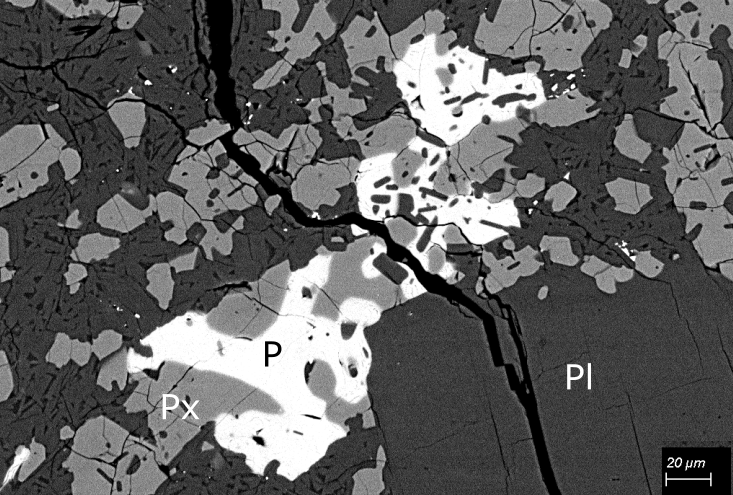
Figure 2. Ca-phosphate-grain intergrown with pyroxene and plagioclase. P – Phosphate, Pl – Plagioclase, Px – Pyroxene.
References:
[1] Snape J. F., Nemchin A. A., Grange M. L., Bellucci J. J., Thiessen F., and Whitehouse M. J. (2016). Phosphate ages in Apollo 14 breccias: resolving multiple impact events with high precision U–Pb SIMS analyses. Geochimica et Cosmochimica Acta, 174, 13-29.
[2] Thiessen F., Nemchin A. A., Snape J. F., Whitehouse M. J., and Bellucci J. J. (2017). Impact history of the Apollo 17 landing site revealed by U‐Pb SIMS ages. Meteoritics & Planetary Science, 52(4), 584-611.
[3] Merle R. E., Nemchin A. A., Grange M. L., Whitehouse M. J., and Pidgeon R. T. (2014). High resolution U‐Pb ages of Ca‐phosphates in Apollo 14 breccias: Implications for the age of the Imbrium impact. Meteoritics & Planetary Science, 49(12), 2241-2251.
[4] Cavosie A. J., Timms N. E., Ferrière L., and Rochette P. (2018). FRIGN zircon—The only terrestrial mineral diagnostic of high-pressure and high-temperature shock deformation. Geology, 46(10), 891-894.
[5] White L. F., Darling J. R., Moser D. E., Reinhard D. A., Prosa T. J., Bullen D., Olson D., Larson D. J., Lawrence D., and Martin, I. (2017). Atomic-scale age resolution of planetary events. Nature Communications, 8(1), 1-6.
[6] Černok A., White L. F., Darling J., Dunlop J., and Anand M. (2019). Shock‐induced microtextures in lunar apatite and merrillite. Meteoritics & Planetary Science, 54(6), 1262-1282.
[7] Kenny G. G., Karlsson A., Schmieder M., Whitehouse M. J., Nemchin A. A., and Bellucci J. J. (2020). Recrystallization and chemical changes in apatite in response to hypervelocity impact. Geology, 48(1), 19-23.
How to cite: Thiessen, F., Goderis, S., and Carpenter, J.: How reliable are lunar phosphate and zircon as geochronometers?, Europlanet Science Congress 2022, Granada, Spain, 18–23 Sep 2022, EPSC2022-532, https://doi.org/10.5194/epsc2022-532, 2022.
1. Introduction
The composition of a chondrite reflects the combination of chemical processes that produced the set of solid components at that nebular location and mechanical processes that led to the incorporation of variable amounts of these components into the chondrite [1]. Large difference in condensation temperature of about 200 K between Rh and Ir, have led to some variation in platinum group element (PGE) composition in chondrites during solar nebula condensation processes. Carbonaceous and non-carbonaceous (ordinary and enstatite) chondrites exhibit successively higher degrees of reduction combined with successively lower contents of refractory elements. These features, as discussed as early as the 1970s, are most likely related to formation at increasingly smaller radial distances from the Sun in hotter parts of the solar nebula. However, since analytical mass spectrometry techniques, with few exceptions, do not measure the monoisotopic element Rh in chondrites, there are significantly fewer data on Rh than Ir and Ru.
The fundamental dichotomy between carbonaceous and noncarbonaceous chondrite groups is shown in a Ru/Rh vs. Ir/Rh diagram (Figure 1). Ruthenium/Rh and Ir/Rh ratios are the best to distinguish chondrite groups [1-4].
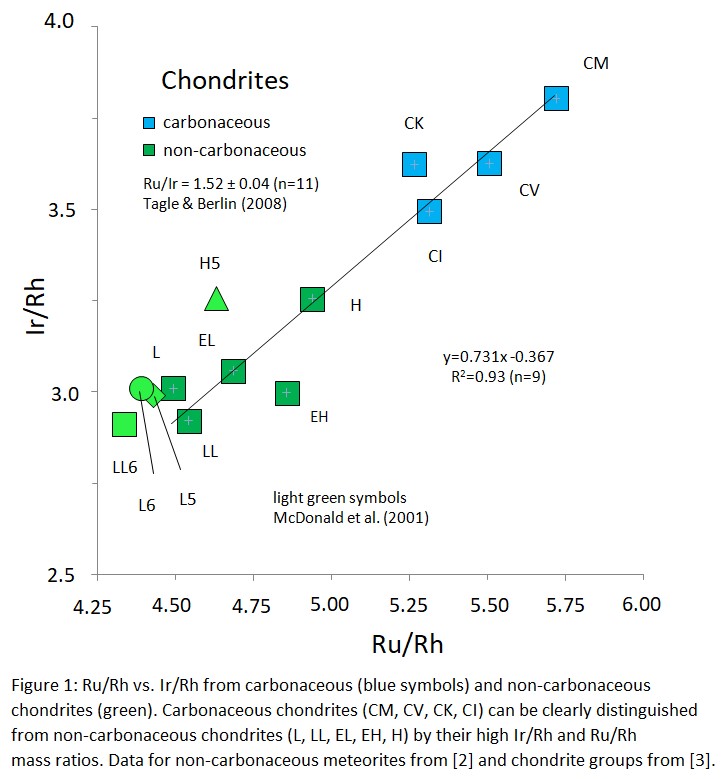
2. How to distinguish iron meteorites and chondrites?
Nonchondritic PGE ratios from some iron meteorite groups are most likely the result of fractional crystallization of a metallic liquid during core formation. Compositional differences in the chemistry of PGE from chondrites and iron meteorites (Figure 2) allow the rough identification of projectile types based on PGE traces in melt samples or fallback sediments from impact craters.
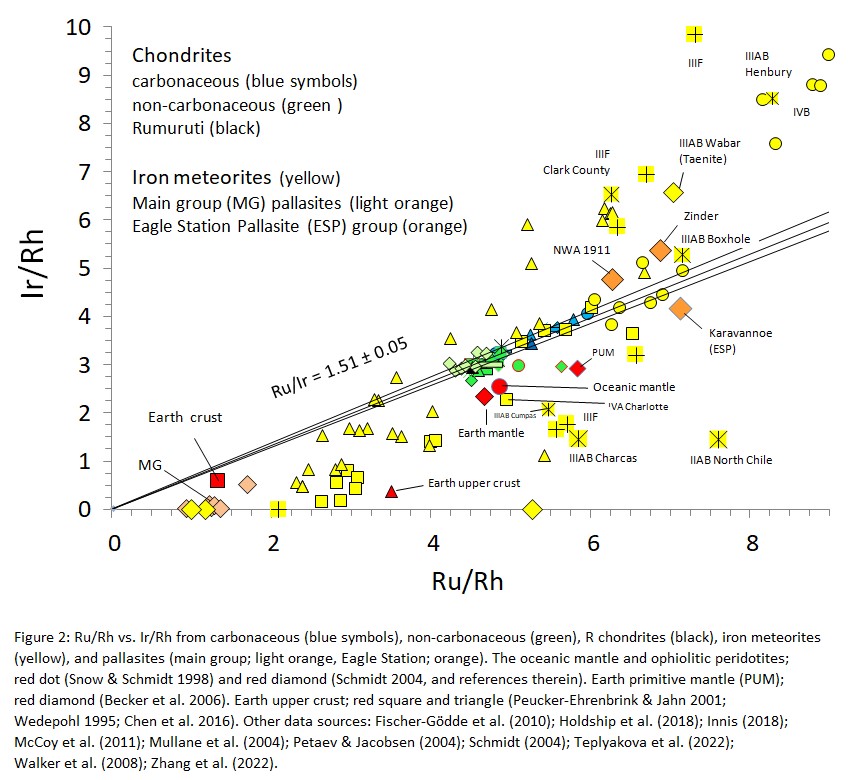
An indicator to distinguish chondrites from iron meteorites is there constant Ru/Ir ratio of 1.51 ± 0.05. However, some IVA (La Grange, Yanhuitlan, Maria Elena, Jamestown), IVB (Ternera, Skookum, Warburton Range), and IC (Arispe) irons also have Ru/Ir ratios of about 1.5 and thus cannot be distinguished from chondrites by their Ru/Rh and Ir/Rh ratios (Figure 3).
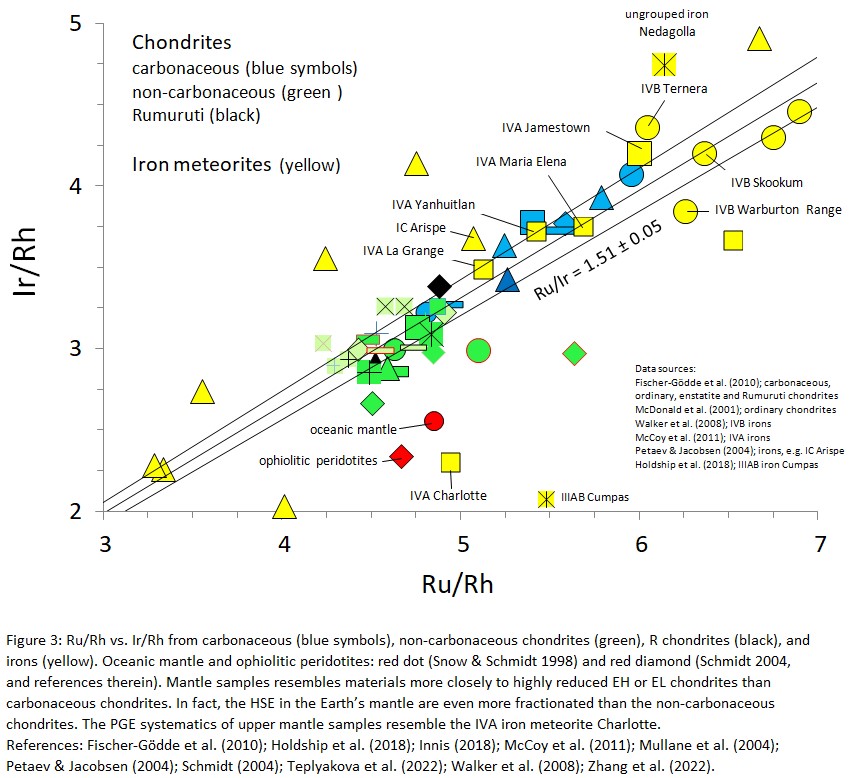
3. Identified iron meteoritic projectiles from large terrestrial impact craters
In melt samples from the Sääksjärvi impact crater in Finland CI-normalized abundances increase from the refractory to the more volatile siderophile elements (Ir < Ni). The trend is qualitatively similar to magmatic iron meteorites and corresponds to about 0.4% of a nominal magmatic iron meteorite component (e.g. IIIAB Tamarugal, see web version at RG) [5].
Non-chondritic PGE ratios in fallback sediments from the Chicxulub crater (Mexico) imply a meteoritic contribution equivalent to about 0.1% Mundrabilla-like iron [6].
Iron meteoritc normalized PGE, Ni and Au pattern of Clearwater East melt samples would imply a meteoritic contribution equivalent to about 0.6 to 1.2% IVA Gibeon-like iron [7], or an unknown chondrite (Palme 2019, personal communication).
Except the Morokweng impact structure in South Africa all large craters with diameters >1 km are formed by iron projectiles. Studies of PGE ratios in Morokweng samples suggested an ordinary chondrite as projectile (Figure 5)[2,8]. However, based on PGE, Au and Ni concentrations in Morokweng melt samples would imply a meteoritic contribution equivalent to about 0.4 to 0.8 % Gibeon-like iron (Figure 4). If no asteroid clast had been discovered, incorrect conclusions would be drawn based on PGE ratios alone.
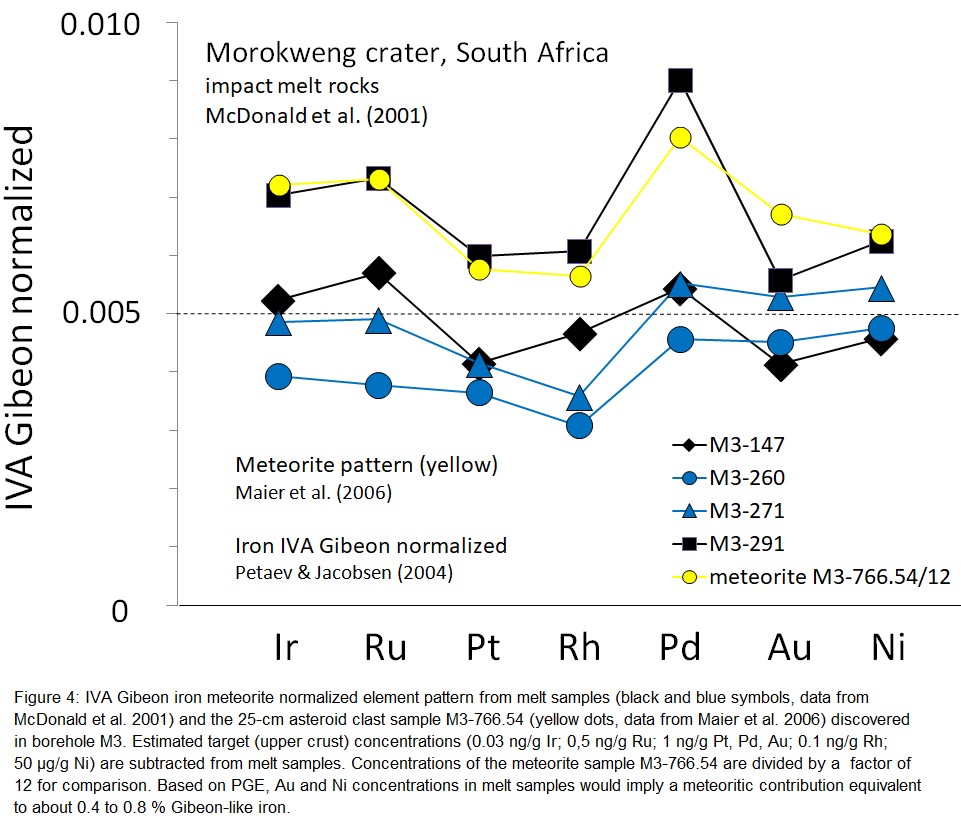
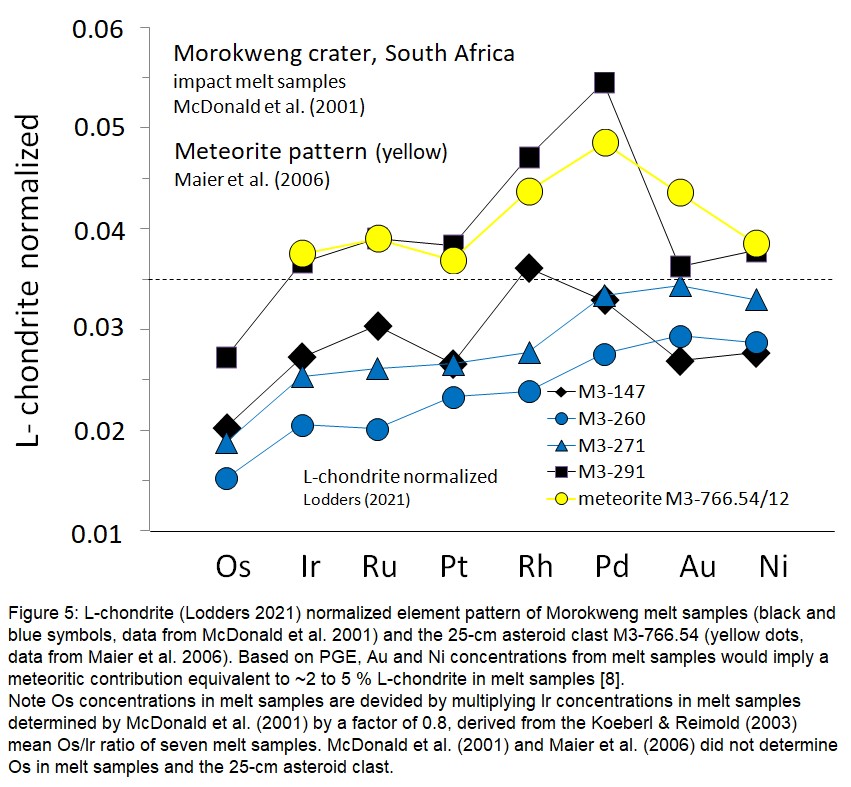
4. Iron meteorite PGE abundance pattern from the Earth mantle and crust
The elemental ratios or PGE patterns of oceanic peridotites and ophiolitic peridotites [9,10] agree with the IVA iron meteorite Charlotte (Figure 6). This agreement revives the discussion of whether the precious metal concentrations in the oceanic mantle can be explained by entrainment of the outer core by deep-seated mantle plumes or impact(s) after core formation. The PGE pattern of the Earth’s upper crust has shown to be similar to that of the IIIAB iron Grant and the pallasite Brenham.
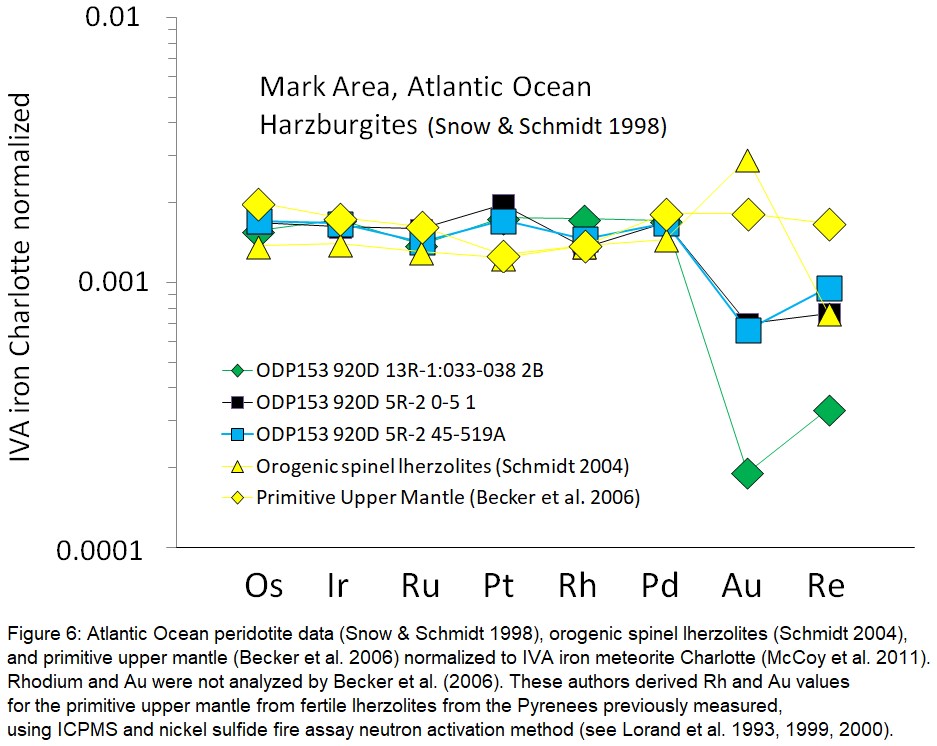
5. Future studies
Progress in more precise identification of impactors can probably only be made by combining meteorite science and astrophysics. Comparing the Ru isotopic composition of impact melts with that of meteorites could therefore provide important clues to the origin of projectiles and with some limitations, could be used as a powerful analytical tool [11] alongside diagnostic Ru/Rh and Ir/Rh mass ratios to identify impactor signatures.
References
[1] Wasson J. T. (1985) Meteorites - Their Record of Early Solar-System History. Freeman & Company, New York, 267pp.
[2] McDonald I., Andreoli M. A. G., Hart R. J. & Tredoux M. (2001) Platinum-group elements in the Morokweng impact structure, South Africa: Evidence for the impact of a large ordinary chondrite projectile at the Jurassic-Cretaceous boundary. Geochimica et Cosmochimica Acta 65, 299-309.
[3] Tagle R. & Berlin J. (2008) A database of chondrite analysis including platinum group elements, Ni, Co, Au, and Cr: implications for the identification of chondritic projectiles. Meteoritics & Planetary Science 43, 541 - 559.
[4] Fischer-Gödde M., Becker H. & Wombacher F. (2010) Rhodium, gold and other highly siderophile element abundances in chondritic meteorites. Geochimica et Cosmochimica Acta 74, 356-379.
[5] Schmidt G., Palme H. & Kratz K.-L. (1997) Highly siderophile elements (Re, Os, Ir, Ru, Rh, Pd, Au) in impact melts from three European craters (Sääksjärvi, Mien and Dellen): clues to the nature of the impacting bodies. Geochimica et Cosmochimica Acta 61, 2977-2987.
[6] Schmidt G. (2022) Identification of iron meteorites as projectiles from large impact craters. 53rd Lunar and Planetary Science Conference, #1272.
[7] Schmidt G. (2019) Re-investigation of projectile types from terrestrial impact craters – Hiawatha (Greenland), Popigai (Siberia), Clearwater East, Brent, Wanapitei (Canada), Gardnos (Norway), Rochechouart (France), Ries (Germany), EPSC-DPS Joint Meeting 2019, EPSC-DPS2019-4.
[8] Koeberl C. & Reimold W. U. (2003) Geochemistry and petrography of impact breccias and target rocks from the 145 Ma Morokweng impact structure, South Africa. Geochimica et Cosmochimica Acta 67, 1837 - 1862.
[9] Snow J.E. & Schmidt G. (1998) Constraints on the Earth accretion deduced from noble metals in the oceanic mantle. Nature 391, 166-169.
[10] Schmidt G. (2004) Are high-temperature fractionations in the solar nebula preserved in highly siderophile element systematics of the Earth’s mantle? Meteoritics & Planetary Science 39, 1995 - 2007.
[11] Fischer-Gödde M., Burkhardt C., Kruijer T. S. & Kleine T. (2015) Ru isotope heterogeneity in the solar protoplanetary disk. Geochimica et Cosmochimica Acta 168, 151-171.
How to cite: Schmidt, G.: Composition of large asteroids collided with the Earth, Europlanet Science Congress 2022, Granada, Spain, 18–23 Sep 2022, EPSC2022-106, https://doi.org/10.5194/epsc2022-106, 2022.
The idea of commercially exploring small asteroids in the neighborhood of the Earth-Moon is not new. The interest in such minor objects is due to the fact that many of them have high concentration of metals and volatile (Elvis 2012, 2014), especially water. Exploratory missions could collect water from a near-Earth asteroid (NEA) and transfer it to a lunar orbit, where it could be used to produce fuel for rockets, to maintain human population in space systems, from which round-trip trajectories to other bodies in solar system would be less costly (Sercel 2017, Jedicke 2018, Steklov 2019). However, whether in terms of asteroid resource mining or to improve the scientific techniques for extraction, processing and storage of materials from low-gravity bodies, the cis-lunar space has been considered as a good location (Brophy et al. 2012, Mazanek et al. 2016, Jedicke et al 2018).
We numerically investigate the evolution and fate of ejecta produced by a supposed impact of an artificial projectile with a small asteroid or a boulder from it. In this scenario, we develop an idealized, realistic model to set up the initial state of the ejected particles, considering ejecta released at speeds at or below 1ms−1 from those stable Distant Retrograde Orbits previously determined by Pires & Winter (2020). The purpose of this study is to verify how much material might be delivered to the Earth or to the Moon, besides collision time relative to the position it was ejected in orbit. Our approach allows to gain insight into the dynamics of ejecta clouds generated by mining asteroids in the Earth-Moon vicinity. We verify how long do particles take to fall on each body. The time it took for particles to collide with massive bodies is an important measure when we deal with the realistic prediction of moving material as a result of impact cratering events or for human deflection. Regardless of the ejection speed, particles that fall on the Earth or on the Moon, completed they journey in less than 5 years after being launched into space, or take more than 500 years to have about 1% of them colliding with both bodies. Between 5 and 500 years, the number of collisions is practically null. Most part of the low-speed regolith are lost to space. They escape the system as time advances. The process of loss of ejecta is stronger at the beginning of the numerical simulations and goes to approximately 10 years. There were a sample of ejected particles that remain bounded to the Earth-Moon system during the whole time of numerical simulations (10 K-years). Our methodology is based on several numerical simulations of ejecta using an N-Body code to calculate their evolution accounting its gravity interaction with the massive bodies: the Earth and the Moon, beyond the Sun. Our numerical simulations inputs covers a small range of low-speed ejecta as a result of impact cratering events. We have come up with results that have shown impact ejecta moving at speeds of order millimeter to meters-per-second reach the Earth or the Moon very quickly (less than 5 years) for a given range of initial conditions and assumptions. We will present our main results in terms of histograms and orbital evolution.
How to cite: Pires dos Santos, P. M., Winter, O. C., and Amarante Luiz, A.: Analysis of the evolution of particles ejected from Lunar Distant Retrograde Orbits, Europlanet Science Congress 2022, Granada, Spain, 18–23 Sep 2022, EPSC2022-718, https://doi.org/10.5194/epsc2022-718, 2022.
Introduction: The morphology of impact craters depends on the target properties, including changes in density, strength, water content, porosity, and composition (e.g., [1,2,3]), allowing in turn to study the interior of planetary bodies.
Along with naturally formed impact structures, there are a number of artificial craters, produced by a metallic module while the main spacecraft observes the process and the impact products [4]. One benefit of this method is that the initial impact energy is well known, and therefore any variation with respect to the expected shape depends on the target properties only. Spacecrafts crushing on planetary surfaces at the end of their operative life can also provide valuable information on the target material properties and near-surface stratigraphy, when they are imaged by subsequent space missions [5].
In this work, we analyze the formation of the crater formed by the NASA MESSENGER spacecraft, which impacted on the Hermean surface on April 2015. We investigate the artificial crater via numerical modelling by testing several targets scenarios, and discussing the outcomes in view of a possible future observations [6].
Methods: Numerical models have been carried out with the iSALE shock physics code [7, 8, 9, 10], which is well tested against laboratory experiments and other hydrocodes [11].
We approximate the MESSENGER spacecraft as an aluminum cylinder, which is described by the aluminum Tillotson Equation of State and the Johnson-Cook strength model), and has impact velocity of ~4 km/s, and impact angles of 30°, 45°, and 90°.
The impact location is within the Suisei Planitia, a poorly cratered smooth plains located north-east of Caloris basin [12], and it is assumed of basaltic composition. The surface is approximated as a two-layer target, composed by a lower crust layer described by a pressure and damage-dependent strength model [9], overlaid by a regolith layer, described by the Drucker-Prager strenth model. The thickness of the upper regolith layer was varied from 0 (one layer) up to 20 m. Several strength and inner friction values have been tested. The porosity was set to 40% and 10% for the regolith and the crust, respectively. We tested surface temperature of 440 K and 700 K, while no thermal gradient was implemented within the target.
Results: In Fig. 1, we compare the formation of the MESSENGER crater, when considering (on the right) or not (on the left) the presence of an upper regolith layer.
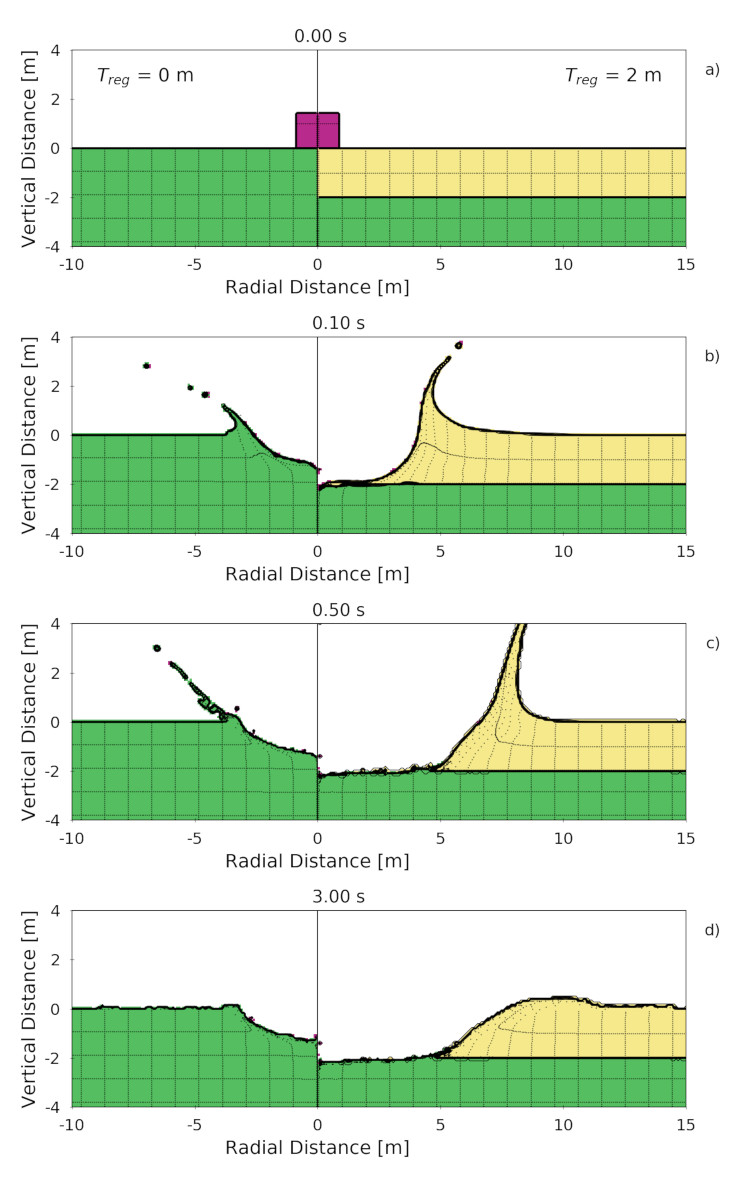
Fig. 1. Comparison of time series models, with a regolith thickness of 0 m (left) and 2 m (right). The colour map refers to the three different materials used: fuchsia for the projectile, green for the basaltic crust, and pale yellow for the regolith.
Generally, we found that craters forming in competent rock surfaces are <10 m wide, and about 1 m deep. In two-layer targets, with a thin upper regolith layer (1 to 2 m), the final craters display a flat floor morphology, where the flat bottom occurs in correspondence of the transition between the rheologies governing the two layers. Craters can be as much as about 20 m in diameter, and 2 m deep. In the case of thick regolith layers (>5 m), the crater develops entirely in the upper regolith layer, and thus their final shape depends on the regolith properties. The diameter is about 20 m, and they can be as deep as about 4 m.
Discussion and Conclusion: In this work, we present the preliminary results of the systematic analysis of an aluminum cylinder, with the same mass of the MESSENGER spacecraft, impacting on one- and two-layered targets. The investigation was focused on testing the effects of the target properties on the final crater morphometry. Depending on the model setup, we found a crater diameter ranging from 5 to 20 m, and a crater depth from 1 to 4 m.
The ultimate goal of this study is to verify whether the crater formed by the crushing of the MESSENGER spacecraft might be observed by the Spectrometers and Imagers for MPO BepiColombo Integrated Observatory SYStem (SIMBIO-SYS) [6], which is the imaging system onboard the ESA BepiColombo mission [13, 14]. SIMBIO-SYS is made up by a high resolution imaging channel (HRIC, resolution of 5 m/pix at periherm), a VIS–NIR spectrometer (VIHI), and a stereo imaging channel (STC) that will provide panchromatic 3D global mapping and colour imaging of selected regions of the Hermean surface, with a spatial resolution lower than 110 m.
Given the instrument performances and the results obtained from the numerical modelling, the MESSENGER crater might be observed by the only high-resolution channel, in the case that the near-surface stratigraphy of the Suisei Planitia is made up by a thick layer of regolith. We are going to investigate the ejecta distribution, in order to increase the MESSENGER crater observability.
Acknowledgments: We gratefully acknowledge the developers of iSALE‐2D/Dellen version (https://isale-code.github.io), including Gareth Collins, Kai Wünnemann, Dirk Elbeshausen, Tom Davison, Boris Ivanov, and Jay Melosh. Some plots in this work were created with the pySALEPlot tool written by Tom Davison.
This activity has been realized under the BepiColombo ASI-INAF contract no 2017- 47-H.0.
References: [1] Melosh H.J. (1989) Impact Cratering: a geological process, Oxford Univ. [2] Collins G.S. et al. (2012) Elements 8, 25–30. [3] Cintala M.J. et al. (1977) Proc. Lunar Planet. Sci. 8, 3409–3425. [4] Colaprete et al (2012) Space Sci. Rev. 167, 3−22. [5] Stooke P.J. (2019) Icarus 321, 112−115. [6] Cremonese G. et al. (2020) Space Sci. Rev. 216, 75. [7] Collins G.S. et al. (2016) iSALE-Dellen manual, figshare. [8] Amsden A.A. et al. (1980) Los Alamos Nat Lab Rep LA−8095, 101 pp. [9] Collins G.S. et al. (2004) Meteorit. Planet Sci. 39, 217-231. [10] Wünnemann K. et al. (2006) Icarus 180, 514-527. [11] Pierazzo E. et al. (2008) Meteorit. Planet. Sci. 43, 1917-1938. [12] Guzzetta L. et al. (2018) Mercury: Current and Future Science of the Innermost Planet, Abstract #6107. [13] Benkhoff J. et al. (2021) Space Sci. Rev. 217, 90. [14] Murakami et al. (2020) Space Sci. Rev. 216, 113.
How to cite: Martellato, E., Luther, R., Da Deppo, V., Benkhoff, J., Casini, C., Slemer, A., Palumbo, P., Rotundi, A., and Cremonese, G.: NASA MESSENGER mission: a tool to study Mercury beyond its operative life, Europlanet Science Congress 2022, Granada, Spain, 18–23 Sep 2022, EPSC2022-1261, https://doi.org/10.5194/epsc2022-1261, 2022.
1. Introduction
Seismic waves can be applied to study the interior of a body, as was done during the Apollo missions on the Moon [e.g. 1] or during the InSight mission on Mars [e.g. 2]. Recent numerical simulations using the iSALE shock physics code have been applied to study seismic signals in the frame of both missions, and for signals in samples from laboratory experiments [3-6].
In the NEO-MAPP project (Near Earth Object Modelling and Payloads for Protection) by the EC, Horizon 2020, a potential lander with a seismometer is discussed to study the characteristics of the interior of an asteroid (i.e. layering, mechanical properties, size of heterogeneities in the subsurface). Although possible natural sources for seismic waves on an asteroids exist (e.g. tidal forces, meteoroid impacts), we focus on studying an artificial impact of a spacecraft, which is better constrained and plannable.
2. Method
We use the iSALE shock physics code [7-9] to conduct a systematic parameter study by simulating different impact scenarios. iSALE enables to describe the resistance of rocks against deformation and the thermodynamic response to compression by different material models. We use a Lundborg rheology with a coefficient of friction of 0.77 and a cohesion of 1.4 kPa. We vary target porosities between 10 - 50%. We use the ANEOS for basalt. These material properties reflect the strength of regolith simulant, which was used for laboratory impact experiments [e.g. 10]. iSALE was validated against these experiments recently [11].
Our study on impact-induced seismicity on asteroids focuses on DART-scale kinetic impactor scenarios and we analyse the seismic signal generated by a 600 kg impactor at 6 km/s.
3. Results
We observe a decay of the peak pressure (i.e. P-wave in the elastic regime) with distance for targets with increasing porosity from 10 – 50% (Figure 1). Due to the energy consumption by pore compaction, the decay of pressure occurs closer to the impact point for a more porous target. We quantify the attenuation of the signal with distance r as shown by [3] with the help of the quality factor Q, which describes the decay of the amplitude A of the seismic wave as:
A(r) = A0 e -b r ,
where b is a material parameter, which relates the quality factor to the length λ of the pressure pulse as:
b = π / ( Q λ ).
Figure 1: Peak pressure decay with distance for targets with a cohesion of 1.4 kPa.
We observe a slight increase of the quality factor from 1.8 – 3.8 with increasing porosity (Figure 2).
Figure 2: Quality factors for granular homogeneous targets, and for competent rocks [3,12].
4. Discussion
Our results are in line with expectations that seismic waves on asteroidal targets, like the granular regolith materials that we simulated in this study, attenuate faster than more consolidated materials. Comparing our results with simulations assuming competent rock as target [3,12] shows that our determined quality factors are smaller by an order of magnitude than the numerically and experimentally derived values for quartzite, sandstone and tuff, which vary in porosity from 0 – 42%. The dampening of the seismic signal in a granular target is more efficient. However, this also implies that the seismic behaviour on monolithic asteroids is different to the one on rubble pile asteroids.
5. Outlook
We aim at analysing further materials. More specifically, we plan to expand our study to heterogeneous targets, where we resolve boulders explicitly. We expect that the presence of boulders causes more complex wave patterns in the interior, depending on the presence or absence of large scale voids and boulders.
Acknowledgements
We gratefully acknowledge the developers of iSALE (www.isale-code.de). We acknowledge the funding from the European Union’s Horizon 2020 research and innovation program under grant agreement No. 870377 (NEO-MAPP).
References
[1] M. Knapmeyer, Planetary Seismology, Landolt-Börnstein 4A, 2009.
[2] P. Lognonné et al., Space Sci. Rev. 215, 2019.
[3] N. Güldemeister and K. Wünnemann, Icarus 296 , 15-27, 2017.
[4] Wójcicka et al., JGR Planets 10.1029/ 2020JE006540, 2020.
[5] Rajšić et al., JGR Planets 10.1029/2020JE006662, 2021.
[6] Rajšić et al., E&SP 10.1029/2021EA001887, 2021.
[7] A. Amsden, H. M. Ruppel and C. W. Hirt, LANL, LA-8095, 101, 1980.
[8] G. S. Collins, H. J. Melosh and B. A. Ivanov, M&PS 39, 217-231, 2004.
[9] K. Wünnemann, G. S. Collins and H. J. Melosh, Icarus 180, 514-527, 2006.
[10] S. Chourey et al., PSS, 194, 2020.
[11] R. Luther et al., PSJ, 2022, under review.
[12] F. Hoerth et al., JGR: Planets, 119, 2177-2187, 2014.
How to cite: Luther, R. and Wünnemann, K.: Simulating the Seismic Signal from Impacts on Asteroids, Europlanet Science Congress 2022, Granada, Spain, 18–23 Sep 2022, EPSC2022-1208, https://doi.org/10.5194/epsc2022-1208, 2022.
1. Introduction
Asteroid impacts, ranging from small-scale cratering events to catastrophic disruption, have played a crucial role in the formation and evolution of asteroids (Jutzi et al., 2015). Thanks to the increasing performance of computers, shock-physics numerical codes have become commonly used in the field of hypervelocity impacts, to extrapolate experimental results and help us be better prepared for space missions devoted to asteroid deflection using the kinetic impactor techniques, such as the NASA DART (Rivkin et al. 2020) and ESA Hera missions (Michel et al. 2022), and evaluate the outcomes.
Past numerical studies showed us that it is possible to divide the asteroid impact process into two stages that occur at very different time scales, the early stage of fragmentation of the asteroid and the late stage of gravitational reaccumulation of the fragments (e.g, Michel et al. 2001). For the early stage, various numerical methods have been developed to solve this short but extreme physical process, such as the Smooth Particle Hydrodynamics (SPH) technique used in codes like the Bern SPH and grid techniques used in codes like CTH or iSALE. Each method has its unique advantages, but they share a common challenge that the contact and the boundary condition are not well handled (El Mir et al., 2019).
In this study, we exploit the Material Point Method (MPM) framework, an extension of the particle-in-cell method, to simulate the early stage of impact in order to offer a new approach and solutions to the above problems.
2. Methods
MPM is a meshfree method, characterizing the material domain by a group of points. These Lagrangian material points carry all state variables. Meanwhile, a predefined regular background grid is used. In each timestep, material information is mapped to grid nodes, to solve the momentum equations, and material points deform with the grid. Then the information is mapped back to the points to update their positions and velocities, discard the deformed grid, and reset a new one to calculate the next timestep (Zhang et al., 2013). MPM framework combines the advantage of both Lagrangian description and Eulerian description, which not only avoids the undesirable mesh tangling caused by large deformations, but also eliminates the difficulties in solving contact and boundary conditions.
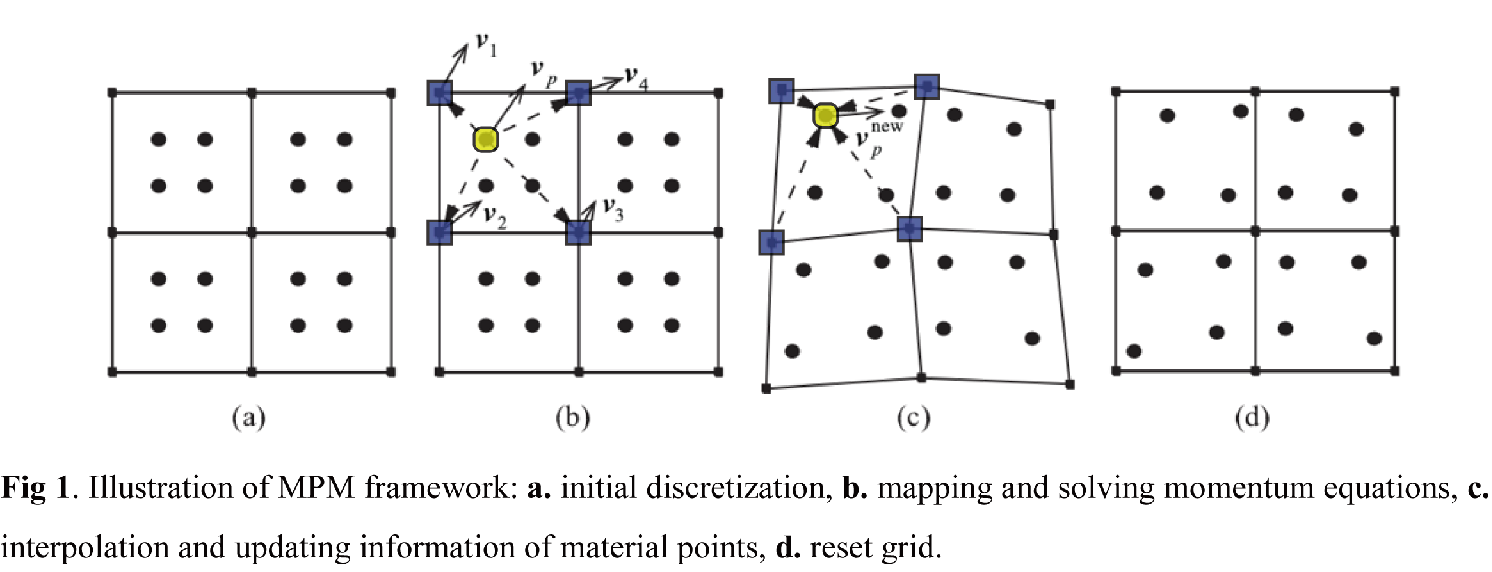
As such, MPM is well used in simulating impacts, explosions, and metal forming of on-earth situation (Zhang et al., 2013). So far, it has not been commonly used to model hypervelocity impacts on asteroids (El Mir et al., 2019). Hence, we start with building material models that are applicable to asteroids made of porous and brittle materials.
The material models include Drucker-Prager strength model that describes cohesion and pressure-dependent strength effect. We also use the Tillotson equation of state for basalt coupled with the P-alpha model which accounts for porosity, and as stress-based failure criterion consistent with Weibull distribution. The framework is thus similar to that used by other studies using the SPH numerical method (Raducan and Jutzi, 2021). Our MPM model is then validated by comparing with laboratory impact experiments and the simulations using the SPH method.
3. Results
We compare our simulations with SPH simulations (Benz & Asphaug, 1994) and the impact experiments (Nakamura et al., 1991) on non-porous basalt sphere used to validate them. Our result shows that our material model under the MPM framework can successfully characterize the shell-like propagation of the failure zone (Fig 2.c2). However, a concentration of stresses reflected back from the boundary subsequently occurres, resulting in a severe secondary failure in the nuclear region. (Fig 2.c3) This stress concentration may cause by the unsmooth discrete boundary and the lack of energy dissipation. The analysis of large fragments reveals this problem too: although with a similar mass distribution, the velocity of the largest fragment in MPM simulation is significantly higher (Fig 3.a). Apart from that, the simulation results are otherwise in good agreement with the previous studies, especially the shape of the largest fragment of MPM simulation (Fig 3.b) versus a recent experiment (Fig 3.c). Noting the usual spreading in experimental outcomes using same conditions, the MPM method can thus be considered valid.
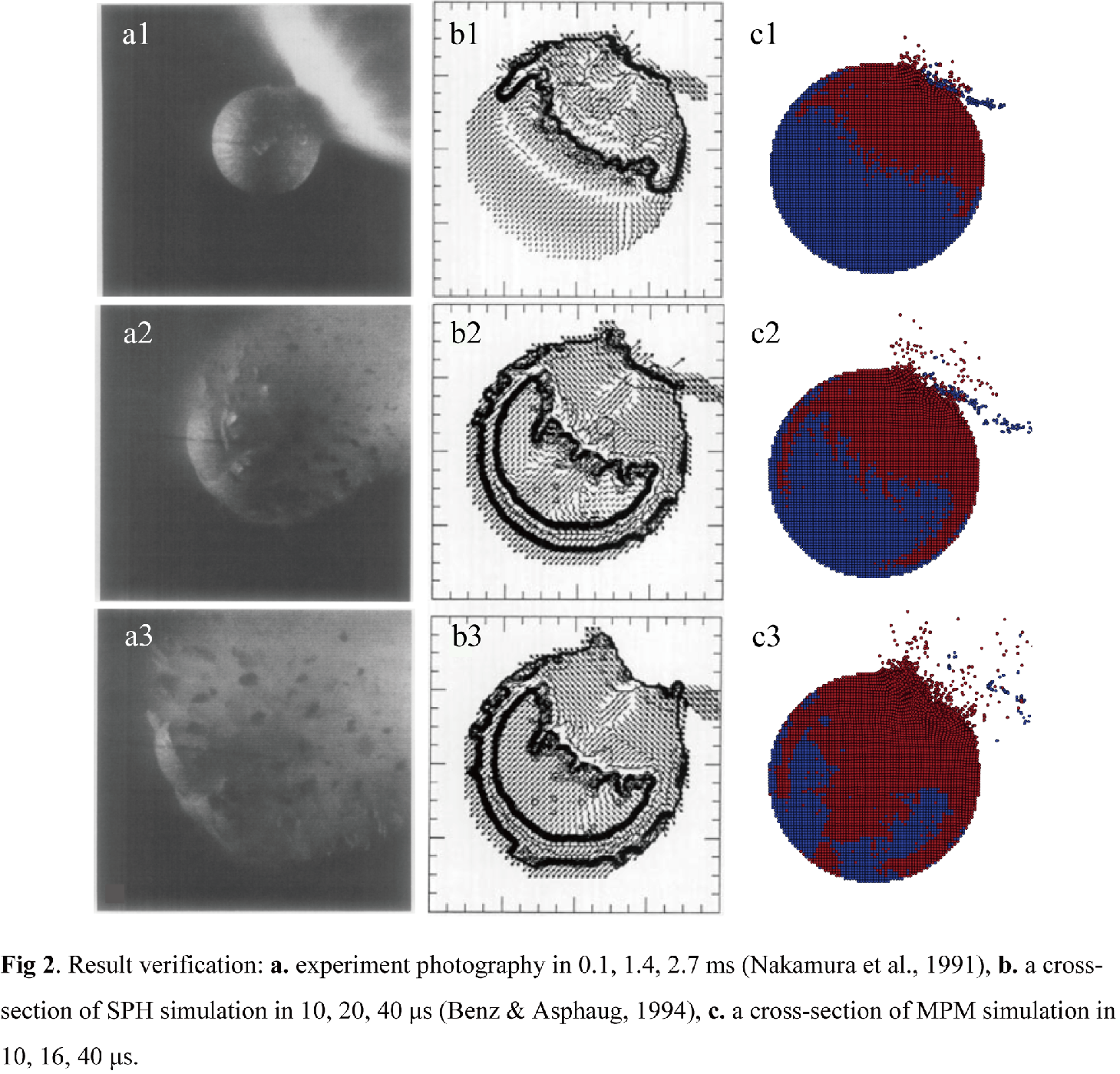
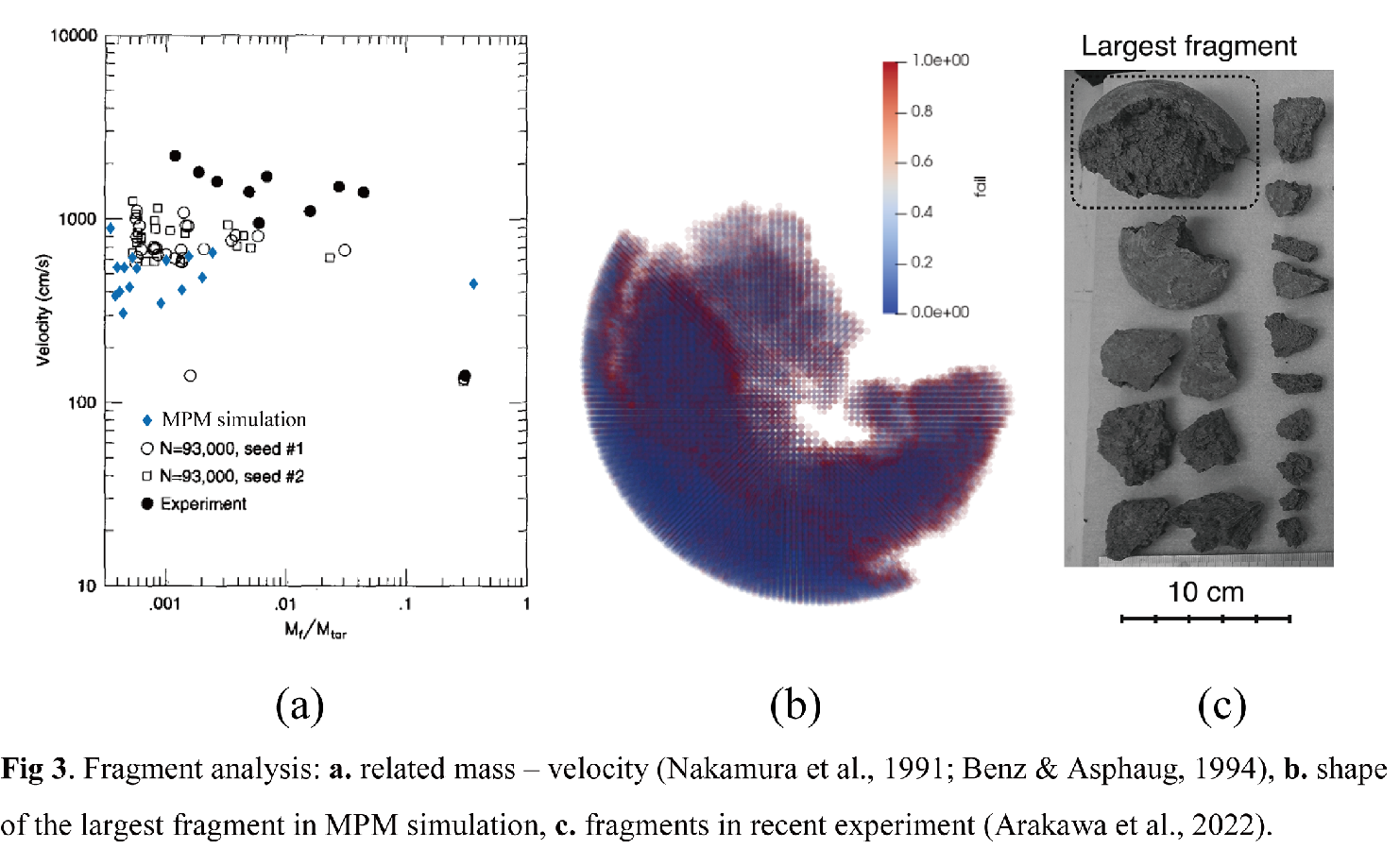
Further research will be centered on verifying the P-alpha model and the correct treatment of porosity (Jutzi et al., 2009).
4. Conclusion and Discussion
The MPM framework can complement of other shock-physics code to balance the accuracy and efficiency of calculation. Furthermore, the mentioned features of solving contact and boundary conditions with MPM broadens the application of the simulation algorithm in the hypervelocity impact stage, and may make it easier than SPH models to combine with the Soft-Sphere Discrete Element Method (SSDEM) code (Fig 4) to simulate the two-stage impact process (SPH-SSDEM method refers Zhang et al., 2021).
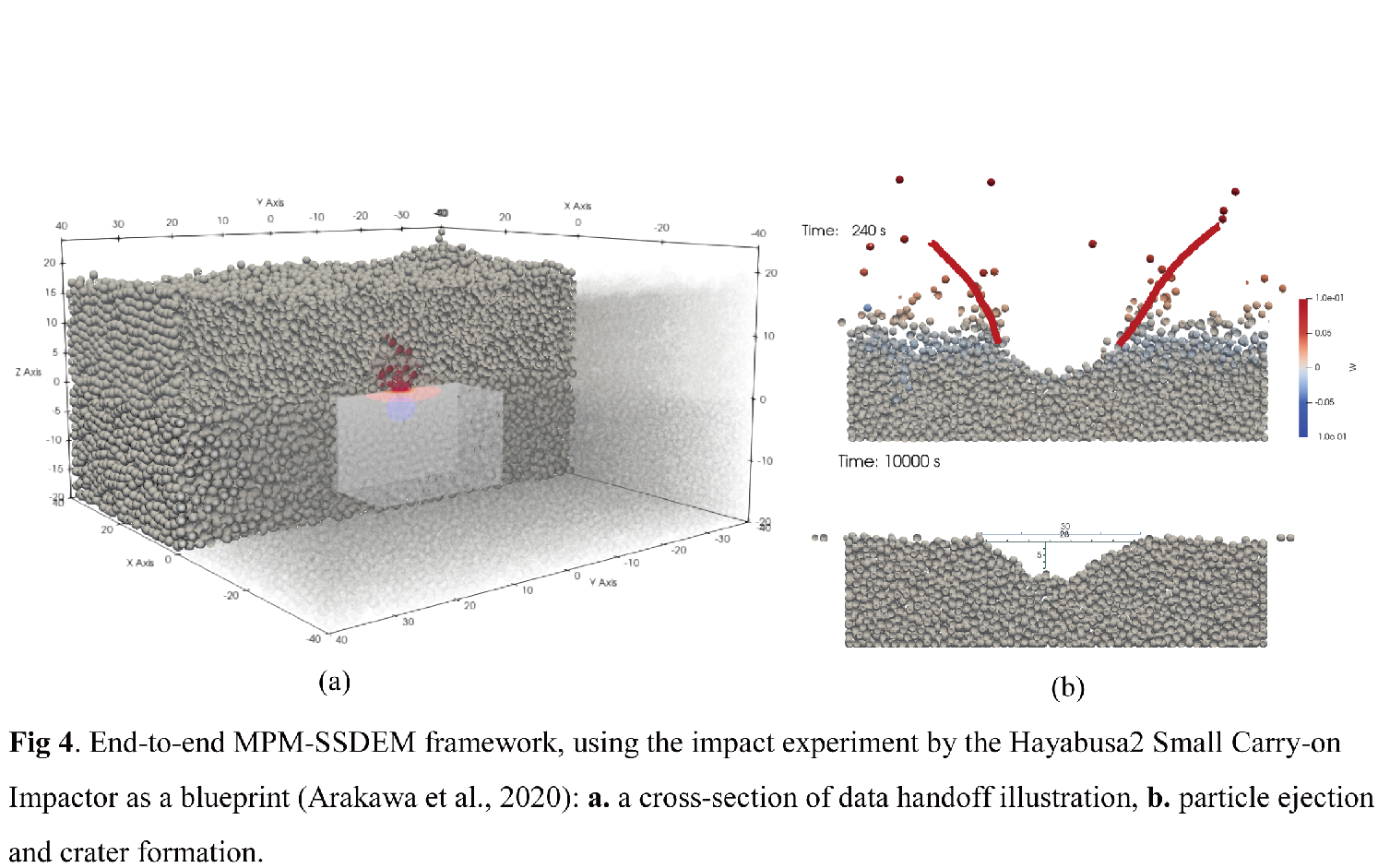
All these studies will offer a glimpse into the active processes from the early formation of the solar system to the current epoch, and contribute to planetary defense.
Acknowledgements:
We acknowledge support from the Université Côte d’Azur. X.Y. acknowledges support from Tsinghua University, funding from the Chinese Scholarship Council, and the National Natural Science Foundation of China (No. 11872223). P.M. acknowledges funding from CNES, from the European Union’s Horizon 2020 research and innovation program under grant agreement No. 870377 (project NEO-MAPP) and from the CNRS through the MITI interdisciplinary programs.
References:
Arakawa, M. et al. (2020) Science, 368, 67–71.
Arakawa, M. et al. (2022) Icarus, 373, 114777.
Benz, W., & Asphaug, E. (1994) Icarus, 107(1), 98–116.
El Mir, C. et al. (2019) Icarus, 321, 1013–1025.
Raducan, S.D. & Jutzi, M. (2021) 52nd LPSC, #1900.
Jutzi, M. et al. (2009) Icarus, 201(2), 802–813.
Jutzi, M. et al. (2015) In: Asteroids IV (Michel P. et al., eds.) 679–699.
Michel et al. (2001) Science, 294, 1696-1700.
Michel et al. (2022) Planetary Science Journal, accepted.
Nakamura, A., & Fujiwara, A. (1991). Icarus, 92, 132–146.
Rivkin, A. et al. (2020) Planetary Science Journal, 2, 173.
Zhang, X. et al. (2013) Beijing: Tsinghua University Press.
Zhang, Y. et al. (2021) 52nd LPSC, #1974.
How to cite: Yan, X., Liu, Y., Zhang, Y., Michel, P., and Li, J.: Hypervelocity impact simulation on asteroids with MPM framework, Europlanet Science Congress 2022, Granada, Spain, 18–23 Sep 2022, EPSC2022-1064, https://doi.org/10.5194/epsc2022-1064, 2022.
Introduction
The flux of interplanetary matter hitting our planet can be analyzed by studying the flashes generated when meteoroids impact the lunar ground at hyperspeed regime. Our team at the Institute of Astrophysics of Andalusia (IAA-CSIC) has been involved in the observation and analysis of these impact events since 1997 [1]. Since then, impact flashes have been unambiguously detected during the peak activity of several major meteor showers by using this technique, and flashes of sporadic origin have been also recorded [2].
For the detection of lunar impact flashes we have employed telescopes endowed with high-sensitivity CCD video cameras. Most of our telescopes are Schmidt-Cassegrain instruments with an aperture ranging between 28 to 50 cm, although some observational campaigns have been also performed with much larger instruments, such as, for instance, the 3.5 m telescope located at the Calar Alto Observatory [3].
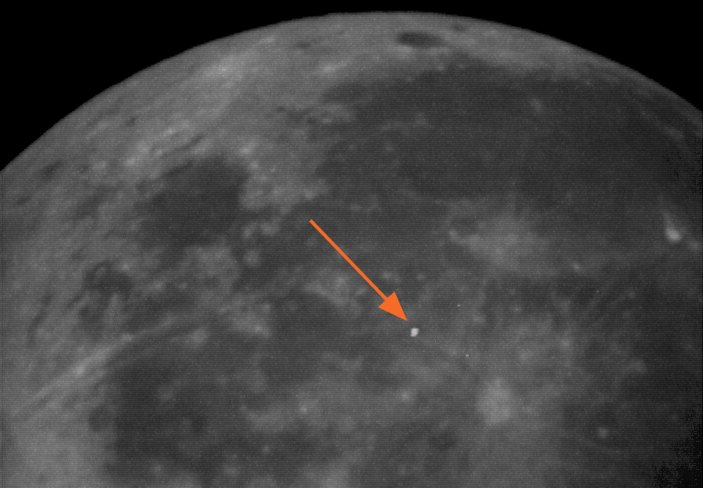
Figure 1. Lunar impact flash recorded in the framework of the ESA CARMEN project on 5 March 2022 at 19h23m16s UT, with a peak apparent magnitude of 5.
During the last decade we have performed important improvements in the systems employed to detect and analyze these flashes. Most of these advances involved the use of faster cameras with higher resolution working at different wavelengths. Here we focus on the systems employed by our team in the framework of ESA's CARMEN project, and also on two new systems deployed at the Calar Alto Observatory in Spain. One of these has been designed to perform observations in three wavelengths.
Contribution to the CARMEN project
Since 2021, and as a continuation of ESA's P3-NEO-I project, our team at IAA is member of a consortium of several astronomical observatories leaded by the companies Deimos Space and 6Roads. This consortium is conducting ESA's project “Consolidating Activities Regarding Moon, Earth and NEOs (CARMEN)”. and are one of the groups responsible for the work package (WP) dedicated to the detection and analysis of lunar impact flashes. One of the aims of this WP is the quantification of the flux of interplanetary matter that impacts our planet. For this purpose we have employed several telescopes located at two observatories in the south of Spain: La Sagra, and Sevilla. We are employing CMOS cameras with a maximum frame rate of 168 fps at full resolution (1920x1200 pixels). Figure 1 shows a sample lunar impact flash recorded with one of these devices in the framework of CARMEN.
New systems at Calar Alto
Our team has deployed a new telescope at the Calar Alto Observatory (Spain) and one of its goals is to observe lunar impact flashes. This instrument, which has an aperture of 60 cm, was initially intended to employ a system consisting of high-speed CMOS cameras (with a frame rate of 300 fps) to observe, simultaneously, at three different wavelengths (I, V and R). The telescope, which has been founded by the Spanish Ministry for Science and Innovation, is located within a dedicated 4-m automated dome. Figure 2 shows an image of this new instrument, which can be controlled remotely. However, it was finally decided to attach this 3-channel system to the 1,25m telescope located at that observatory. The 60-cm telescope would employ a single CMOS camera instead. Both systems are expected to enter operation in 2022, and would imply an important step for the analysis of the collision of meteoroids with the lunar ground.
Figure 2. The new 60 cm telescope deployed at the Calar Alto Observatory.
References
[1] Ortiz, J.L. et al., J., 1999. A search for meteoritic flashes on the Moon. Astron. Astrophys. 343, L57–L60.
[2] J.L. Ortiz, et al., 2000, Optical detection of meteoroidal impacts on the Moon. Nature 405, 921–923.
[3] Madiedo J. M., Ortiz J. L., Yanagisawa M., Aceituno J. and Aceituno F. (2019b). "Impact flashes of meteoroids on the Moon". Meteoroids: Sources of Meteors on Earth and Beyond, Ryabova G. O., Asher D. J., and Campbell-Brown M. D. (eds.), Cambridge, UK. Cambridge University Press, ISBN 9781108426718, 2019, p. 136-158
How to cite: Madiedo, J. M., Ortiz, J. L., and Morales, N.: Lunar impact flashes: observations in the framework of the ESA CARMEN project and development of new monitoring systems, Europlanet Science Congress 2022, Granada, Spain, 18–23 Sep 2022, EPSC2022-648, https://doi.org/10.5194/epsc2022-648, 2022.
Introduction
A lunar impact flash (LIF) is a rapid burst of light caused by a hypervelocity impactor hitting the moon, releasing a fraction of its energy as light. They are observable though moderately sized (0.4m) telescopes, and are therefore observable by both amateur and professional astronomers.
LIF observations are typically performed in visible or NIR, and can only take place when the lunar phase is between 10-50%, during local night, and are only observable against the lunar night-side; the most commonly observed LIFs are faint, approximately MagI = 9, MagR = 10 [1], making them indistinguishable against the illuminated lunar background. This limits potential observations of LIFs to ~30h per month on average, with weather limiting this further.
In order to increase the average number of observable hours that LIF observations can be made, and thereby increase the number of observed LIFs, we have developed new techniques to perform LIF observations at all local times, and all lunar illuminations. This technique theoretically only requires clear weather and a visible moon.
Theory
LIFs have been shown to behave as black bodies, releasing energy according to Planck's law [2]. The temperature of LIFs observed by NELIOTA is between 1300-5800 k, with average temperature, Tavg = 2800k [3]. This average has peak wavelength of λpeak = 1.035 μm. The illuminated portion of the lunar surface is reflecting light from the sun (T = 5778 k, λpeak = 0.5 μm). In R-band and I-band, the ratio of energy radiated by the sun is greater by a factor of 57 in R-band, and 28 in I-band. My observing in wavelengths closer to the λpeak of the flash, we can improve this ratio greatly.
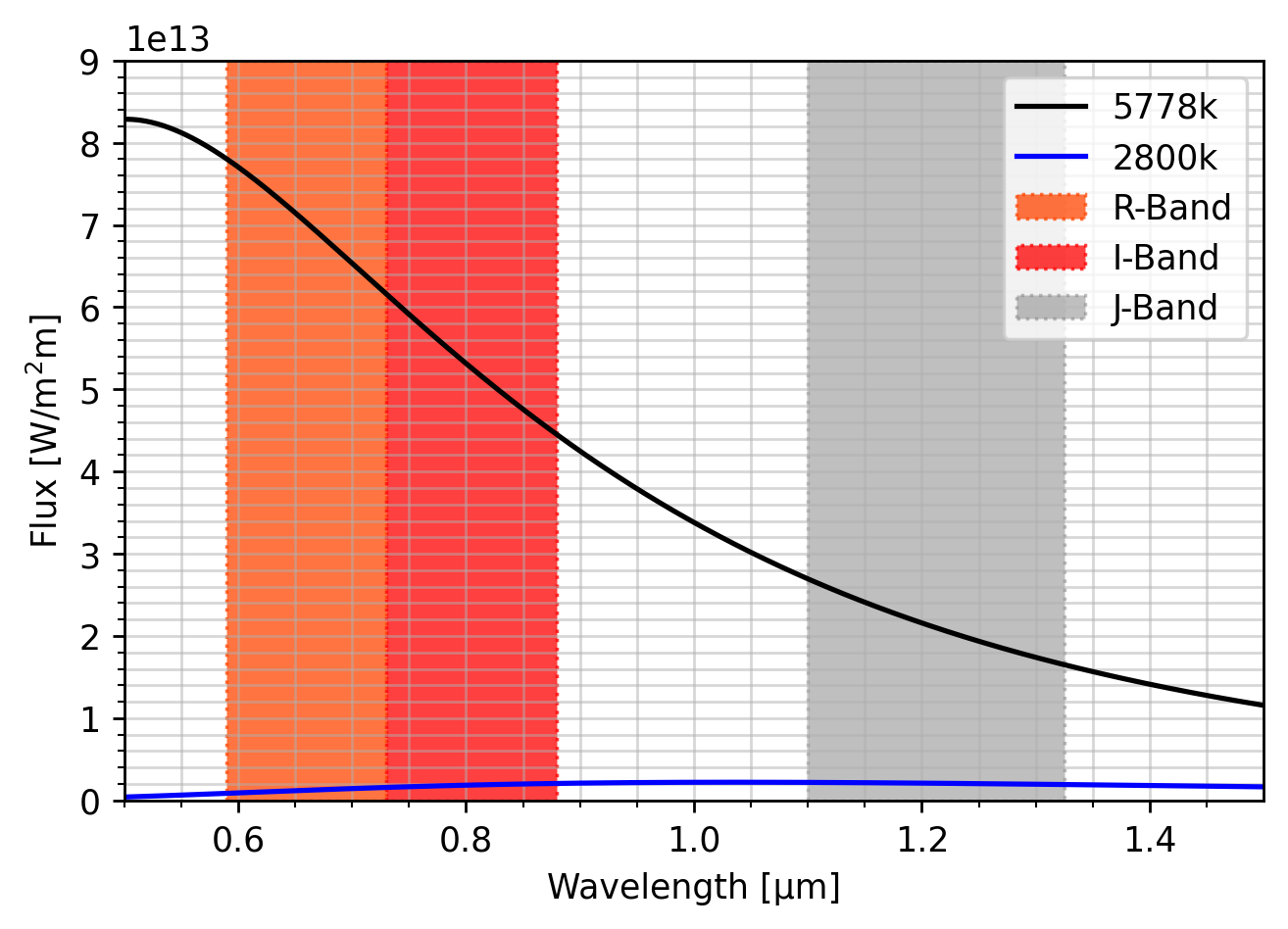
Figure 1:The Planck curve for the sun (5778k) and the average LIF (2750k), R, I, and J-band regions are highlighted in orange, red, and grey respectively.
As illustrated in Fig. 1, by observing in J-band the irradiance of the sun is lowered, being only 10 times greater than the 2800 k LIF. This effective dimming of the background leads to an increase in the signal-to-noise ratio (S/N) of the LIF against the sun-illuminated background.
The S/N ratio is a measure of how detectable a signal is above the background, and can be defined as:
S/N = S" / (σ × √Apix)
Where S" is the total count of the signal, σB is the standard deviation of the background, and Apix is the area of the background measurement. A S/N ratio above ≈10 is generally required for a signal to be considered detectable.
Observations
Observations were performed on 2022-02-23 from the Observatoire de la Côte d'Azur, using a 0.5 m diameter, 2 m focal length telescope with Ninox 640 II camera and J-band filter attached. For the first set of observations, high gain mode was used, for the second set of observations low gain mode was used. A 30 μm exposure time was used for both sets of observations.
The star HD137463 was observed, which has MagJ = 5.423, obtained by Simbad [4] Observations began during the night, and continued until after sunrise in order to measure the brightness of the sky during daytime.
By performing A-B subtraction to remove the dark current and background of the observed frames, as shown in Fig. 2, a pixel count for the clean star signal, S", can be obtained. As it is constant, an average for the star signal can be used as ground truth in order to calculate the S/N ratio for the daytime sky brightness, as well as the illuminated lunar surface.
Figure 2: The A-B subtraction of two observations of HD137463. The subtraction removes any dark current or background to leave only a clean positive and negative signal.
Results
The S/N ratio for the a MagJ = 5.423 star are shown in Fig. 3. A sharp decrease in S/N ratio is observed as air-glow begins around solar altitude = -5. The S/N continues to decrease, slowly levelling off around S/N = 15 as the sun reaches solar altitude = 5. This puts the magJ = 5.423 star well above the detectable threshold, and would correspond to a MagR = 6.7 LIF.
Figure 3: Left: The S/N ratio in high gain mode, of HD137463 against the sky background between solar altitudes -10 & -1. Right: The S/N ratio in low gain mode, of HD137463 against the sky background between solar altitudes -1 & -5.
By taking measurements of the lunar background brightness, we can verify the S/N ratio we would expect from these LIF when observed on the lunar surface. Table 1 contains the results from count-averaged observations of the background, and the S/N of the MagJ star if observed against the background, emulating a flash. Again, even against the illuminated bright limb, the S/N ratio is above the detectable threshold, and shows that with this system, we would be able to detect LIFs of MagJ ≥ 5.423, with the possibility of even fainter magnitudes under more favourable conditions.
Table 1: The S/N ratio of the reference star used against different regions on the lunar surface, from darkest to brightest.
| Region | S/N |
| Lunar Night Side | 147 |
| Terminator | 42 |
| Lunar Day Side | 21 |
| Lunar Bright Limb | 19 |
References
[1] Liakos et al (2019) A&A, 633, 29 pp.
[2] Eichhorn (1975) P&SS, 23, 11, 1519-1525
[3] Avdellidou & Vaubaillon (2019) MNRAS, 484, 5212-5222
[4] Wegner et al (2000) A&A, 143, p.9-22
How to cite: Sheward, D., Delbo, M., Avdellidou, C., Cook, A., and Lognonne, P.: J-Band Measurements for All-Hours Lunar Impact Flash Observations, Europlanet Science Congress 2022, Granada, Spain, 18–23 Sep 2022, EPSC2022-1077, https://doi.org/10.5194/epsc2022-1077, 2022.
1. Introduction
Previous studies of resurge sediments from several marine-target impact craters indicate a relationship between the sedimentology, , the target water depth, H, and the magnitude of the event, d. This offers a valuable opportunity to obtain one of these variables if the other two are known. However, the mechanisms controlling this relationship have not been unraveled yet. During the cratering process fragments from the solid target are mixed with the seawater and, after an initial turbulent phase, they get deposited inside the seafloor crater when filled up by the resurging water. We present a mathematical model for the aquatic settling process of the resurge material as a feasible explanation for the observational data.
2. Methods
2.1. Fractal model for particle settling
The impact-related sediments considered here are formed from primary fragmented material, giving rise to a distribution of particles and aggregates that can be interpreted as a cumulative function. Thus, for the study of the particle settling a fractal model is considered [1][2].
In this study, we assume that size segregation is correlated to the concentration of the solid particles [3][4] giving rise to the different settling patterns observed in the core samples. The density and viscosity of the solid/water mixture depend on the solid concentration causing a different settling velocity of the particles. For low concentrations, velocities of coarse particles are higher and fine particles are excluded from the lower part of the sediment, while for high values of the concentration the settling of the coarse clasts become hindered by the higher concentration of fine grains in the solid/water mixture, thus reducing the packing of coarse fragments at the bottom of the sediment column.
In order to analyze the size segregation effect, Herreros and Ormö [5] proposed a fractal model in two steps, considering the settling process of two types of particles: (1) Fine particles, s; and (2) coarse particles, p, with radius Rp > Rs, taking the settling time for the coarse particles in pure water as a time reference (tmax):
Step 1: Settling of fine particles in pure water. The suspended mass fraction of fine particles, s, in pure water is calculated. At this step, the settling of the fine particles is considered independent on the solid/water concentrations.
Step 2: Settling of coarse particles in a solid/water mixture. In this case, the coarse particles, p, are assumed to be immersed in a fluid mixture whose viscosity and density are both functions of the volumetric concentrations.
According to [5], the number of settled coarse particles per unit length, i.e. the mean clast frequency , can be approximated by:
where Rm is the average size of the coarse particles and lds and ldp are the heights of an equivalent cylindrical volume of deposited mass.
2.2. Application to marine impacts
After a meteorite impact, the transient crater diameter, Dt, can be related to the impactor diameter, d [6]. Considering the height of excavated material [7], Hexc = Dt/10, as a solid/water mixture column, HT = Hexc = Hs+Hw, the impactor diameter, d, can be expressed as:
where standard values for impactor’s velocity, density and impact angle have been considered [8][9]:
2.3. Mass excess
The effect of the relative fraction of external mass apported to the system, δ, of different origin to the target fragmentation, can be evaluated by just considering the new values for the volumetric concentrations:
which involves an increase in the concentration of solids.
3. Results
As shown in [5], it is possible to represent as a function of d/Hw (in the following just d/H) since both are functions of the solid/water concentrations.
As a result, we obtain a family of curves depending on two parameters: the suspended mass of solid material when all the particles with r > Rp have been settled (i.e. t= tmax), and the excess of solid material apported to the system (Figure 1).
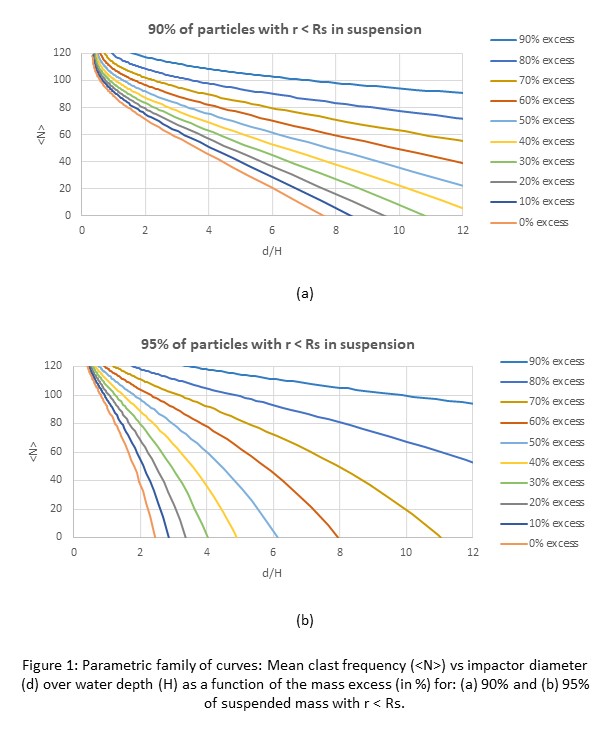
4. Discussion
In order to understand the physics behind the relationship observed in [10], the proposed model has been applied. Figure 2 shows the model results along with the nine drill cores extracted from seven natural impact craters.
The presented model allows the physical interpretation of the observational data, providing a better understanding of the settling conditions. According to the model, the lower position curve (orange curve) represents stable settling conditions, closer to slack-water along with a null excess of mobilized material. This ideal situation, predicted by the model, is compatible with the position and characteristics of the related drill cores. However, the cases laying on the high position curve (blue curve) are those mobilizing a larger amount of solid material and with a higher depositional time for the finest particles, probably related to turbulent flow conditions during the settling process [10].
5. Conclusions
A fractal model for the study of size segregation and particle settling after an impact event in a marine target is presented. The model explains the observed tendency for nine cores obtained from seven natural impact craters, shedding light on the physical processes behind the observations.
Acknowledgements
The authors would like to gratefully acknowledge CSIC financial support for i-LINK project LINKA20203 and to the AEI for project MDM-2017-0737.
References
[1] Filgueira et al., Soil Sci. Soc. Am. J. 67, 1703–1706, 2003.
[2] Filgueira et al., Geoderma 134, 327–334, 2006.
[3] Snabre et al., Rheol Acta 48, 855–870, 2009.
[4] Spearman and Manning, Ocean Dynamics 67, 465–483, 2017.
[5] Herreros and Ormö, EPSC2020-931, 2020.
[6] Johnson et al., Icarus 271, 350–359, 2016.
[7] Melosh, Impact Cratering: A Geologic Process. Oxford University Press Inc, USA, 1989.
[8] Shoemaker, San Diego: Academic Press, 283–359, 1962.
[9] Shoemaker, New York: Pergamon Press, 617–628, 1977.
[10] Ormö et al., Earth and Planetary Science Letters, Vol. 564, 116915, 2021.
How to cite: Herreros, I. and Ormö, J.: Magnitude of marine impacts: Size segregation patterns as an observational assessment., Europlanet Science Congress 2022, Granada, Spain, 18–23 Sep 2022, EPSC2022-41, https://doi.org/10.5194/epsc2022-41, 2022.
INTRODUCTION
The Tabernas Basin (Betic Cordillera) is filled with Neogene, Pliocene and Pleistocene sediments, discordant on a metamorphic basement (Fig. 1). During the Tortonian sedimentation an up to 70 m thick bed of breccia (the Gordo Megabed) was deposited. It consists of up to several tens of meters large, rotated sedimentary megablocks frequently capped and/or surrounded by a polymict breccia of mainly up to m-sized clasts of the crystalline (schist) basement. Previous workers have suggested the bed to be a seismite. The polymict composition of the studied breccias intercalated within the otherwise shallow-marine sediments, the presence of megablocks, plastically deformed megablocks and shock metamorphic features in quartzs of polymict breccias have led us to the description and reinterpretation of sediments and geomorphological features in the Tabernas Basin that could be related to an impact structure.
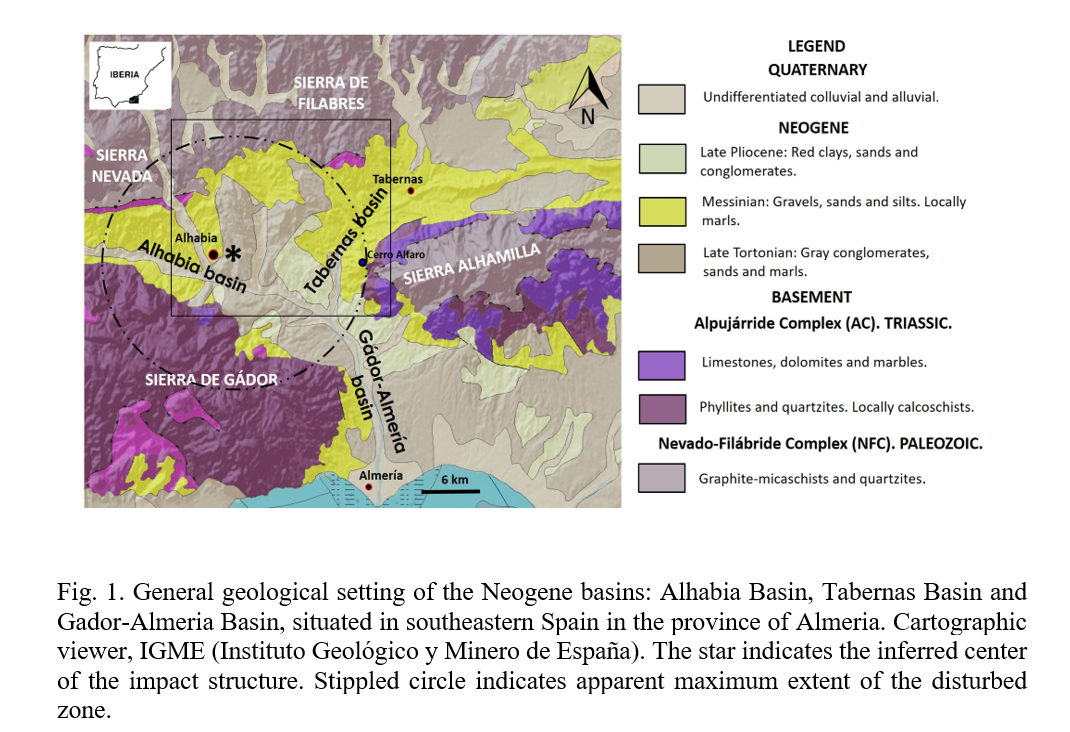
MATERIALS AND METHODS
Multiple field studies were carried out over the course of several years to study the geology and geomorphology of the Tabernas Basin and its surroundings with special focus on the Gordo Megabed. These studies were carried out in conjunction with geological mapping and the measurement of parameters of the observed geological structures.
Thin sections (97 in total) from the different lithologies and locations were prepared and studied for shock metamorphic features under an optical microscope. Quartz grains displaying planar features were studied using the techniques described in Stöffler and Langenhorst (1994) and Ferrière et al. (2009).
RESULTS
Megablocks
We define megablocks as coherent rock blocks that are tilted or rotated, lithologically homogeneous, and that extend in outcrops over at least 30 meters (i.e. having dimensions of several tens of meters).
The material of the megablocks is often made up of sets of turbidites belonging to the Gordo Megabed and three zones have been identified and mapped:
- Zone 1: Central part of the Neogene basin of Tabernas (Rambla de Tabernas).
- Zone 2: Borders to zone 1 to the east and features such as Cerro Alfaro.
- Zone 3: Neogene basin of Alhabia, on the northern flanks of Sierra de Gador.
Plastically Deformed Megablocks
Only three outcrops of these structures SB1, SB2 and SB3 (Fig. 2). They involve recumbent folds with reverse limb whose fold axes follow the direction: N25E, N275E and N210E. They represent plastic internal deformation of the within the slump unit mobilized stacks of Late Tortonian turbiditic marl and sandstones beds, inclined to the NE, W and SW and their directions do not match the main tectonic structures that formed these Neogene basins E-W to NE-SW (Martínez et al., 2017).
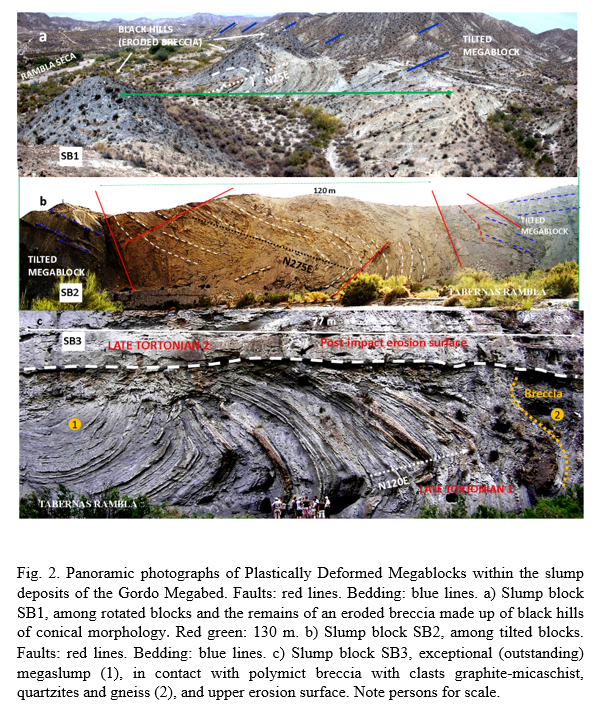
Polymict breccias
Most of the polymict breccias studied (28 in total) are located at the Rambla de Tabernas and present a single lithostratigraphic, mainly graphite-micaschist, quartzite and gneiss, as well as brecciated dolomite. These breccias are massives, unstratified, clast supported and lacks visible sedimentary structures. The angular shape of the fragments indicates short transport, but the basement clast lithologies of the breccia originates far from the present locations.
Breccia 29 is in an anomalous stratigraphic position on Triassic phyllites in Sierra Alhamilla. This is a variable 10-50 cm thick deposit of Neogene material (loams, sands and limestones).
Breccia 30 (sample 2) is located in Sierra de Gádor and constitutes an intermixture of different materials, from both the metamorphic substrate and the Neogene sedimentary sequence.
These features in both breccias could be compatible with a proximal ejecta layer and may clearly be identified by the presence of shock-metamorphic features (Osinski et al., 2013).
Shock-metamorphic features
The systematic search for quartz grains with shock metamorphic features in breccias, resulted in six quartz grains, five grains displaying one set of planar features and one grain with two sets. The features are straight, parallel, sets of planes with a typical spacing between each plane of 1-5 μm. The planar features penetrate the entire grain in four cases, and in two cases they were only visible near the grain boundary in part of the host grain. The features are generally fresh, but occasionally decorated, i.e., lined by minute fluid inclusions (Fig. 3).
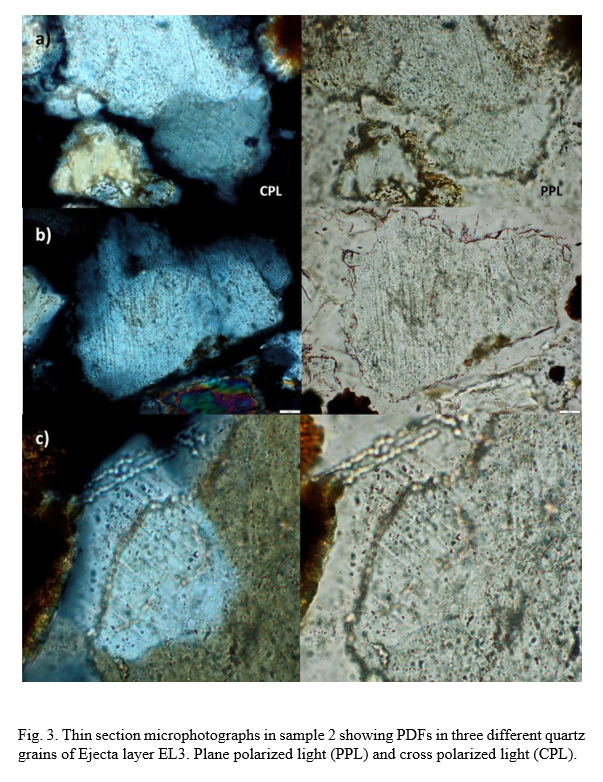
Nevertheless, in light of the indicative, albeit not affirmative, presence of a shocked quartz grains in what we find as analogous lithologies to known impactites based on their composition, appearance, stratigraphic position and geographical distribution, as well as the other sedimentological, stratigraphic, petrographic and geomorphological observations, lead us to propose the existence of a possible impact crater in the Tabernas Basin of Almeria. In our model, the crater is still to large parts preserved, but covered by post-impact materials, which only leaves an already heavily eroded part of the structure visible on the eastern edge.
CONCLUSIONS
A comparison with established impact craters showing similar geological features suggests that the Tabernas Basin still holds a well-preserved, concentric impact structure with a mainly buried, 8-km wide nested crater in the basement surrounded by a 22-km wide, outer crater formed by extensive gravitative collapse of a tens of meters thick, upper target layer of semi-consolidated sedimentary strata, likely in a shallow aquatic paleoenvironment.
REFERENCES
Ferrière, L., Morrow, J. R., Amgaa, T. Koeberl, C. 2009. MAPS 44:925–940.
Martínez, M., Galindo, J., Martínez, F. J. 2017. International Journal of Earth Sciences 106 (7), 2461-2471.
Osinski, G. R., Grieve, R. A. F., Tornabane, L. L. 2013. In Impact Cratering: Processes and Products. Osinski G. R. and Pierazzo E. Eds. Wiley-Blackwell Publishing.
Stöffler, D., Langenhorst, F. 1994. Meteoritics 29(2):155–181
How to cite: Sánchez Garrido, J. A., Ormö, J. O., Alwmark, C., Alwmark, S., Zachen, G., Lilljequist, R., and Sánchez Gómez, S. T.: A probable impact structure in Betic Cordillera, Almeria, SE Spain, Europlanet Science Congress 2022, Granada, Spain, 18–23 Sep 2022, EPSC2022-217, https://doi.org/10.5194/epsc2022-217, 2022.
Introduction: The dating of geological surfaces on the Moon is crucial for understanding its geological history and evolution. The measurement of Crater Size-Frequency Distributions (CSFDs) can be used for determining relative and absolute ages of surfaces. Older surfaces reflect more and larger craters than younger geological units [1-4]. To determine the relative surface ages, a production function (PF) is constructed to which the CSFD is fitted. One frequently used PF was empirically-derived by measuring craters on reference surfaces using Apollo era data (Neukum, 1983 [1]), which was revised in 2001 [5], and is valid for crater diameters of 10 m - 300 km and 10 m - 100 km, respectively. With increased image resolution of more recent missions [e.g., 6], it has been possible to measure CSFDs for crater diameters down to a few meters. Therefore, it would be beneficial to be able to extend the PF to smaller crater diameters, which would allow the determination of relative and absolute ages for young/small geological units.
A crucial influence on small craters formed in the strength regime are target properties, which has been investigated in several studies [e.g., 7, 8, 9]. Therefore, we aim to perform the crater counts exclusively on continuous ejecta blankets. Secondary craters [e.g., 10-12] influence the CSFD as well and can contaminate the count area, causing a steeper CSFD-slope [e.g., 10, 13, 14]. To avoid this effect and obtain the cleanest PF possible, we selected ejecta areas derived from young Copernican-aged craters. This minimizes the number of field secondary craters on the ejecta and also avoides major degradation of the small craters [15, 16]. However, the identification of self-secondary craters remains problematic, since they occur irregularly distributed on the ejecta blankets and often have morphologies similar to primary craters [e.g., 12, 13].
Method: We used Lunar Reconnaissance Orbiter Narrow Angle Camera (NAC) images [6] including M180509194LE, M1122929850LE and M103831840LE/RE at Giordano Bruno (GB), M1107052575RE and M1112971104RE at Moore F, M129187331LE/RE at North Ray (NR), M119754107RE at South Ray (SR) and M114064206LE at Cone. The resolutions vary between 1.6 m/px and 0.5 m/px, the incidence angles are from 54° to 78°. The CSFDs were measured in ArcGIS with the CraterTools add-in of [18] and displayed in CraterStats with pseudo-log binning [19].
Two areas were investigated at Cone, three at GB, Moore F and SR, respectively. Four areas were investigated by [17] at NR. The selected counting areas are all on the ejecta blakets of the named craters.
Results: Similar to [17] we combined the statistics from the separate count areas into one file and display these CSFDs in a cumulative plot in Figure 1.

Figure 1: Display of the combined CSFDs at GB (green), Moore F (blue), NR (violet), SR (red) and Cone (orange), respectively. The vertical lines of individual data points represent the error bars.
The comparison between the individual CSFD-slopes at GB, Moore F, NR, SR and Cone generally show slightly steeper slopes than the nominal -3 slope of [1] for crater diameters between 10 m and 23 m (in our case 20 m, see Table 1).
Table 1: Display of the considered crater diameter range and the respective CSFD-slopes.
Discussion: We found that the CSFD-slopes on the ejecta blakets of the investigated craters show a tendency regarding the crater diameter. Considering only diameters ≤10 m the slope is marginally shallower than Neukum’s [1] -3 slope, except at GB, which might be explained through secondary cratering. This trend was also observed by [15] (and references therein) and [20] who investigated NR, Cone, Copernicus and Tycho. This might suggest that CSFDs of young Copernican craters have actually a slightly shallower slope at smaller crater diameters. Another possible explanation is the faster degradation of smaller craters [e.g., 21]. Further effects might be the coverage of ejecta material of nearby craters; NR (52.3 Ma [20]), might be influenced by the ejecta of SR (2 Ma [22]), SR by Baby Ray. Moreover, larger craters in two areas at NR and Cone probably penetrated through the ejecta blanket, which can lead to mixed target propertie effects.
Further investigations are required to quantify the effects of secondary cratering, target properties, crater degradation or impactor flux on the determination of our CSFDs. Additional investigation is necessary to determine at which crater diameter the slope becomes shallower or if a transition zone is present.
Acknowledgments: This Project is funded by the Deutsche Forschungsgemeinschaft (DFG, German Research Foundation) – Project-ID 263649064 – TRR 170.
References: [1] Neukum (1983), NASA TM-77558. [2] Öpik (1960), RAS 120(5), 404-41. [3] Shoemaker et al. (1970), Science, 167 (3918), 452-455. [4] Baldwin (1971), Icarus, 14, 36-52. [5] Neukum et al. (2001), Space Sci. Rev., 96, 55. [6] Robinson et al. (2010), Space Sci. Rev. 150, 81-124. [7] van der Bogert et al. (2010), LPSC 41, #2165. [8] Wünnemann et al. (2011), Proceedings of the 11th hypervelocity impact symposium., Vol. 20. [9] van der Bogert et al. (2017), Icarus, 298, 49-63. [10] McEwen and Bierhaus (2006), Annu. Rev. Earth Planet. Sci. 34, 535-567. [11] Xiao and Strom (2012), Icarus 220, 254. [12] Zanetti et al. (2017), Icarus 298, 64-77. [13] Plescia et al. (2010), LPSC 41, #2038. [14] Plescia and Robinson (2011), LPSC 42, #1839. [15] Moore et al. (1980), Moon and Planets, 23, 231-252. [16] Fassett and Thomson. Journal of Geophysical Research: Planets 119.10, 2255-2271. [17] Hiesinger et al. (2012), JGR 117, E00H10. [18] Kneissl et al. (2011), PSS 59, 1243-1254. [19] Michael et al. (2016), Icarus 277, 279-285. [20] Williams et al. (2014), Icarus 235, 23-36. [21] Mahanti et al. (2018), Icarus, 299, 475-501. [22] Stöffler and Ryder (2001), Space Sci. Rev., 96, 9-54.
How to cite: Oetting, A., Hiesinger, H., and van der Bogert, C.: Refinement of the Lunar Production Function - The CSFD-Slope of Small Crater Diameters on Ejecta Blankets, Europlanet Science Congress 2022, Granada, Spain, 18–23 Sep 2022, EPSC2022-828, https://doi.org/10.5194/epsc2022-828, 2022.
Please decide on your access
Please use the buttons below to download the presentation materials or to visit the external website where the presentation is linked. Regarding the external link, please note that Copernicus Meetings cannot accept any liability for the content and the website you will visit.
Forward to presentation link
You are going to open an external link to the presentation as indicated by the authors. Copernicus Meetings cannot accept any liability for the content and the website you will visit.
We are sorry, but presentations are only available for users who registered for the conference. Thank you.
Please decide on your access
Please use the buttons below to download the presentation materials or to visit the external website where the presentation is linked. Regarding the external link, please note that Copernicus Meetings cannot accept any liability for the content and the website you will visit.
Forward to session asset
You are going to open an external link to the asset as indicated by the session. Copernicus Meetings cannot accept any liability for the content and the website you will visit.
We are sorry, but presentations are only available for users who registered for the conference. Thank you.


